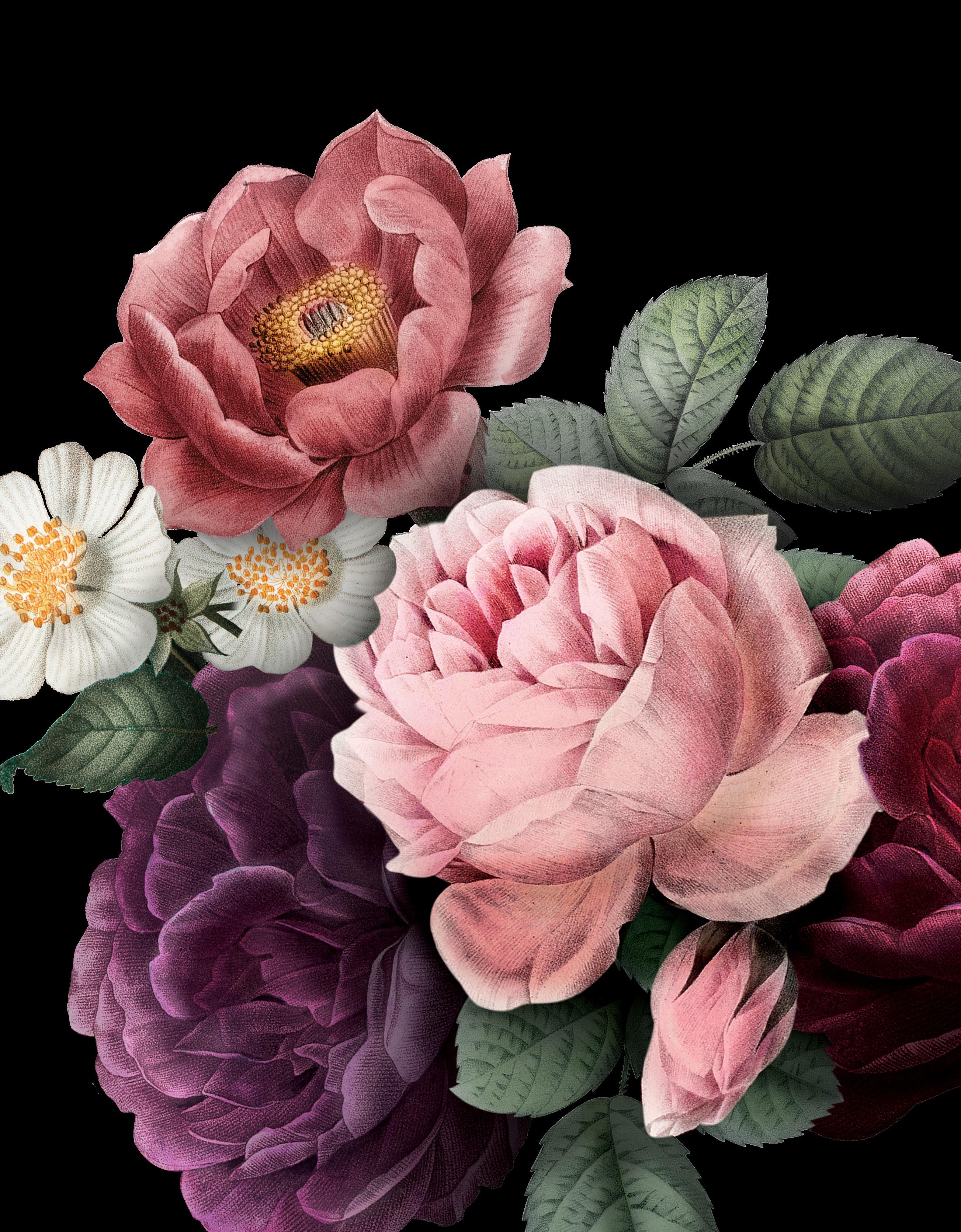
YEARS OF COLOR 1921-2021
QUARTERLY PUBLICATION OF THE ORIGINAL LOS ANGELES FLOWER MARKET OF AMERICAN FLORISTS EXCHANGE, LTD.
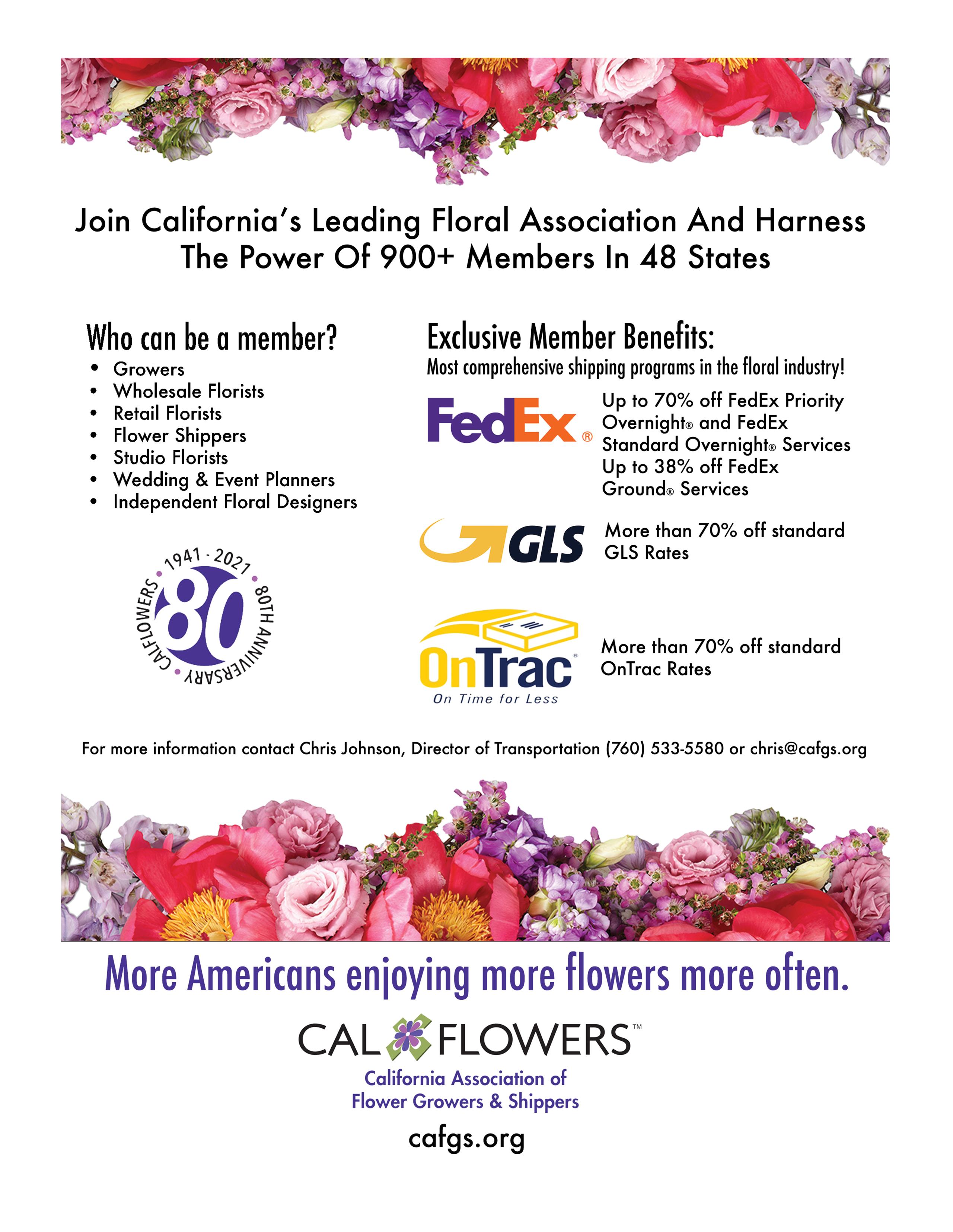
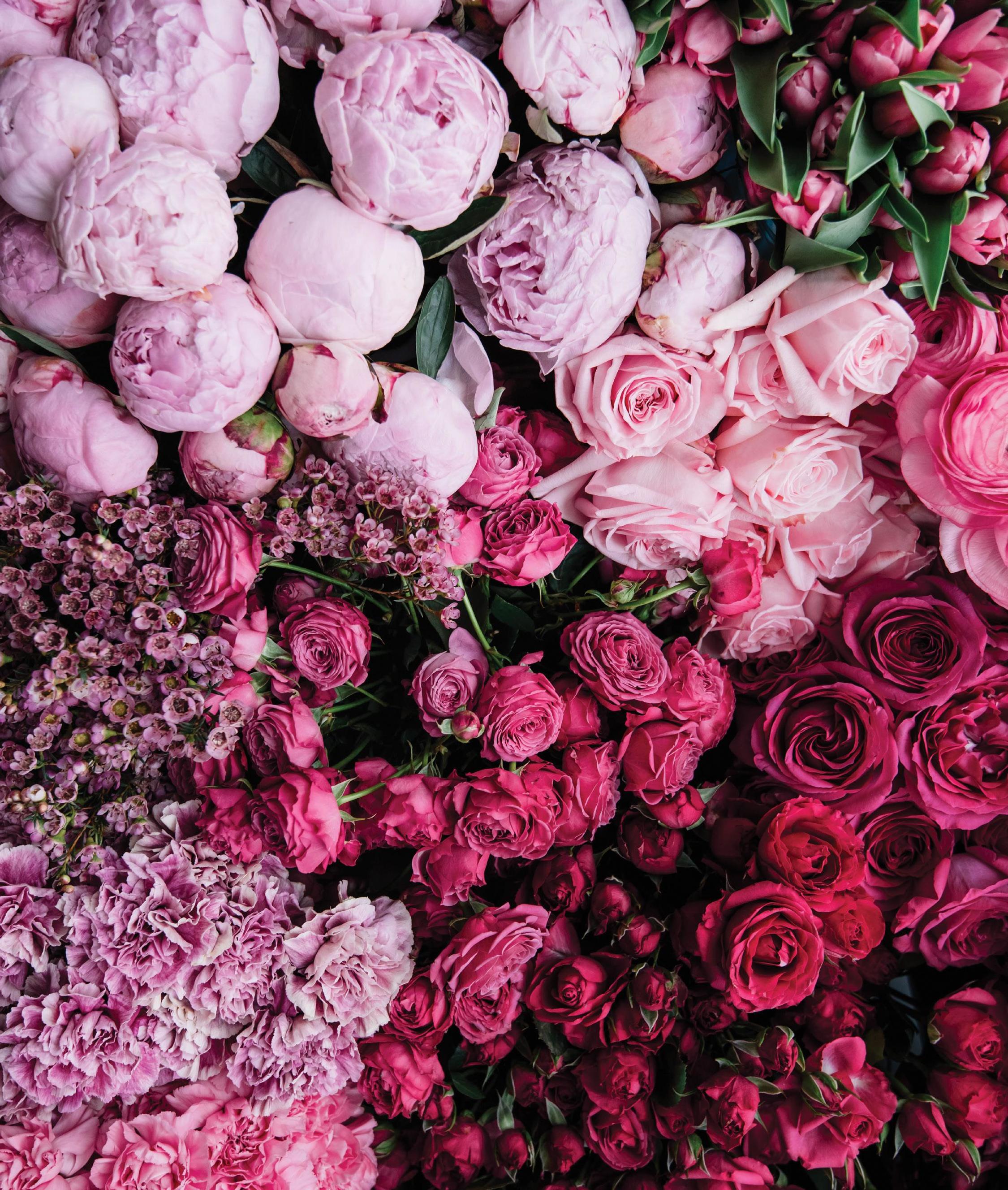
3 The Bloomin’ News
08 Friends, Farmers, & Florists 10 1920s 18 100 Years of Color Photo Montage 30 2010-2020
TABLE Conte nts of
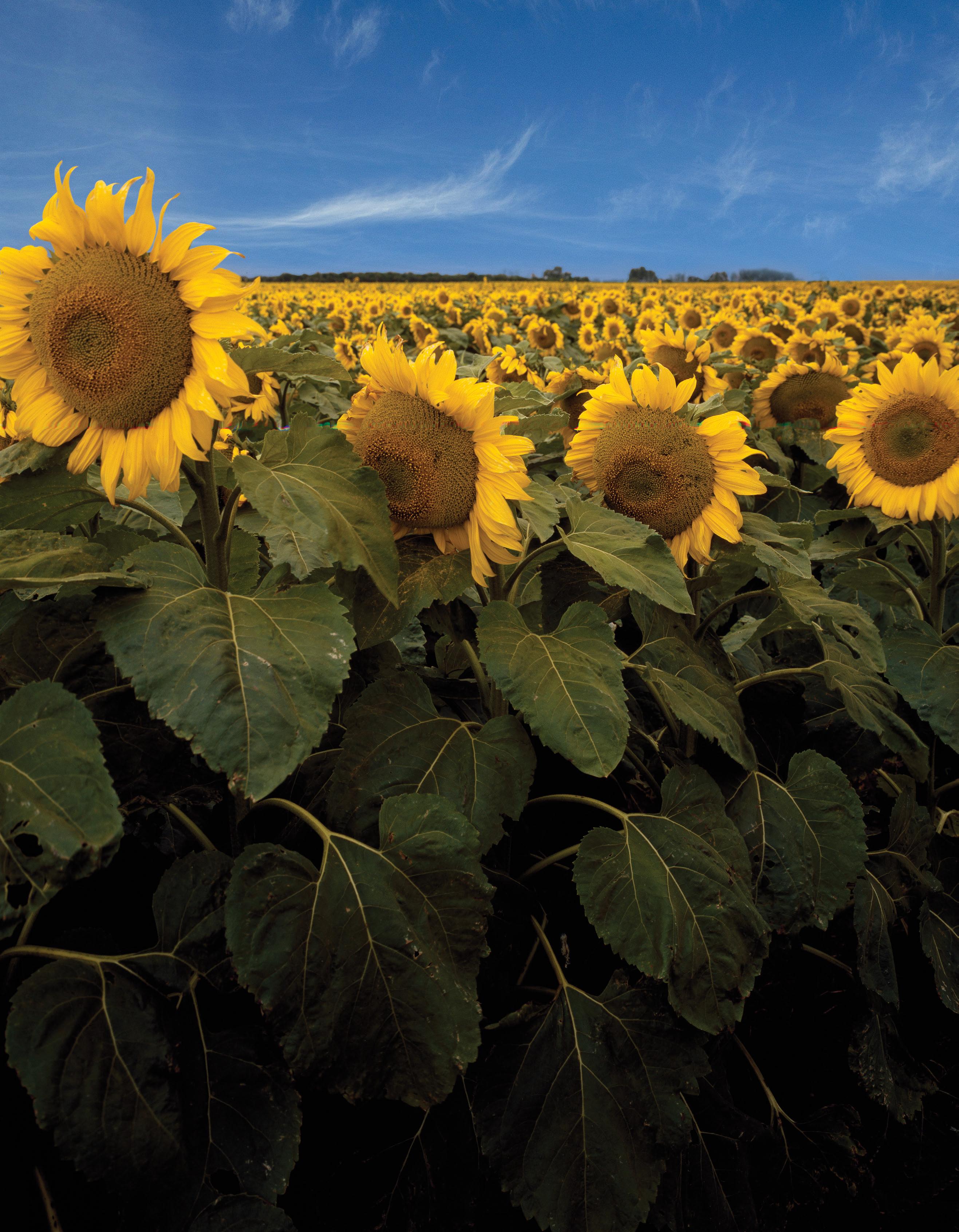
The IMW Agency would like to thank all of its clients for their openness to change and creativity in seizing opportunities during this year. Working together we have pivoted to generate campaigns that have built brand and demand.
Time To Grow Your Business?
Give us a call. We can make a real difference in this time of change.

GROWING
Branding | Advertising | Public Relations | Media Buying | Web Services imwagency.com
BUSINESS FOR THOSE WHO VALUE GROWTH
| 714.557.7100 ext 2370

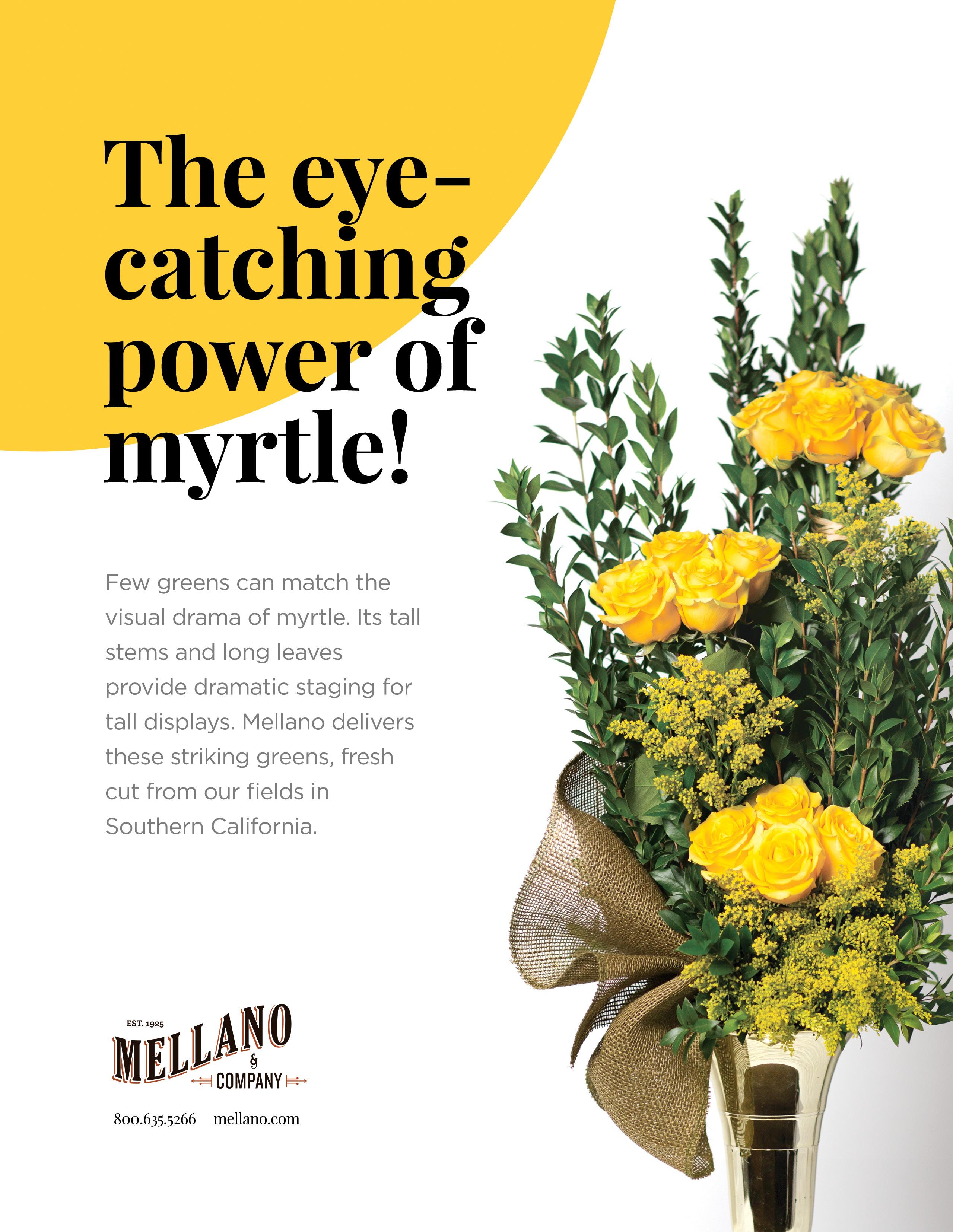



Christine Duke Lizbeth A. Ecke
Jim Mellano
Jon Prechtl
John Williams
Liz Wilkins
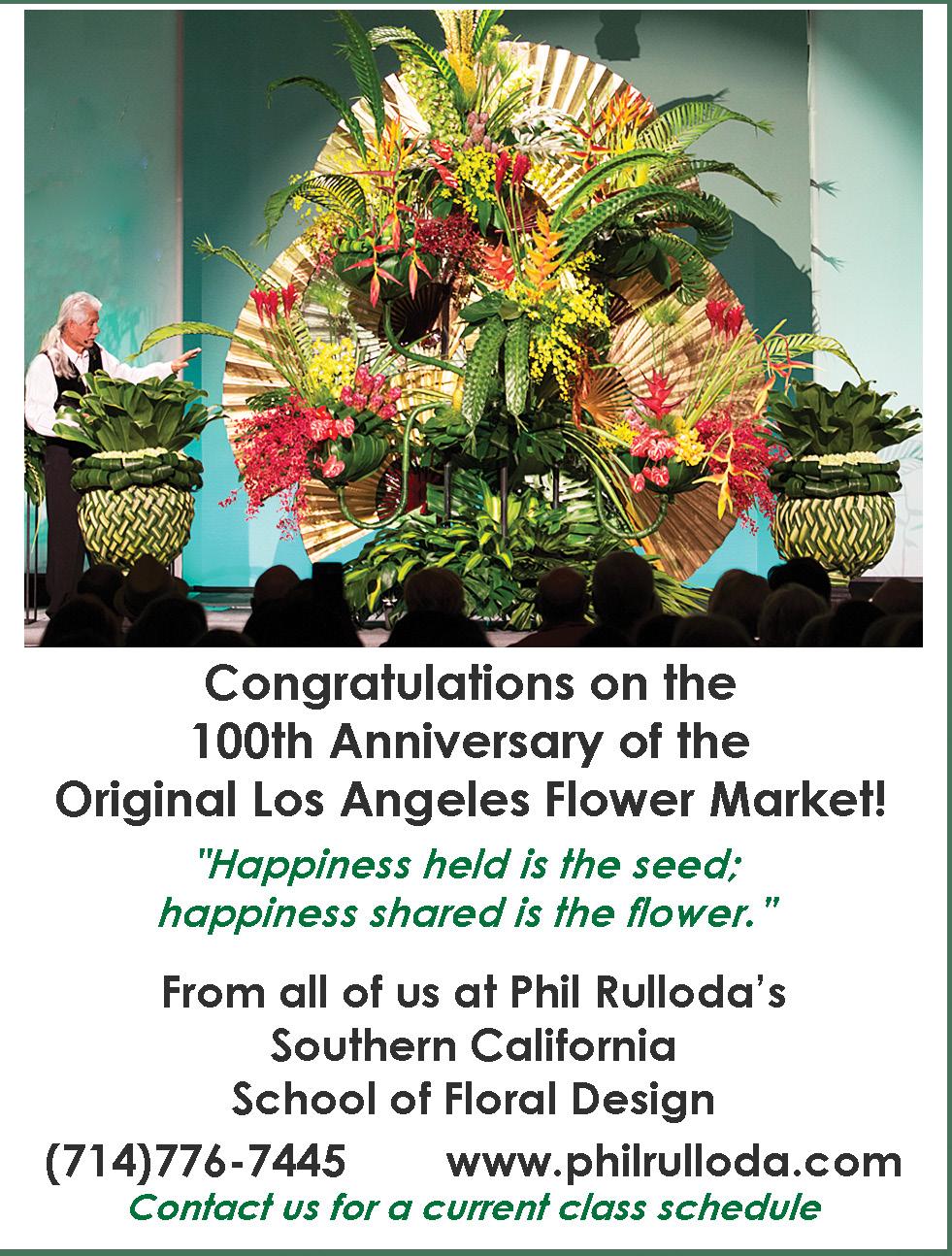
pm | 213.627.3696
SUBSCRIBE
Sign up here to stay in touch & receive a link to the quarterly digital issue!
DISCLAIMER
Neither the Bloomin’ News nor the Original Los Angeles Flower Market recommends or endorses any products or advertisements displayed in this publication but presents them as a service to our readers. ADVERTISE
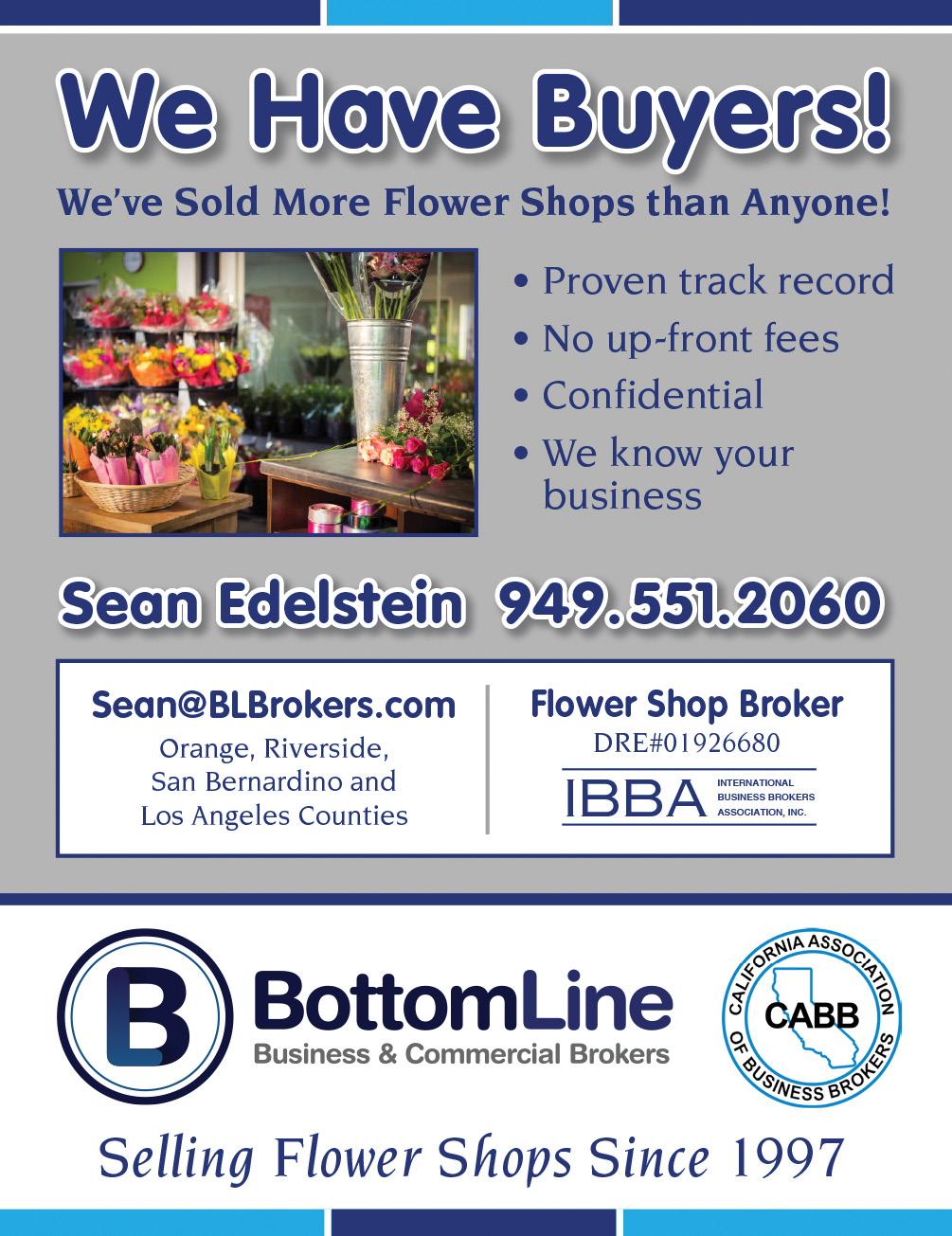
7 The Bloomin’ News
is
The Los
Location
Market
This news magazine
published quarterly (January, April, July, October) by
Angeles Flower Market of The American Florists’ Exchange, Ltd.
754 Wall Street, Los Angeles, CA 90014 PUBLISHER The Original Los Angeles Flower Market of the American Florists’ Exchange Special Holiday Hours, maps, tenants, seasonal flowers and more available at originallaflowermarket.com
Information 213.622.1966 Market Manager/Mellano 213.622.0796 BOARD OF DIRECTORS American Florists’ Exchange, Ltd. Los Angeles Flower Market
Paul Ecke III CONTRIBUTING WRITER
EDITORIAL
AND ADVERTISING Stephanie Barba | IMW Agency 3190 Airport Loop Dr., Bldg. K, Costa Mesa, CA 92626 714.557.7100 | stephanie@imwagency.com | imwagency.com Peggi Ridgway | Wordpix Editorial Solutions ART DIRECTION Colin Grey Voigt | colingreyvoigt.com LAFD ASSOCIATION MEMBER BADGE PROGRAM Frank Reyes 766 Wall Street, Los Angeles, CA 90014 laflowerdistrict.com Monday - Saturday, 6 am to 2
IN BLOOMIN’ NEWS
details. Advertise in color.
design
INDEX TO ADVERTISERS BottomLine Brokers, Sean Edelstein................. Page 7 CalFlowers.......................................... Page 2 Floral Supply Syndicate ..................Page 34 IMW Agency ........ ..................................Page 4 Los Angeles Flower District ..........................Page 32-33 Mayesh Wholesale Flowers Page 5 Mellano & Company............... Page 6 Original Los Angeles Flower Market............ ...................Page 9 Phil Rulloda’s Southern California School of Floral Design ....Page 7 Teleflora................. Page 35 Tournament of Roses Parade ........................................................Back Cover
Contact our editor, Stephanie Barba, for advertising rates, dimensions, and
We’ll
your first ad for free!
FRIENDS, FARMERS & Florists
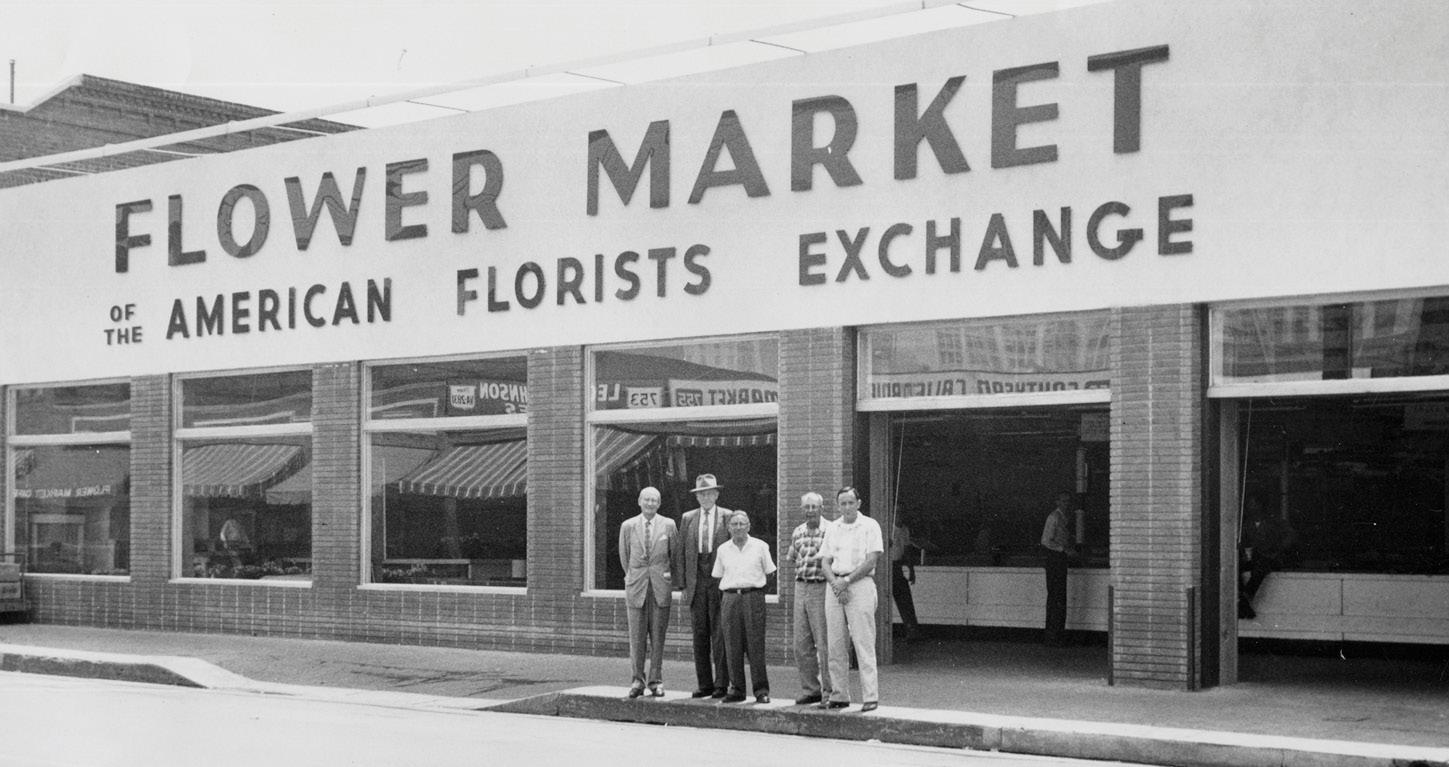
AAs we continue to work through the difficulties that 2020 presented us with and face many ongoing challenges in 2021, I thought of a wonderful quote, “I like the dreams of the future better than the history of the past.”
So, we march forward in the spirit of this time-honored sentiment from one of our American founding fathers.
To start out this year, The Board of Directors of The Original Los Angeles Flower Market of the American Florists’ Exchange are excited to celebrate the Market’s 100-year Anniversary. It is a milestone that I’m not sure our predecessors could have contemplated back in 1917 when the American Florist Exchange first organized, and then made it official on January 22, 1921 when they incorporated.
The current six-member board is made up of individuals all with a long history of involvement with the market including some who are direct descendants of the original Founding Members. As we look at where we are today, we are excited to be celebrating our past with all of you, while keeping our eyes on the present and also thinking ahead to create our best future.
We hope that all of you will help us honor everything that makes the Market so special this year and beyond. We are excited to be able to be celebrating this year as opposed to last which as we all know was a challenging year across the globe, and the Flower Market was no exception. We were completely shut down for the first two and a half months of the pandemic but were finally allowed to reopen at the end of May.
One hundred years of grit, determination and ingenuity helped pull us through and continue to be the resources we rely on as we build ourselves back while still dealing with the ongoing pandemic, but we are also looking ahead and planning for brighter days to come. Several years ago, on the roof of the Market, we built one of the largest solar
panel arrays in the City of Los Angeles providing renewable energy for years to come and help reduce the need for carbon-based fuels.
In the pages of this special commemorative 100-year Bloomin News, our writers trace the decades of growth, change, people and events that shaped our history. This work could not have been done without the help of the work by authors Peggi Ridgeway and Jan Works in their wonderful book “Selling Flowers to America.”
Much has changed from our humble beginnings at 754 Wall Street, to start we have grown substantially and now encompass almost an entire city block. When we began it was just us and the Southern California Flower Market across the street. Now we are at the center of a much-expanded flower district which includes approximately 3 city blocks. From our humble beginnings of selling just locally grown floral product to now selling cut flowers, blooming flowers and plants from around the world along with all types of addons from simple vases to ornate floral party rentals to make the most elaborate Hollywood party impressive.
As we look at 2021 and beyond, we don’t know everything the future will hold. What we do know is that we will continue to plan to do what we have done for the last 100 years and that is to celebrate 100 Years of Color through flowers with the world.
So to paraphrase the opening quote let’s “dream of a more colorful future.”
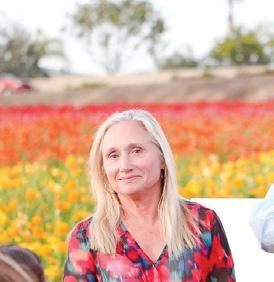 LIZBETH ECKE President, American Florists’ Exchange
LIZBETH ECKE President, American Florists’ Exchange
The Bloomin' News 8
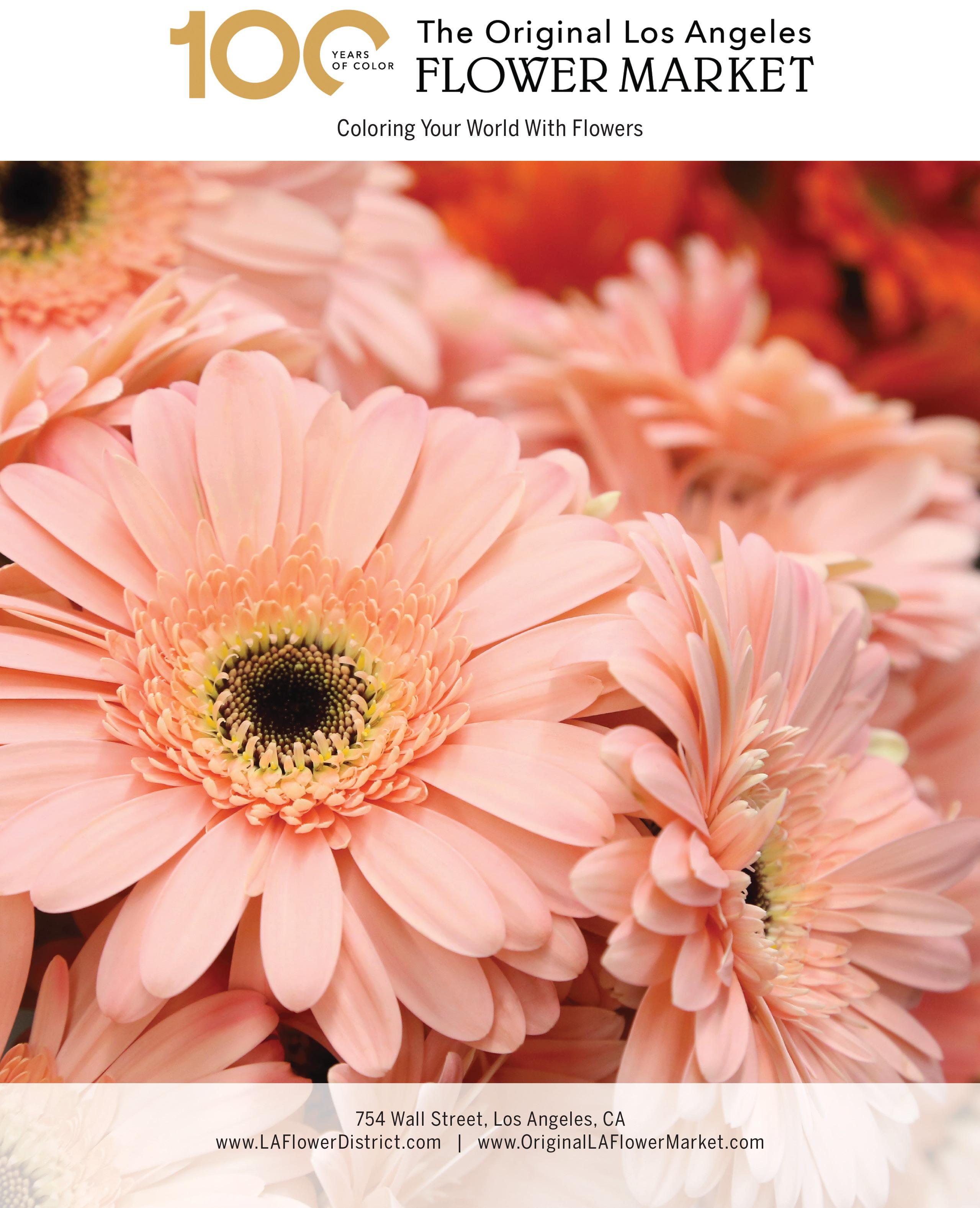
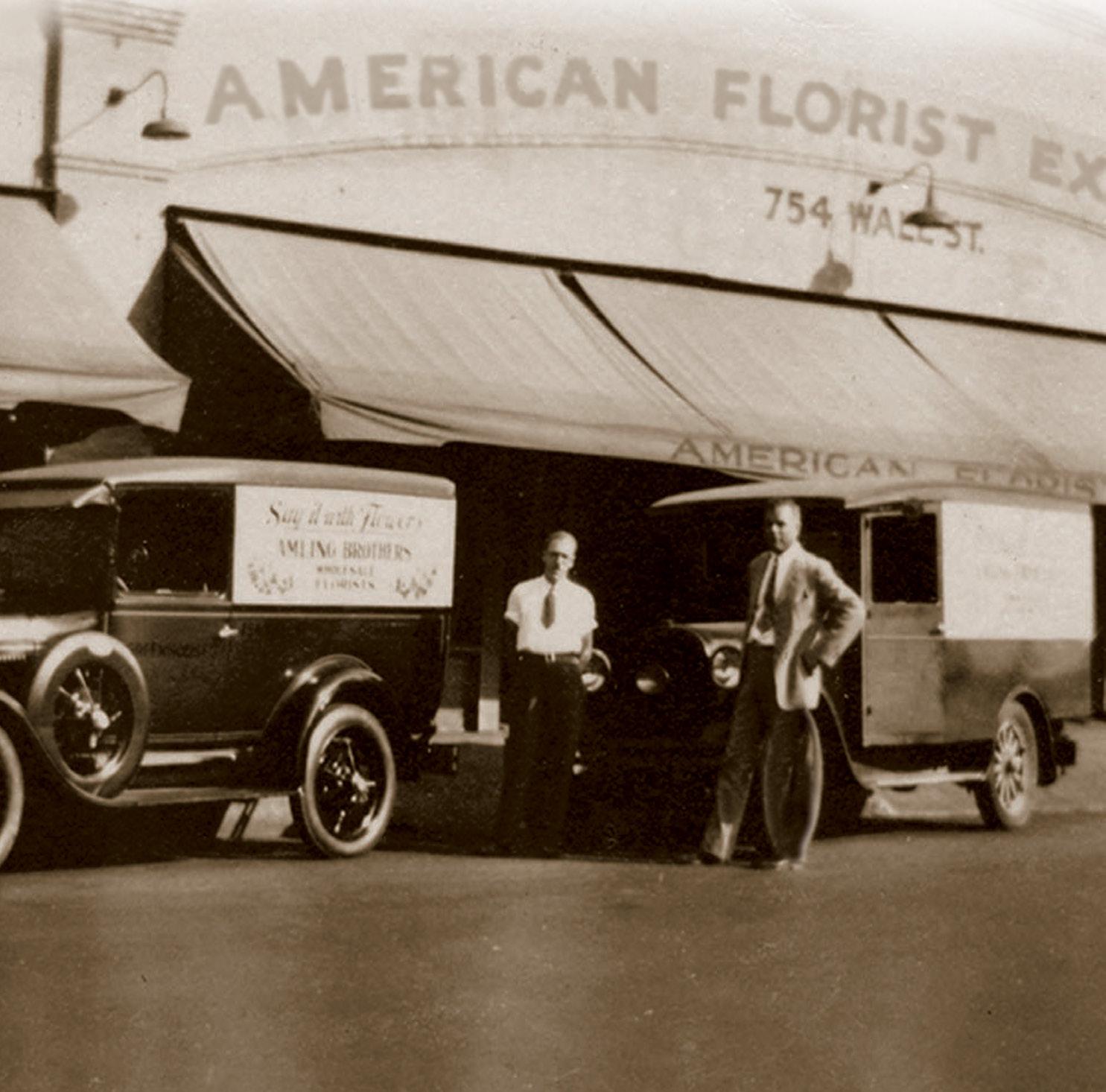
19 20s
FOUNDING FAMILIES
Unbeatable weather. A booming economy. Growing infrastructure. Southern California was an exciting place to live and work in the early 1900s. Here, a group of European immigrants came together to form an alliance to market their floral products. They founded the American Florists’ Exchange. It would become widely known as the Original Los Angeles Flower Market, and the heart of the American floral industry.
Inspired by the success of local JapaneseAmerican growers who had established the city’s first major flower market in 1912, the flower business in Los Angeles has been anchored in the downtown wholesale district. By 1928, about 50 wholesale companies were based in the American Florists’ Exchange. Monday, Wednesday and Friday mornings were the busiest days, just as they are today.
The market was supplied by flowers grown throughout Southern California. Within a 100-mile radius from Santa Barbara to San Diego, growers hauled their just-cut flowers to the market in the central city of Los Angeles.
Trucks and vans filled with roses, lilies, chrysanthemums and dozens of other flowers found their way to Wall Street to fill the growing number of orders from florists and wholesalers.
At first, the bustling market could only serve local demand. Soon, “refrigerated” railway cars packed with blocks of ice made it possible to ship beautiful blooms across the country. But how did it all begin?
The European immigrants who founded the American Florists’ Exchange were looking to build big dreams. Inspired by the success of produce markets and flower stands throughout the area, they set out in 1919 to establish a growerowned floral market. Their first official place of business was a garage on Winston Street, which intersects Wall Street, between Fourth and Fifth Streets.
In 1921, the AFE’s Articles of Incorporation were signed by the first five directors: Tom Wright, the first president of the American Florists’ Exchange; John C. Bodger, president of Bodger Seed Company; Roy F Wilcox, a pioneer in the indoor decorative plant industry; Albert Goldenson, a Los Angeles-based florist; and H.N. Gage, a Montebello flower grower. At the onset, there were about 30 flower growers, and the Articles of Incorporation were filed with the state on January 22,
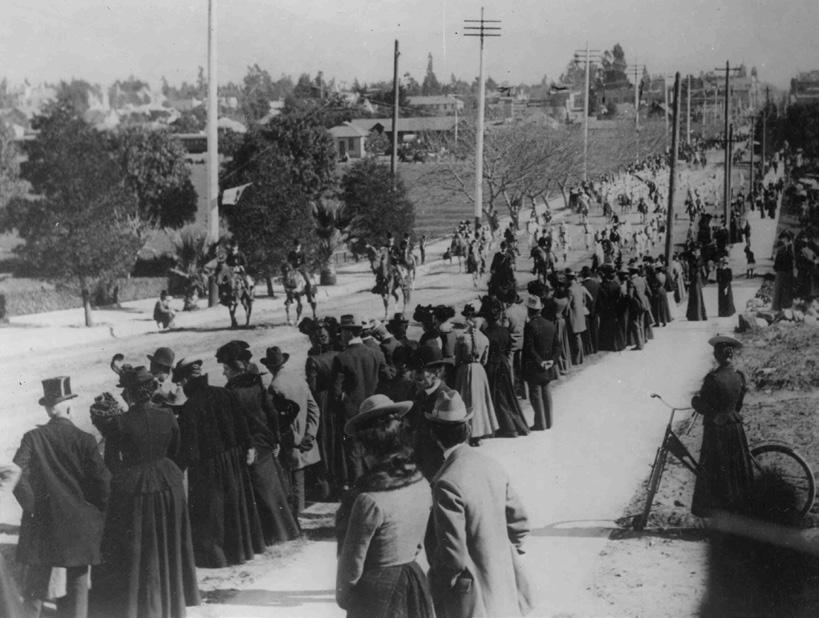
The Bloomin' News 10
1. 2.
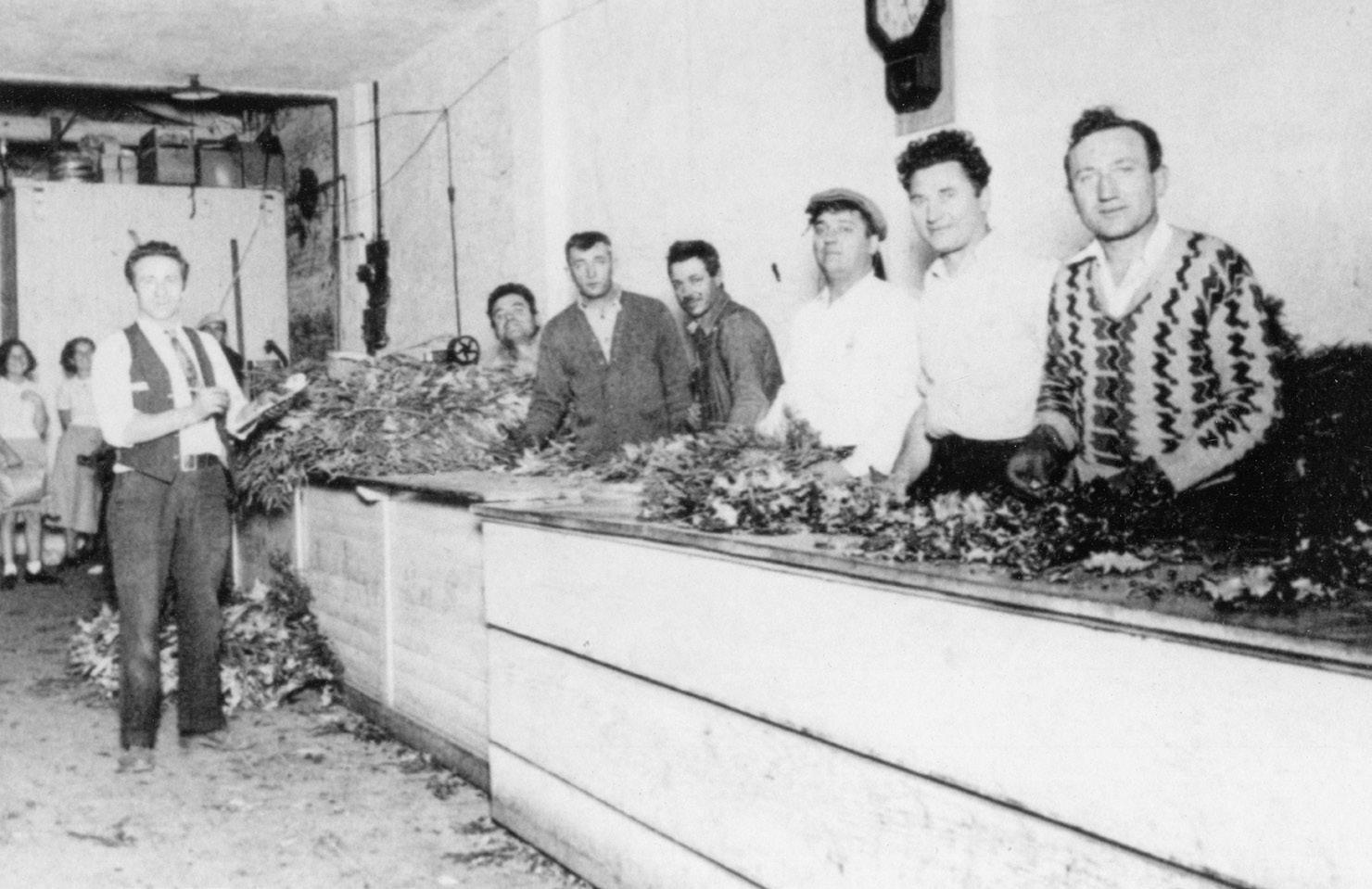
1921. Together, they shared the vision of operating and growing the wholesale floral market. Shares of stock were sold at $50 each.
Soon thereafter, the American Florists’ Exchange moved to its current location at 754 Wall Street. At the time, it was a 45-foot lot conveniently located across the street from the Southern California Flower Market, originally named The Japanese Flower Market. Both markets operate in these locations today.
As they continued to form and grow, the two major markets became complementary to each other, providing convenience to customers by selling from the same block. Both organizations purchased adjacent lots and buildings to continue expanding to accommodate more tenants and parking facilities. Many legendary pioneers of the L.A. floral industry were founding members including Ernst Amling, Walter Armacost and Fred Royston, Paul Ecke Sr., W. “Pop” Godrey, Vander Bruggen and Gebhard Prechtl, who would go on to be President of the AFE from 1926 – 1946.
Throughout the 1920s, the growth and impact of the Los Angeles floral district continued to attract more business. Even flower growers who later relocated to San Diego continued to truck their fresh product to the LA market several times a week. The variety of flowers sold, along with the year-round availability, helped the flower market flourish. East and Northern state demand continued to rise, especially for “off” season flowers that could not be grown anywhere but in Southern California during the cold winter months.
From weddings to holidays and every day in between, the AFE flower growers made it easy for people to enjoy the beauty and fragrance of flowers. Their devotion and dedication fueled the bustling LA market and kept the floral industry moving forward.
1. Two Amling Brother trucks parked in front of the American Florists’ Exchange, 1920s. Mellano collection.
2. Early 1900s Rose Parade.
3. Los Angeles Evergreen Employees on Wall Street during Christmas season, making garlands for the department stores. The inscription on back identifies the people as: Background - the two girls are Doris and Julia Gandolfo. From right to left, the workers are: Caesar Rainero (partner), John (Giovanni) Mellano (partner), Nick Gandolfo (Senior, a partner), an unknown man, Emilio Lombardo and Albert Mongi.
4. The Alhambra Nursery in the early 1920s, established in 1893. Alhambra Historical Society Collection.
5. The Alhambra Nursery, established in 1893, was located at 315 W. Main Street between Second and Third across from the Alhambra School. Nursery owner Glen McKay is pictured here in the early 1920s. Alhambra Historical Society Collection.
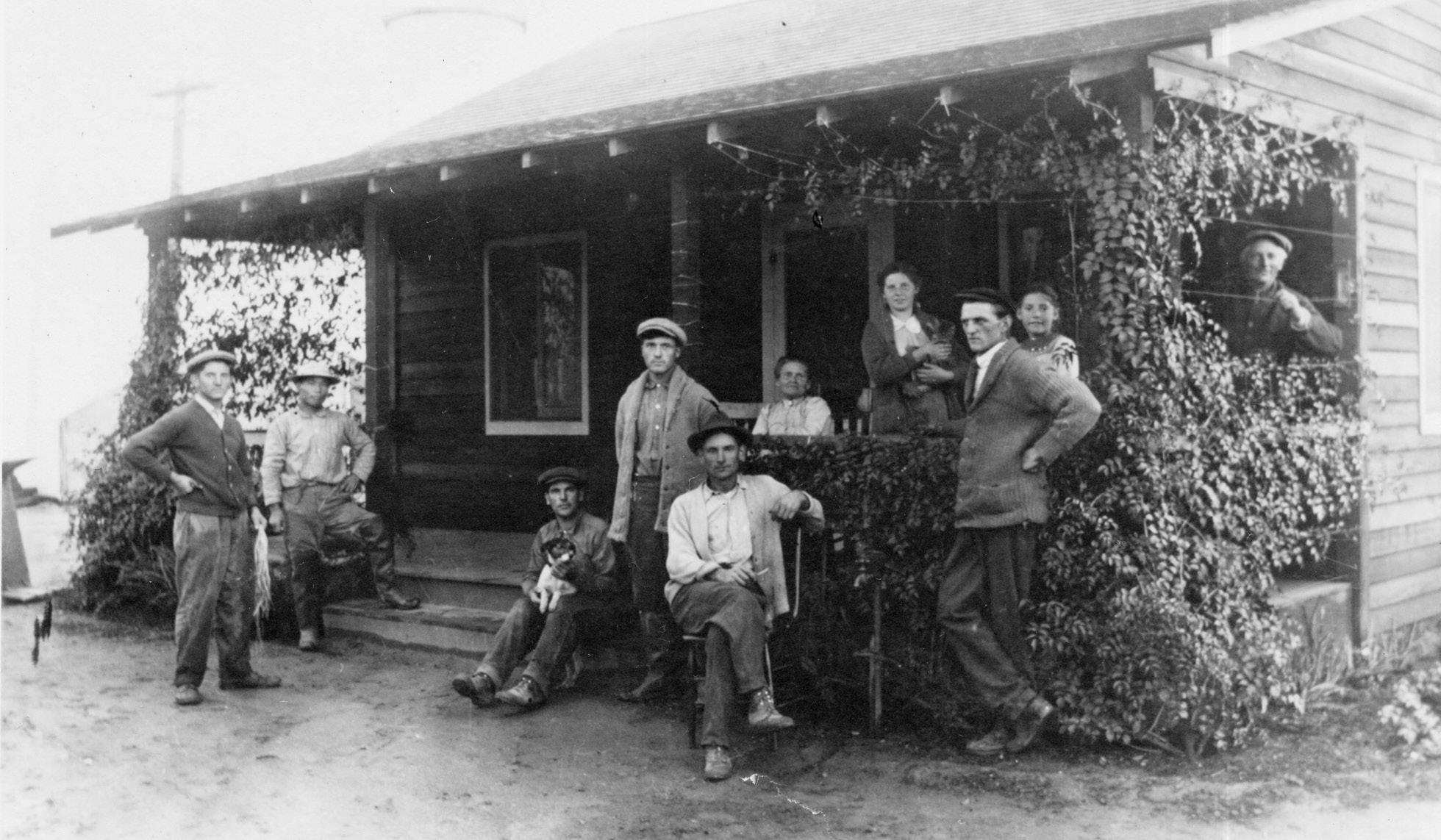
IN THE EARLY 1900s, FLOWERS ADORNED WOMEN’S HATS AND DRESSES, DECORATED TABLES, AND BRIGHTENED HOMES AND GARDENS ALL OVER SOUTHERN CALIFORNIA.
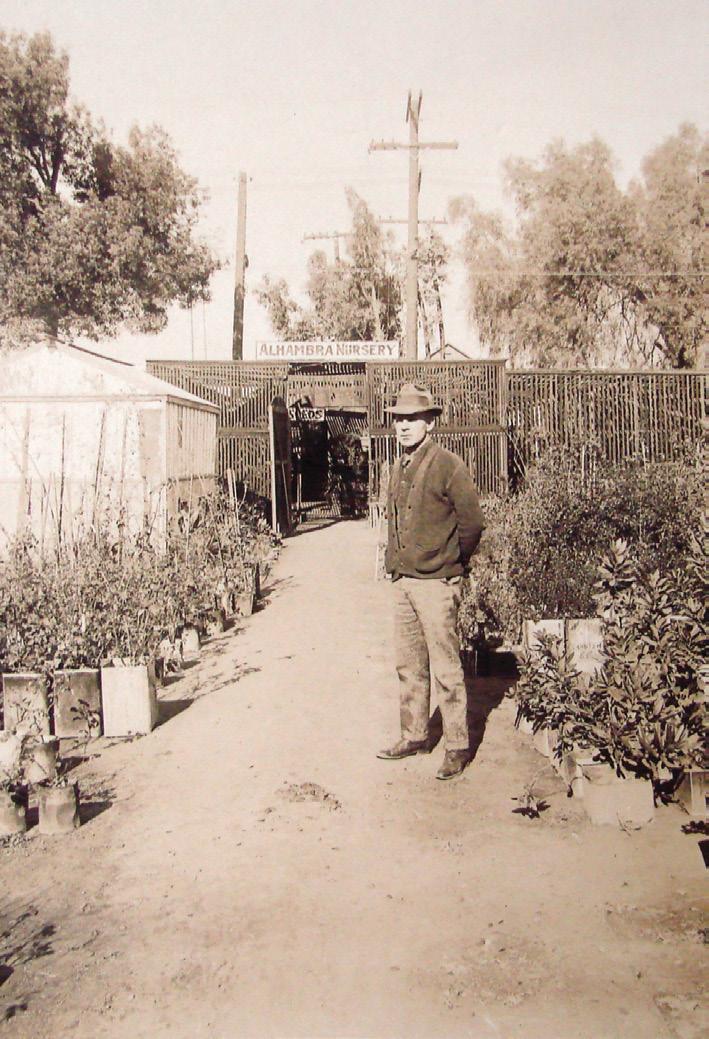
11 The Bloomin’ News
3. 4. 5.
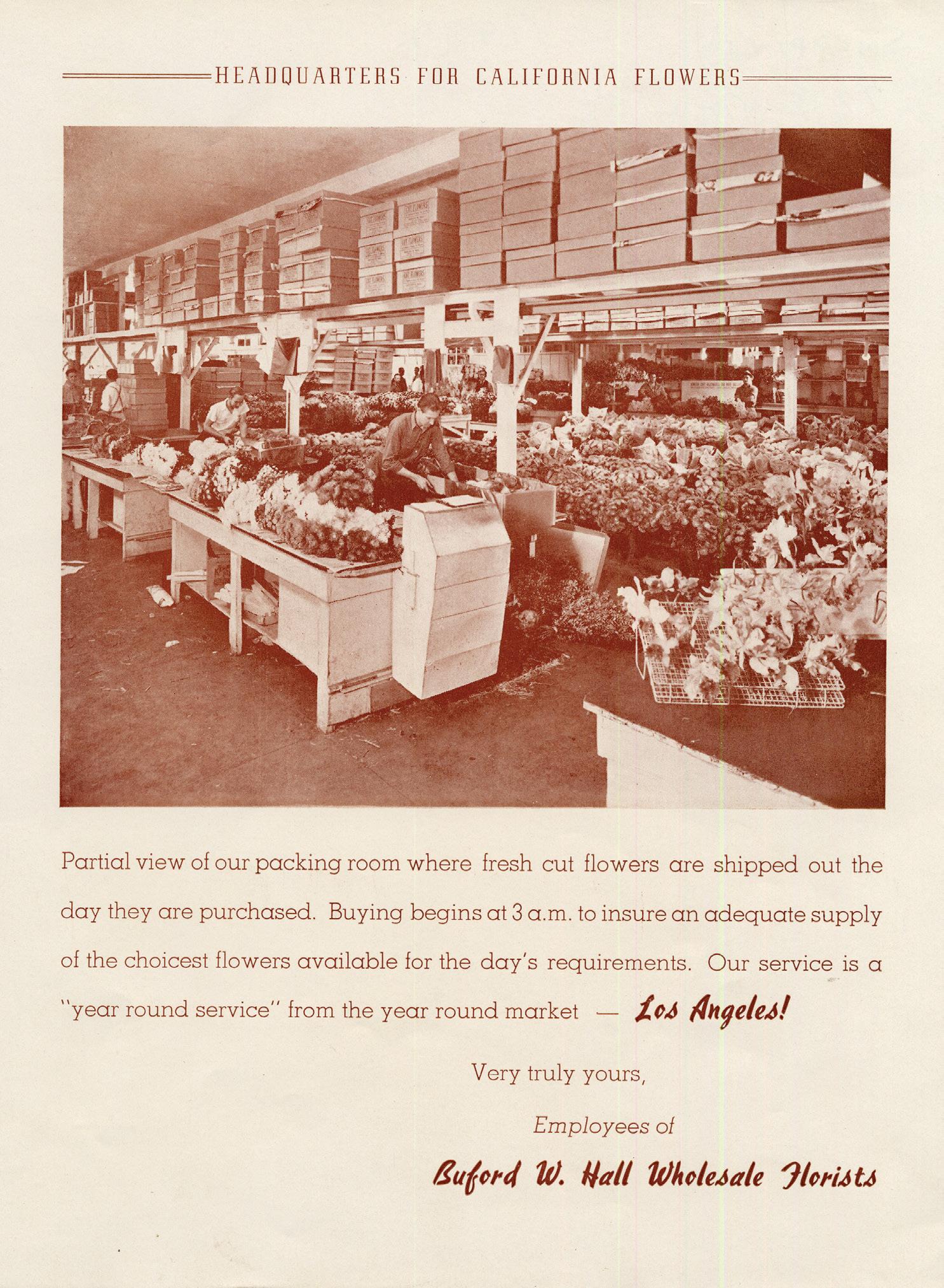
19 30s
GROWTH AND DEPRESSION
In 1930, Leon Moskatel opened a retail flower shop on Wall Street just north of the Los Angeles Flower Market. It would become known more for its floral accessories as much as it would for the flowers being sold. To this very day, they continue to be a thriving part of the Original Los Angeles Flower Market. Originally, they brought in flowers from Northern California and supplemented their cut flowers with floral supplies. Moskatel’s would become a major force in creative floral design. With cases, foams, interior design accessories and special event supplies, they became a haven for event planners and major hotel catering managers. Even movie set decorators would use their offerings to create false forests and timeless set decorations.
Other florists would open up around Wall St. and over onto San Julian Street. One of the earliest tenants of the American Florists’ Exchange was Mellano & Company, founded in 1925. Today Mellano & Co. is the largest, most diversified wholesale tenant in the market providing both farm fresh flowers and greens along with seasonal offerings.
Through this time, flowers continued to be popular. People needed to buy flowers to help themselves feel better or as a gift to pick up someone’s spirits or mood. Flowers were like hope. They excite us visually and have fragrances that can transcend your current environment.
Both of the markets continued to thrive. There was a constant desire by the founders of the markets to expand to provide more parking and make space for more tenants. Adjacent lots on both sides of Wall St. with apartment buildings on them were bought, and houses were torn down to make way for their expansion.
Despite the beginnings of the Great Depression, the flower district continued to expand.
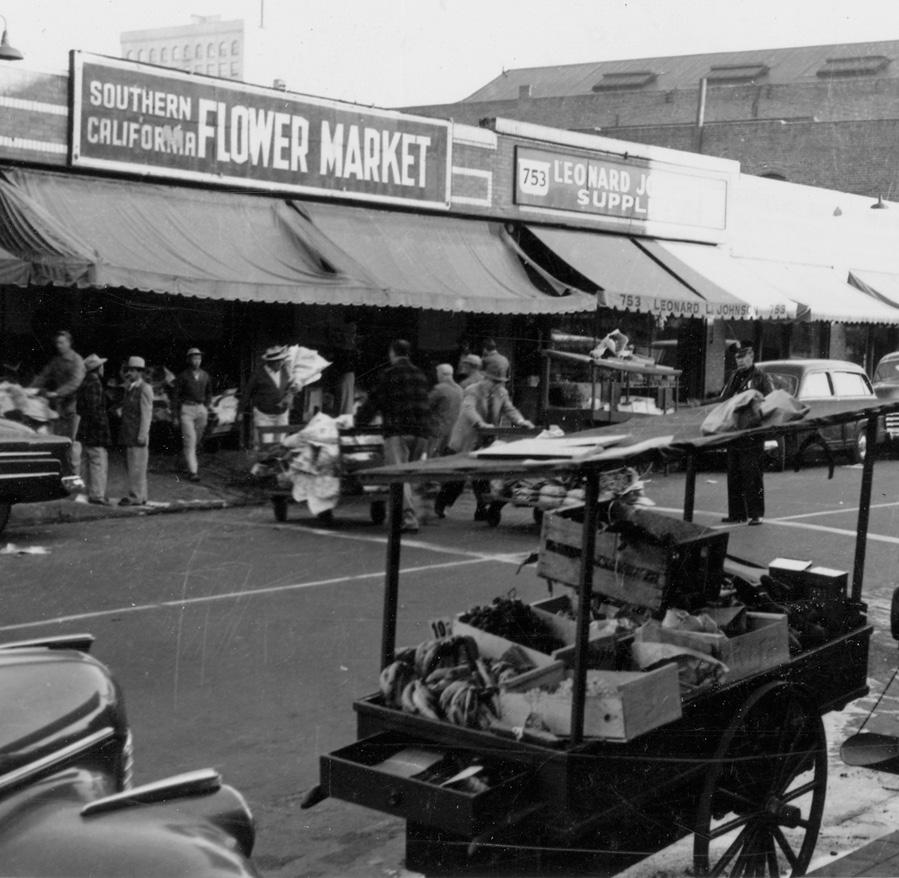
The Bloomin' News 12
1. 2.
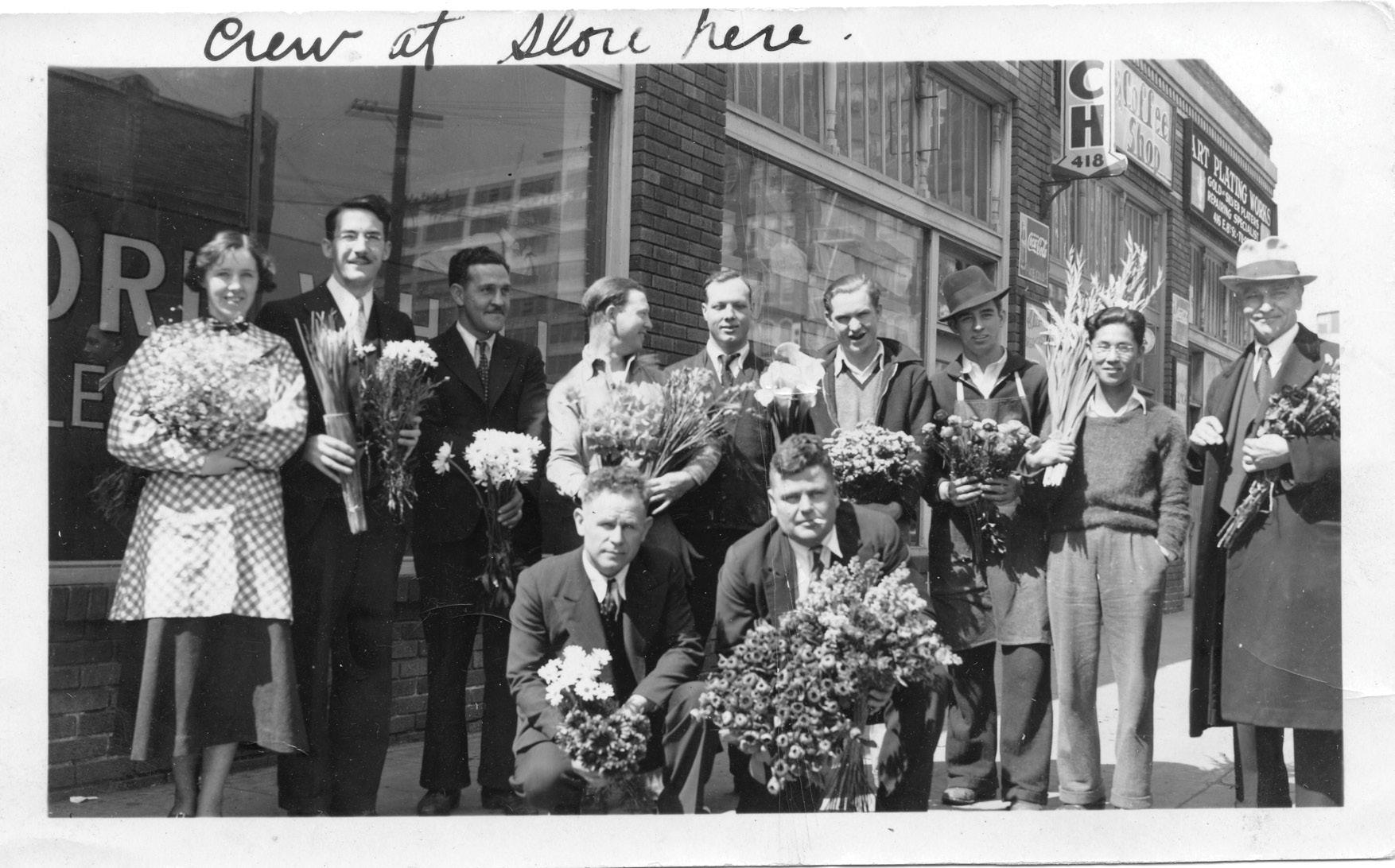
In the flower industry, the 30s proved to be a mixed bag. Despite the national economy, local farmers continued to provide a wide range of flowers through the market. The commercialization of the cut flower industry had farms all along the coastline using immigrant laborers who came to the Los Angeles area in search of work.
It was at this time that two organizations found traction to support the American Florists’ Exchange. In 1931, the Southern California Floral Association began. It was formed as a non-profit group with florists, growers, wholesalers, floral delivery firms and floral supply companies working together. It was the beginning of the wholesale business as we know it today. Over time this group was required to register their tax exemption certificates with the Association in exchange for receiving a ”badge.” This relation made the Association in charge of determining buyers’ eligibility for wholesale status. Another unique business came out of that same time. The Telegraph Delivery Service was started by Edwin S. Douglas. Starting in 1934 with just a dozen retail shops, their goal was to facilitate the ordering of flowers over the wire (as they would say then) allowing florists to expand their services to out-of-towners. The offers were based on the product available through the Flower Markets. This business today is known as FTD and is one of the world’s largest flower shippers directly to consumers.
1. Partial view of the Buford W. Hall Wholesale Florist packing room in 1939.
2 . The Amling 600-feet-long greenhouse on Fifth Street in Santa Ana after 1937, were used to grow the company’s famous roses, shipped right form the field by Pacific Electric train to Los Angeles. Amling collection.
3. The crew at Buford W. Hall Wholesale Florists in the early 1930s. Back row from left, Dorothy Smith, Art Smith, Royce Chezum. Kneeling are Jacob Dekker, left and Buford W. Hall. Warren Hall collection.
4. Leaders of the Japanese-American Flower Industry Association (forerunner to the Southern California Floral Association) pose for this May 16th, 1937 photo. Seated form left are: Yoshataro Matsushita, cut flowers growers; W.J. Vander Bruggen, grower; Paul Yamamoto, grower and Bruin Flower Shop; William B. Williamson, general manager of Armacost & Royston; Mosatiro Kai, grower; Wall Godfrey, partner, BriggsGodfrey Cut Flowers; Kametaro Akiyama, grower; Gebhard Prechtl, president, American Florists’ Exchange; Akia Mori, owner, More Greenhouses.
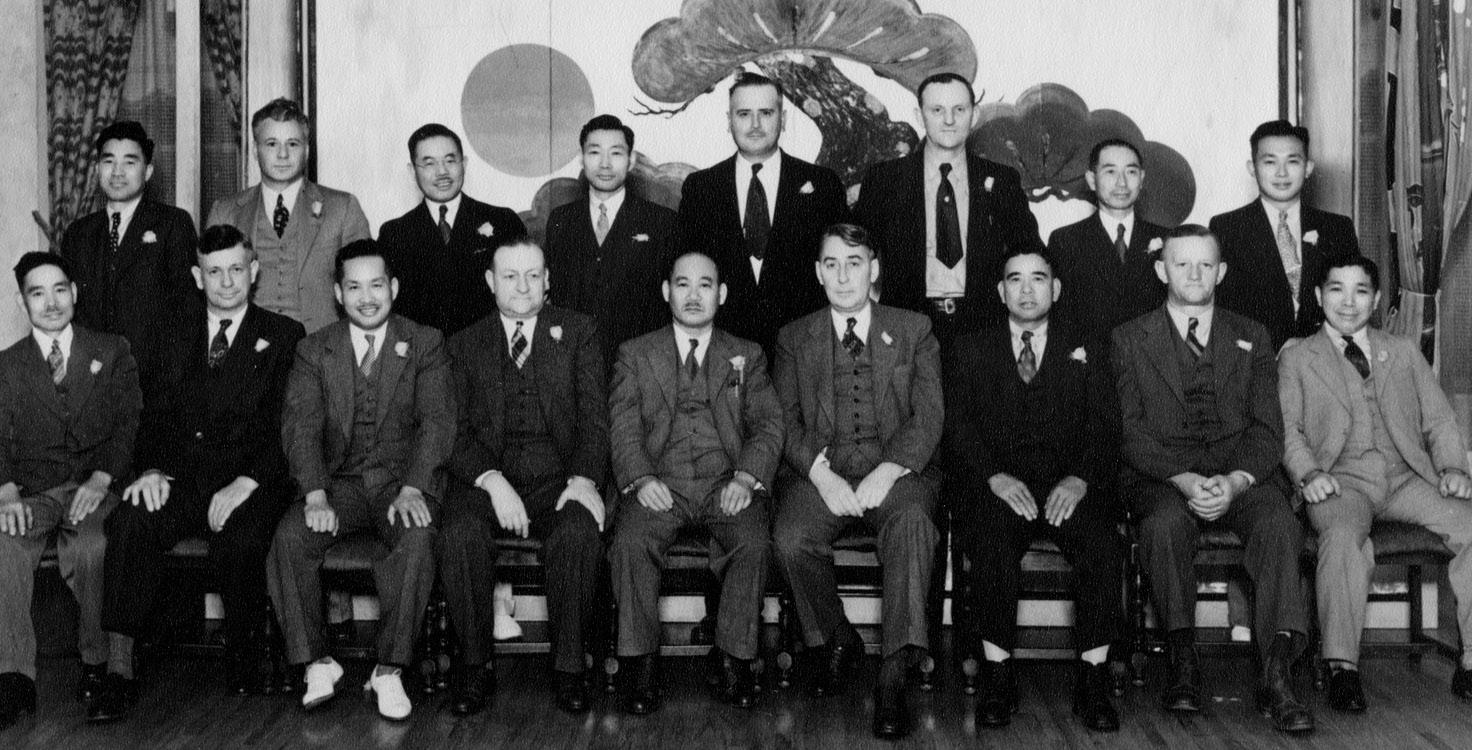
“THE SHEER VARIETY OF FLOWERS SOLD AT MARKET, ALONG WITH THE YEAR-ROUND AVAILABILITY OF WHAT AMERICANS BACK EAST AND IN THE NORTHERN STATES CALLED ‘OFF’ SEASON FLOWERS ASTOUNDED VISITORS AND KEPT THE FLOWER INDUSTRY MOVING FROM COAST TO COAST.” RIDGEWAY/WORKS, SENDING
13 The Bloomin’ News
3. 4.
FLOWERS TO AMERICA
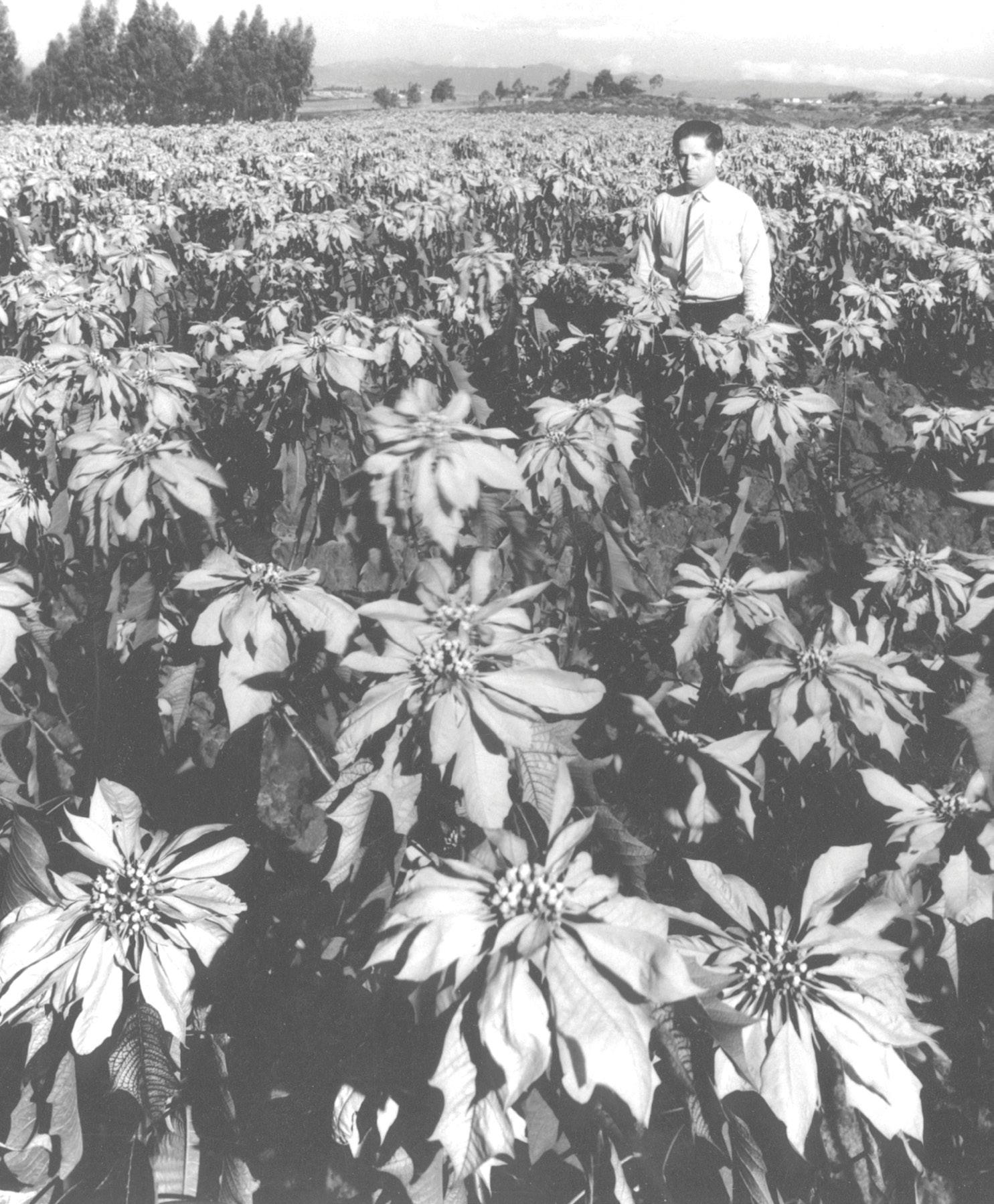
19 40s
WAR AND PEACE
Coming off the economic depression of the 1930s, new challenges arose in the 1940s. The unexpected attack on Pearl Harbor on December 7, 1941 pulled the U.S. into the war that had begun two years earlier in Europe.
Flower growers throughout Southern California helped the war effort by using their fields to grow fruits and vegetables to support America’s food supply. During this tumultuous time, Japanese Americans were deeply impacted. Many were investigated and arrested. They were forced to walk away from their homes and businesses as they were evacuated to War Relocation Authority Camps. The $4 million Japanese American floral business came to an abrupt halt. The Southern California Flower Market was closed as the FBI reviewed its books. Bank accounts were frozen. Spaces at the market were sub-leased to other growers and wholesalers.
Tensions were high during this time, but several tenants from the American Florists’ Exchange came to the aid of their Japanese American counterparts. AFE members offered to watch over their operations or help transfer ownership temporarily until the Japanese Americans returned. One such example was Jacob Dekker of United Wholesale Florists. He temporarily leased the properties, ranches and greenhouses of several Japanese Americans. One family, the Satows, recalled receiving their checkbook back from Dekker complete with profits incurred during their absence. Mori Nursery was the only Japanese American tenant at the Southern California Flower Market to keep its name during the war. Their employee, a young French American named Fred Sarrazin, watched over the business until the owners could return. The war took its toll on the industry in many ways. One issue was gasoline rationing, which made it difficult to deliver flowers or travel downtown to purchase them. The gasoline shortage led to a new delivery service – the “route man.” The efficiency and convenience of the service made business run more smoothly and spurred growth for years to come.
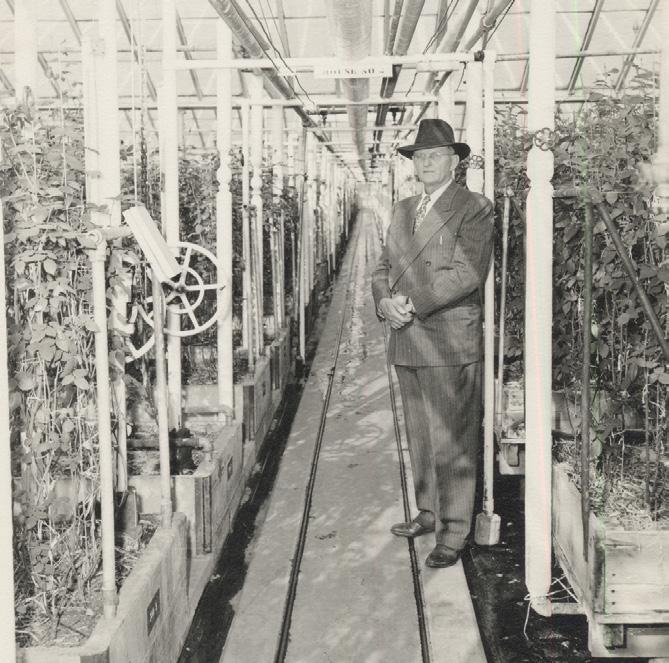
The Bloomin' News 14
1. 2.
FLOWER GROWERS THROUGHOUT SOUTHERN CALIFORNIA
HELPED THE WAR EFFORT BY USING THEIR FIELDS TO GROW FRUITS AND VEGETABLES TO SUPPORT AMERICA’S FOOD SUPPLY.
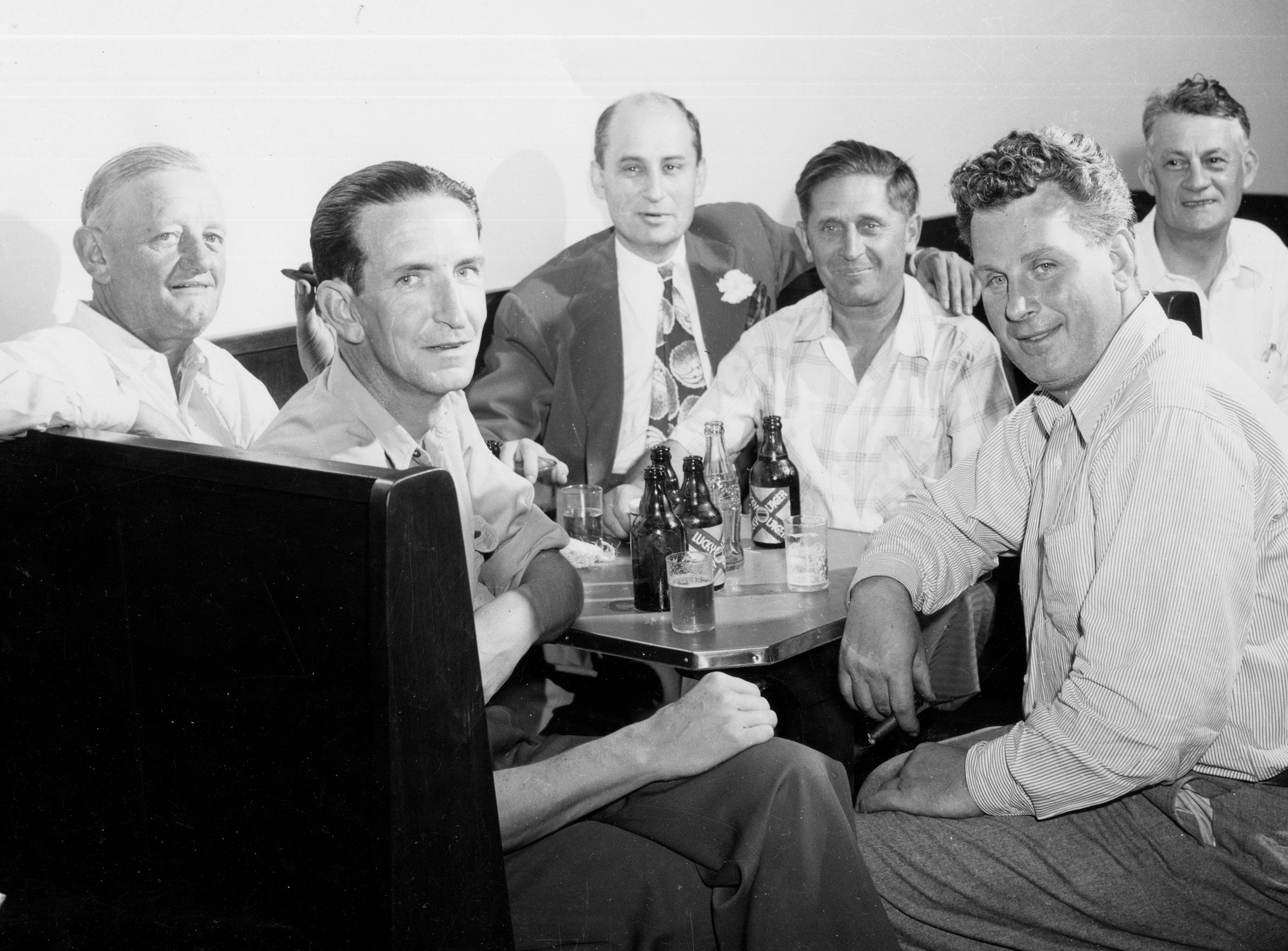
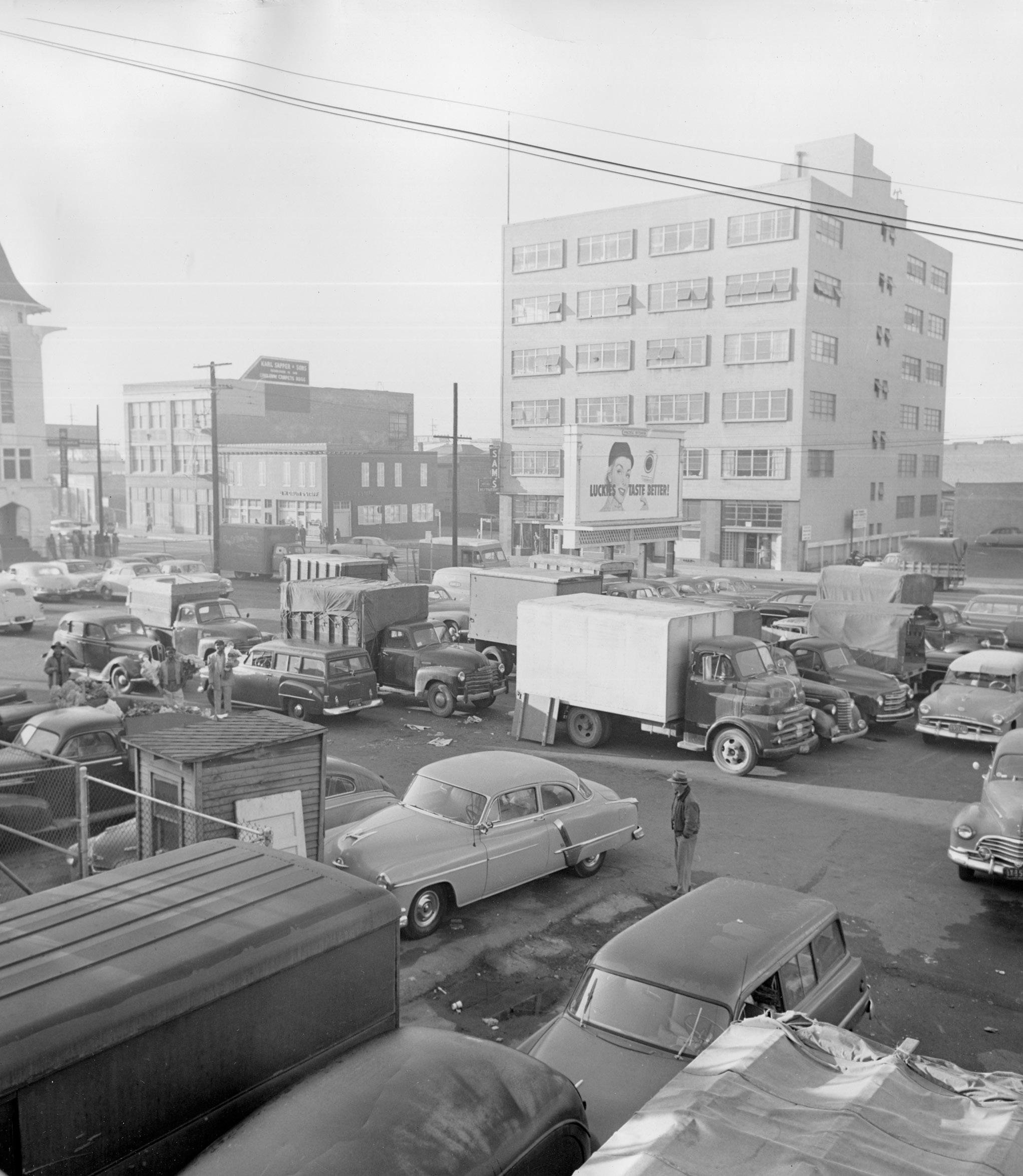
The Second World War ended in 1945. Life began to bounce back, and the industry started to rebuild. On January 1, 1946, control of the Southern California Flower Market was returned to Japanese American growers. The war years were stressful, but the industry rebounded. In fact, the Florists Telegraph Delivery service was founded prior to the end of the war. The first FTD shipment of flowers transported by air was in 1944. The plane departed from the San Diego airport on its way to the East Coast. By the late 1940s, air freight was shipping 30 percent of California’s fresh-cut flowers all over America. California growers shipped entire plane loads of fresh flowers weekly to major markets like Dallas, Chicago and New York.
In 1948, the California State Floral Association was established to further organize and unite all segments of the floral industry. Other associations soon followed. Together they helped the industry address important needs and issues, ranging from government policies to education to certification programs. This spirit of unity represented another step forward for the industry, allowing it to further advance and flourish.
1. Paul Ecke Sr. in the Ecke poinsettia fields, 1940s.
2. CJ Groen in Montebello Greenhouses in 1946.
3. Parking Lot of The Original Los Angeles Flower Market .
4. “Members” of an unofficial social club enjoy refreshments in the Rose Cafe. They are, from left: Gebhard Prechtl, Bob Ray, C.P. Von Herzen, Paul Ecke Sr., Bill Harris, and, in the back, Ed Hall, owner of the Rose Cafe until its purchase by Barny Barnhart. Los Angeles Flower Market collection.
15 The Bloomin’ News
3.
4.
19 50s
VIBRANT EXPANSION
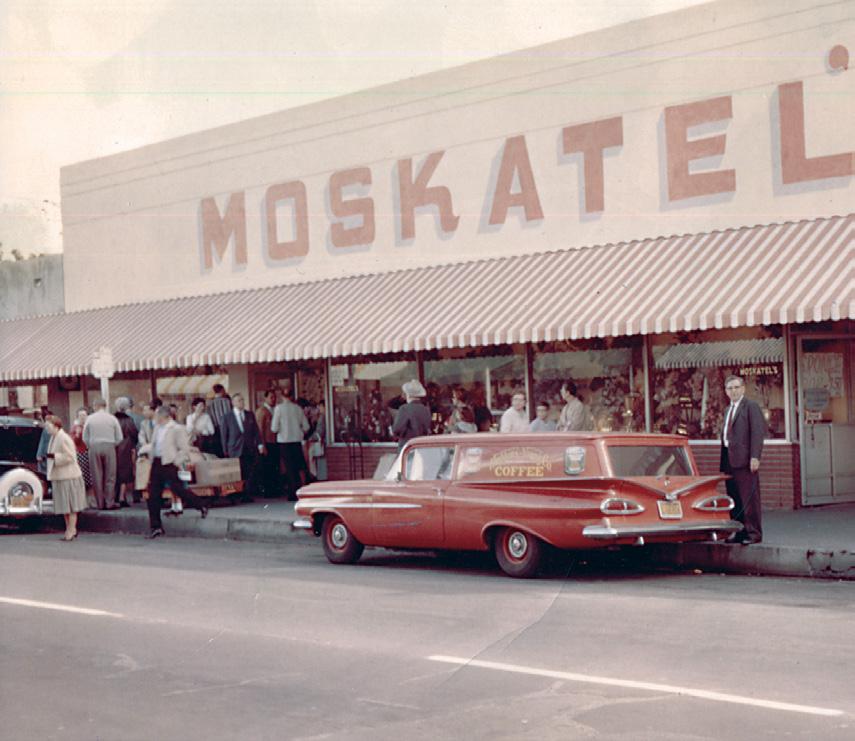
Wide swatches of colorful flowers covered the Southland in the 1950s. Southern California was described as a “trial garden” for flower lovers with production across hundreds of miles.
From small plots to hundred-acre ranches, floral farms were owned primarily by immigrants and the first generation of their children.
Los Angeles County led the country in floral sales with more than 500 farms producing a myriad of cut flowers, potted plants and florists’ greens. Montebello was another hotbed with Dutch growers selling nearly a million exotic blooms through the LA Flower Market for shipment throughout the country. Santa Barbara County crops enjoyed increased popularity and robust sales for chrysanthemums, baby’s breath and carnations. Hundreds of acres in Ventura County were planted with lilies, irises, delphinium, larkspur and snapdragons.
Orange County was primarily known for citrus farms, but flowers were also grown on small acreages scattered throughout the county. And with its nearly perfect climate, San Diego became one of the most robust flower-growing regions. At the time, growers were shipping over 400 boxes of cut flowers each day. 1.
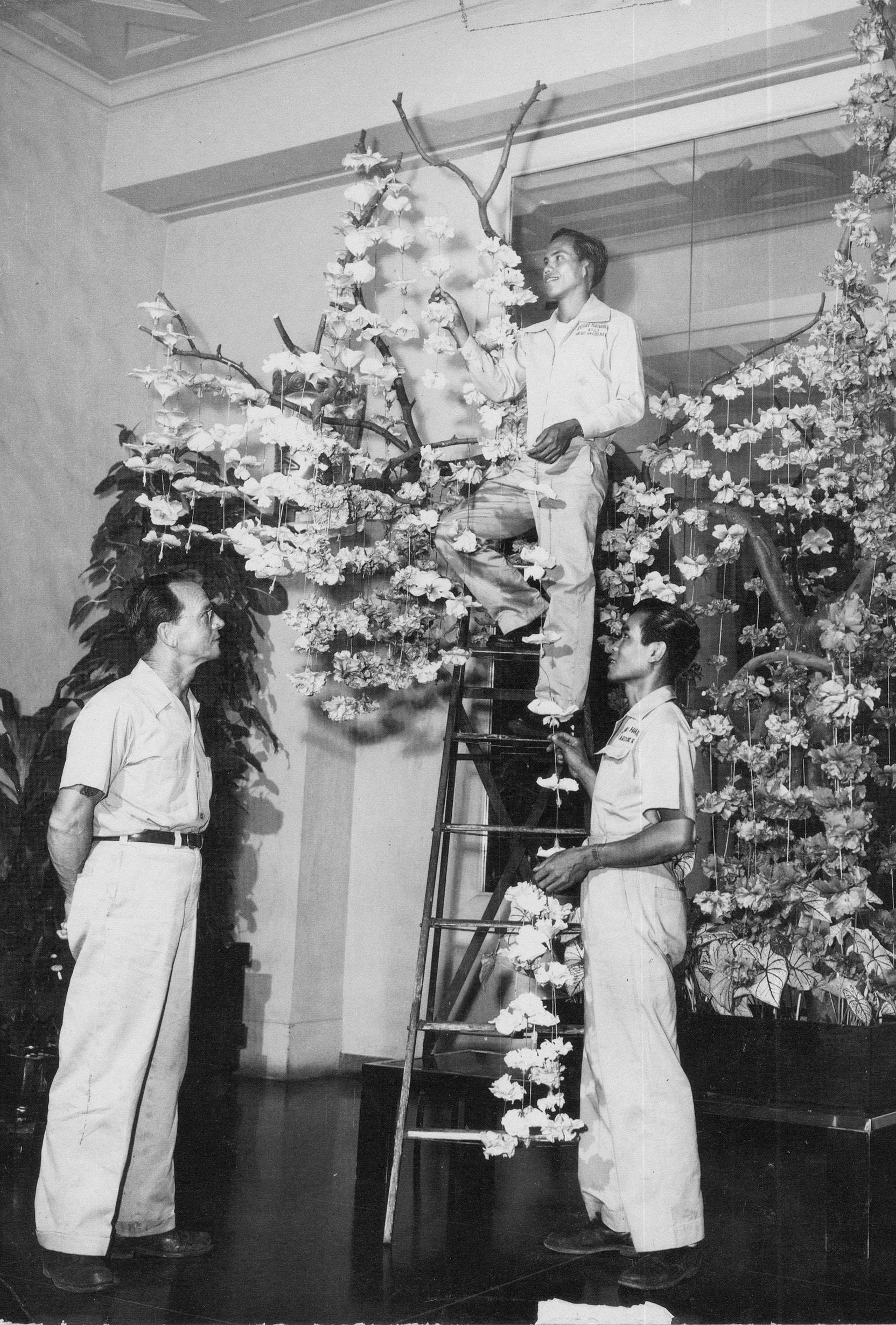
The Bloomin' News 16
2.
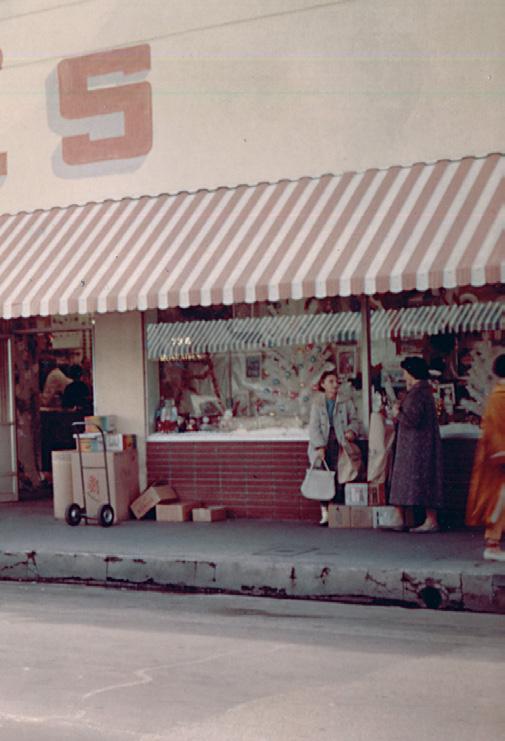
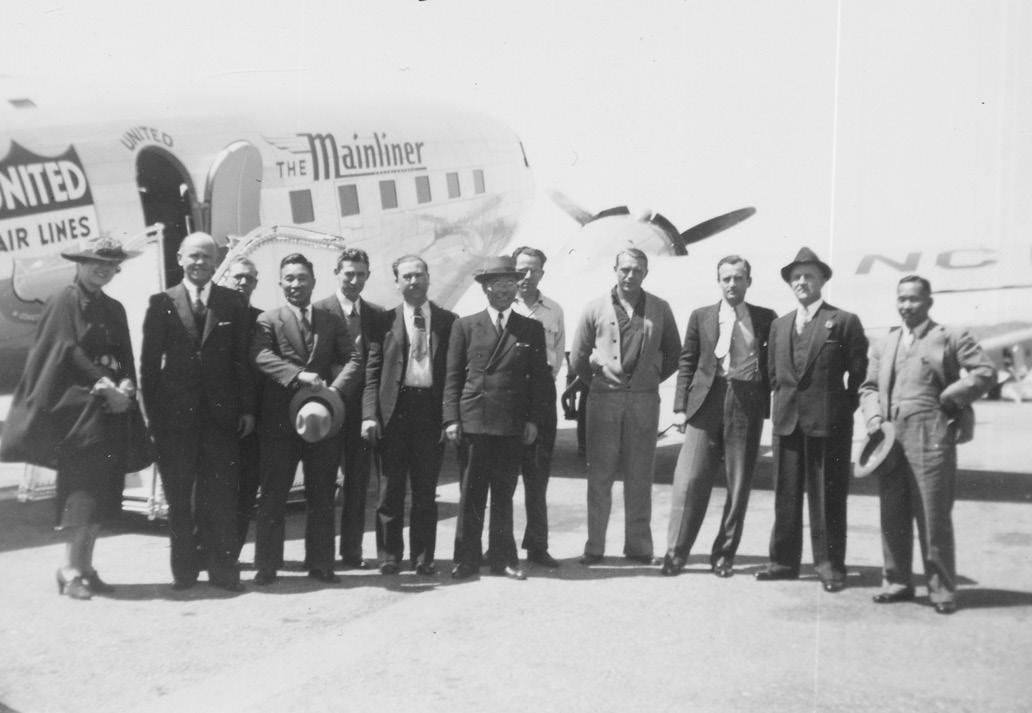
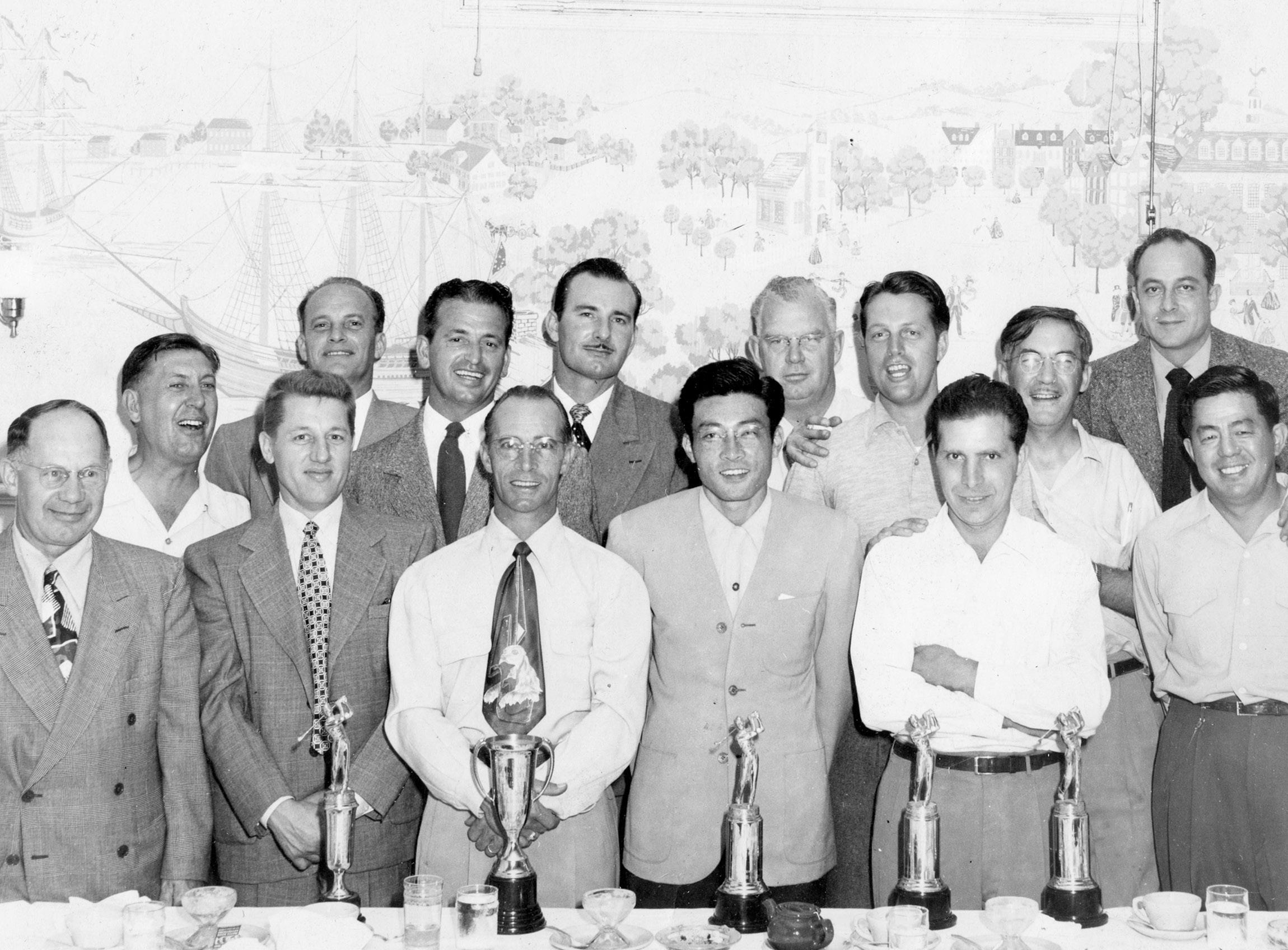
LOS ANGELES COUNTY LED THE COUNTRY IN FLORAL SALES WITH MORE THAN 500 FARMS PRODUCING A MYRIAD OF CUT FLOWERS, POTTED PLANTS AND FLORISTS’ GREENS.
Promotional creativity also blossomed during this time. In 1951, rose growers in Southern California came up with an idea to increase awareness and boost sales. They pooled their collective surplus of roses and distributed them free of charge to banks, restaurants, special events, radio and television stations. Nearly 3,000 roses were distributed in thirteen weeks to the joy of many local businesses.
Another example is The Gladiolus Story. The Southern California Floral Association produced a documentary-style film about the growing, packaging, design and selling of the gladiola. The five-member planning committee included: General Manager Walter Swartz, Edwin Frazee, Wall Godfrey, Arville G. Williams and Edmond G. Thornton. The film featured beautiful shots of the fields, retail shops, design rooms, packing sheds, department stores, churches and hotel lobbies. It was
a beautiful tribute to the gladiola - from seed to sale.
One of the most spectacular ideas came from Dutch growers in Montebello, C.J. Groen and W.J. Vander Bruggen. In 1956, they booked a trip on an ocean liner out of New York to visit their relatives in Holland. Before departing, they shipped a thousand stems of bird-of-paradise to decorate the ship’s salons. They invited New York City florists to see the memorable birdof-paradise display, which Easterners had not seen before. The amazing display received so much press coverage that Groen and Bruggen’s business was booming by the time they returned from the trip.
The industry’s commitment to quality, along with a little creativity, kept consumer demand high. It also kept profits strong for the growing number of growers and wholesalers working diligently to support and expand the market.
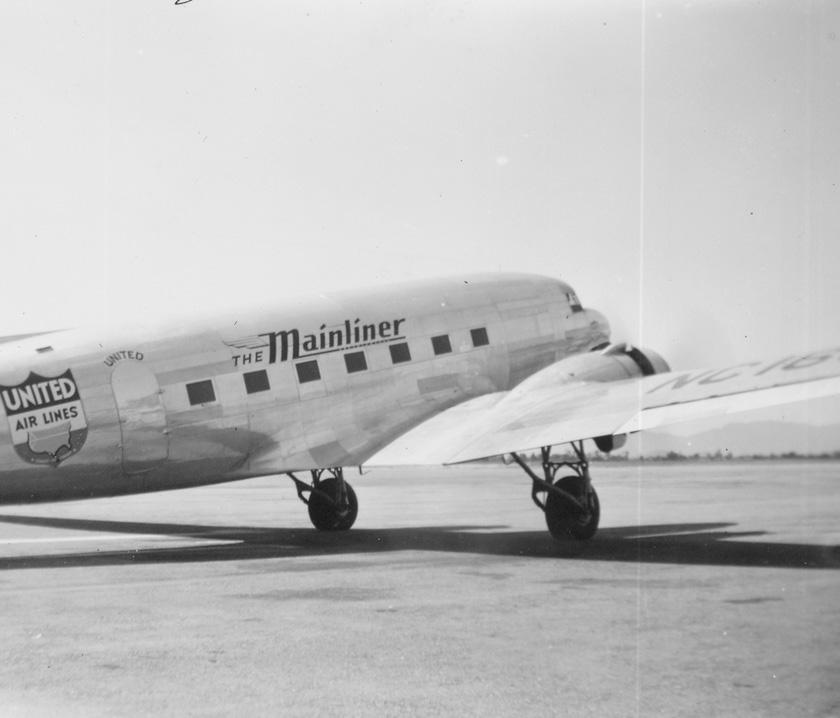
1. Silverio Casabar, on ladder, is assisted by his stepfather Bill Sutton, left, and Vincente Gorope. The year is 1952. Rulloda collection.
2. Moskatel’s Store Front (1959).
3-4. A 1950s promotion organized by Frank Kuwahara flew thousands of chrysanthemums to New Orleans to fill florists’ Mother’s Day orders. Mellano collection.
5. Golfers show off their trophy after a 1905 tournament. Back row form left: Walter Swartz, Lennie Johnson, Eddie Battistessa, Mario Pozzo, Don Forsythe, Bert Johnson, Art Smith, Hank Marquis. From row from left: Harry Francis, Joe Holladay, Jack Hauquitz, Chuck Hirata, Jack Reed, Fred Tayama. Battistessa collection.
17 The Bloomin’ News
3.
4.
5.
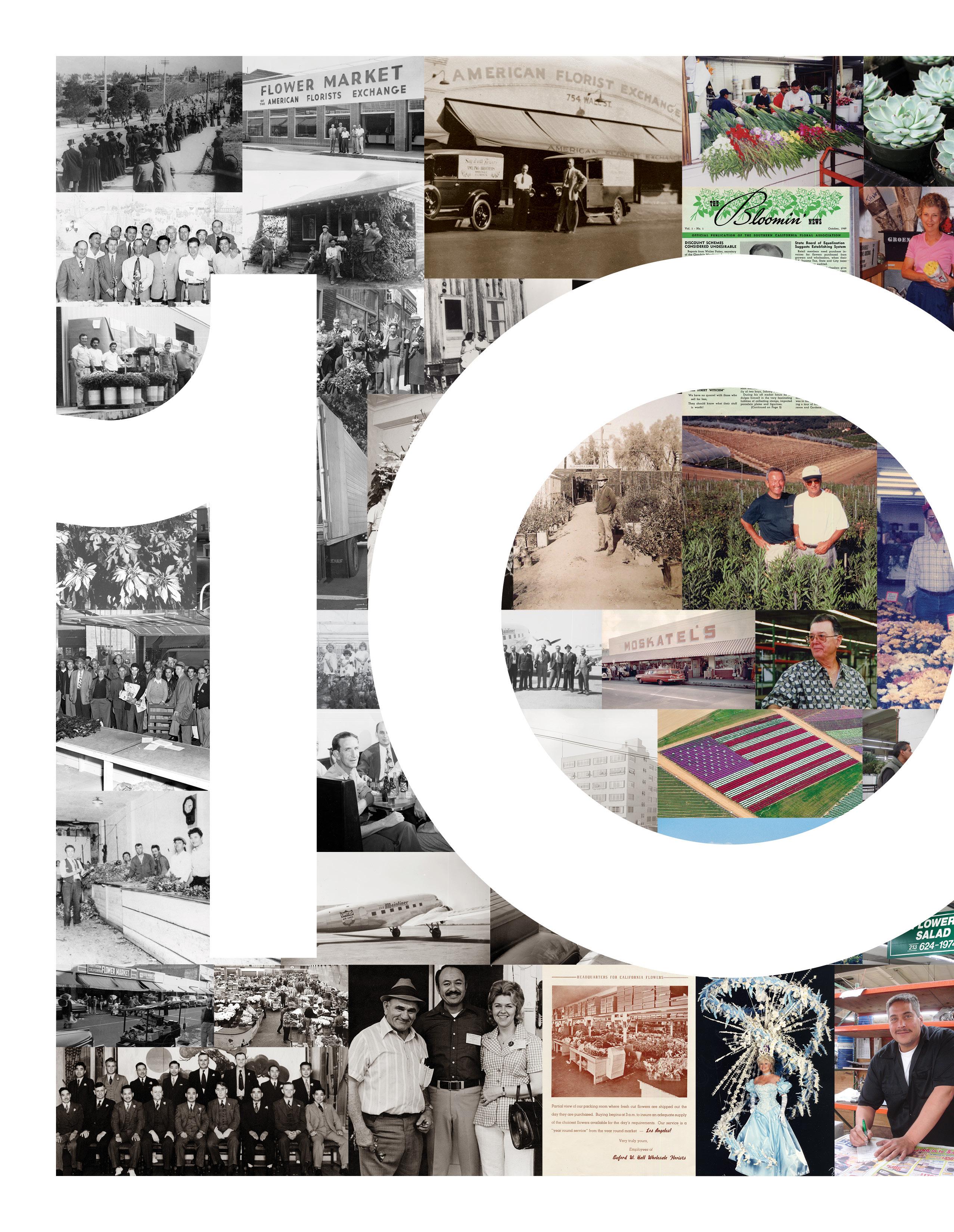
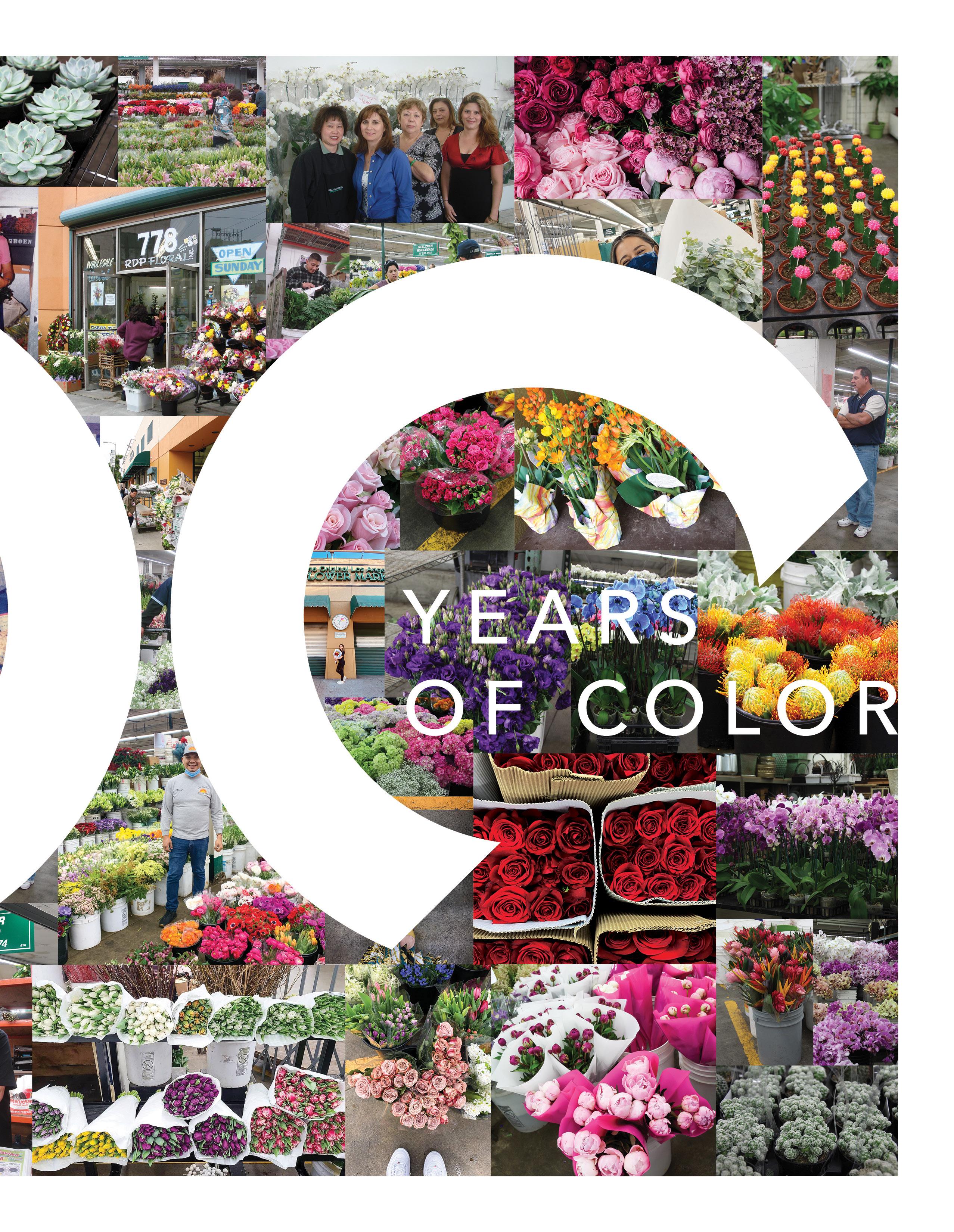
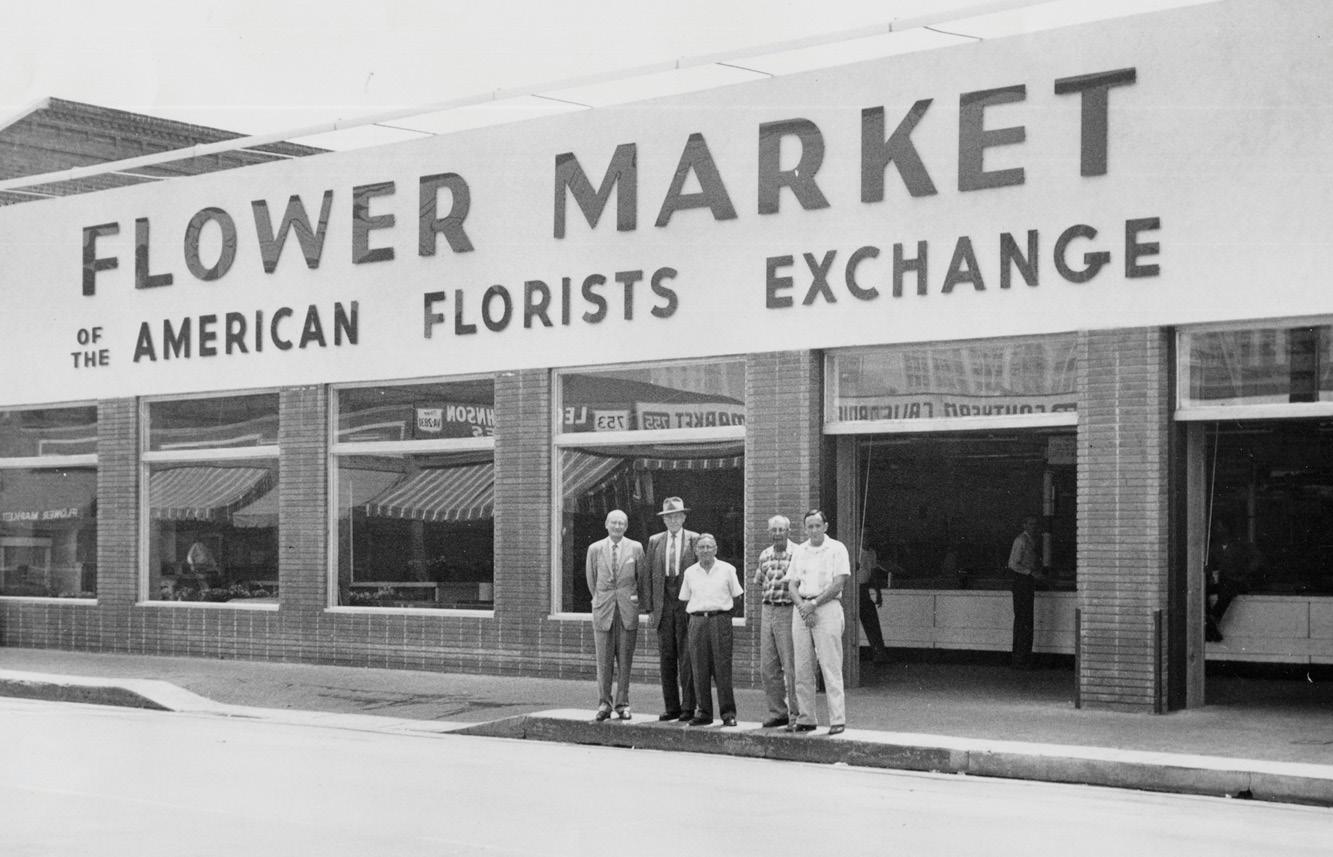
19 60s GROWTH IN THE FACE OF CHANGE
The 1960s was a volatile time remembered for activism, art and music. Yet, business was strong and steady for the wholesale floral district. Over 120 varieties of flowers and greens were on display daily on the sales floor. The LA market supplied nearly 100 percent of the cut flowers and potted plants sold by retail florists throughout the region.
In the early 1960s, both the American Florists’ Exchange and its neighbor, the Southern California Flower Market, began new construction projects to expand their footprint. AFE constructed a tri-level, 60,000 square foot building on its north side. Across the street, SCFM also built a new, three-story building. Once completed, customers could easily walk thru both facilities and purchase an array of floral products to meet their needs. Retail customers and journalists talked about the “Flower Market” to describe the two areas as if they were one. Combined, the two markets sold $20 million annually.
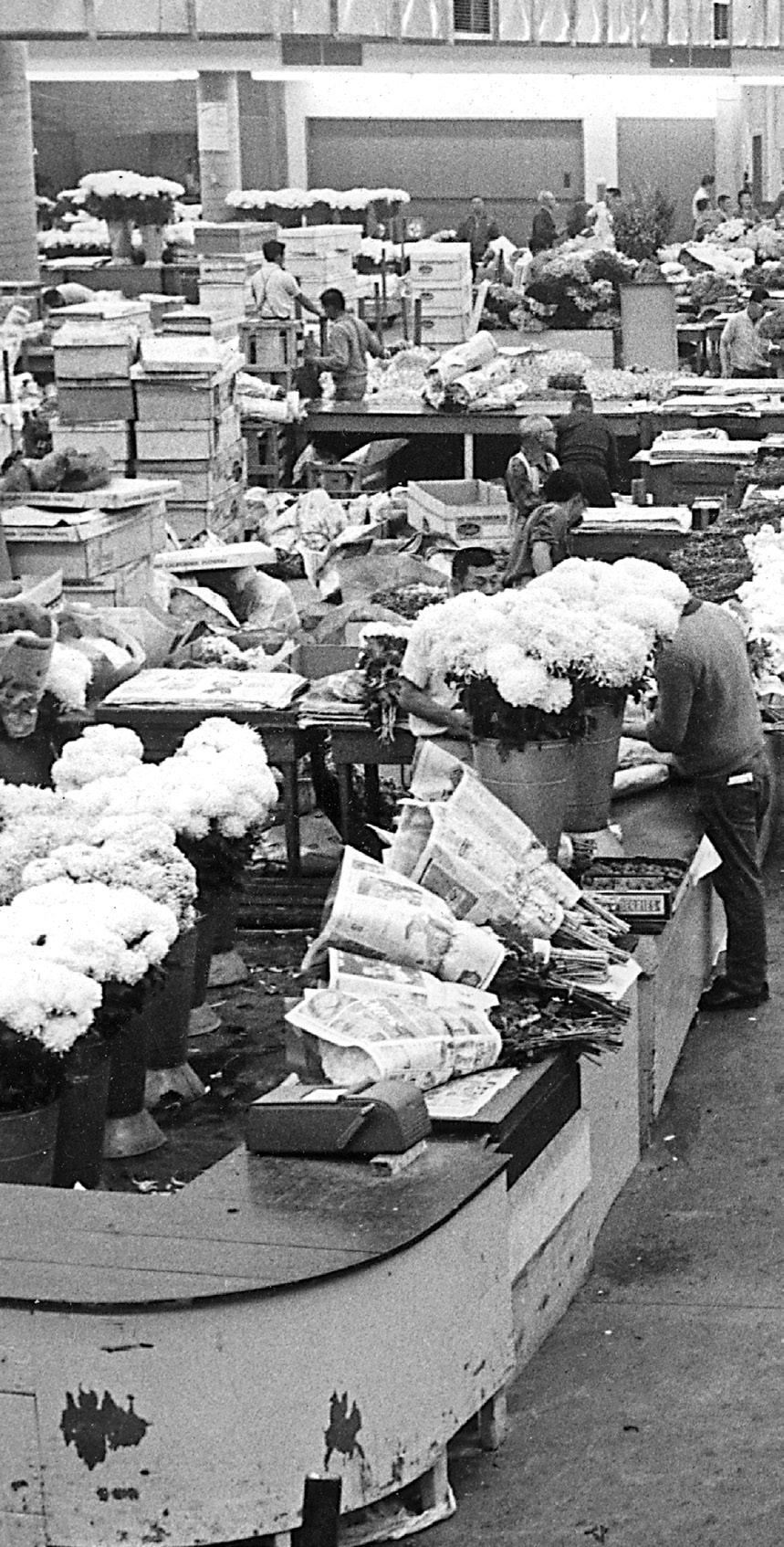
2.
In 1965, the industry took another step forward with the formation of the American Institute of Floral Designers. Started by five LA area designers, AIFD established professional standards for the art of floral design. Members were educated on the latest techniques and could earn the coveted AIFD credential. During this time, one of the most memorable events was the annual Floral Headdress Ball, benefiting the Las Floristas Handicapped Children’s Center. For many years, the Los Angeles Flower Market partnered with Las Floristas to host the signature ball attended by more than 800 guests. The event was as big as Valentine’s Day or Mother’s Day for the industry, showcasing the incredible artistry and creativity of its talented members. At the ball, women modeled elaborately designed headdresses weighing up to 35 pounds. They used back braces so that all the weight was carried on the hips as they strolled across the stage. The spectacular arrangements featured thousands of fresh cut flowers intricately wrapped around carefully designed armatures. Guests and media were wowed by the stunning designs.
The Bloomin' News 20
1.
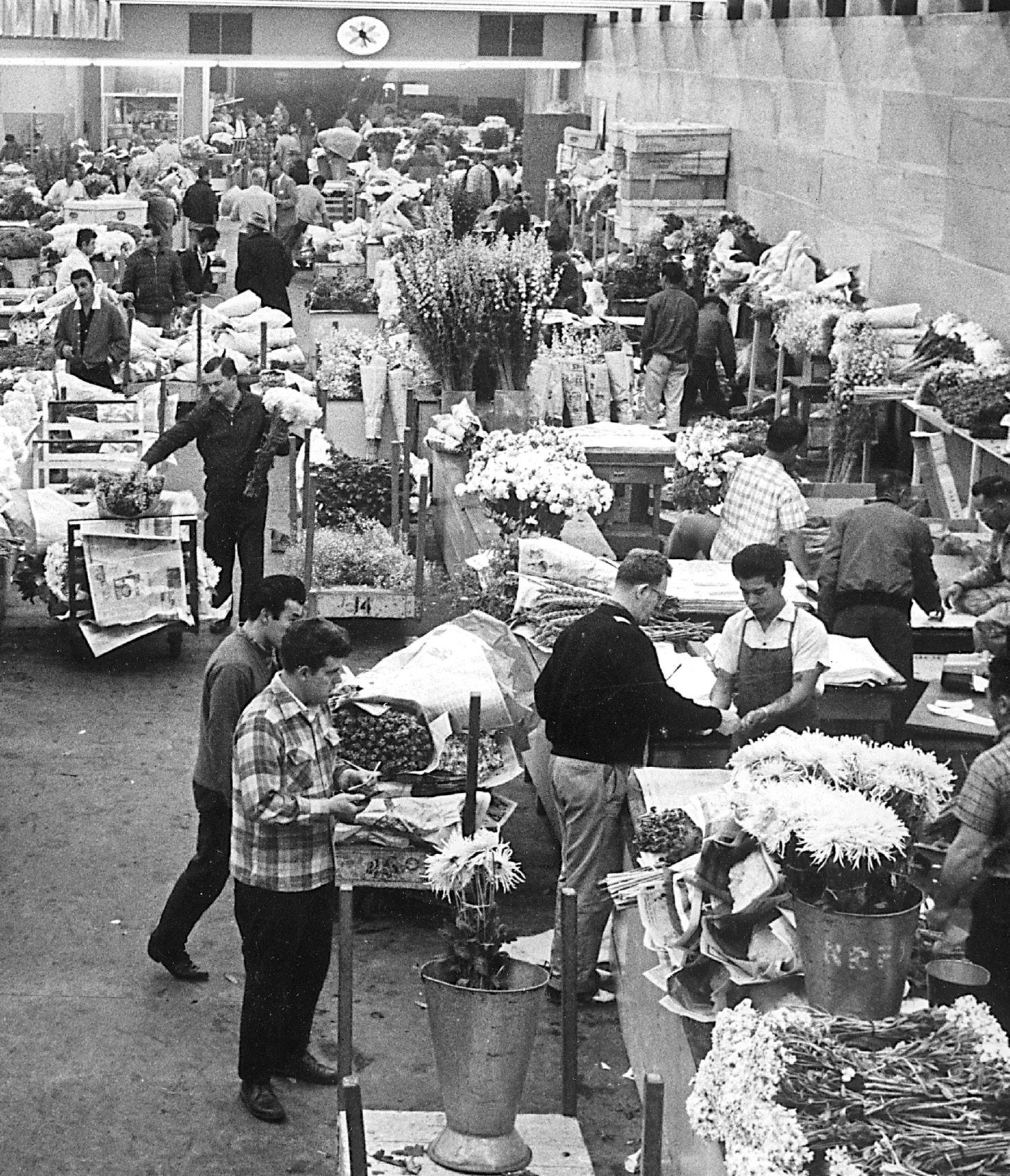
“BY 2:00 AM, FROM TORRANCE AND AZUSA, FROM VENTURA AND ESCONDIDO, FROM SAN FRANCISCO AND SAN DIEGO, THE FLOWER MERCHANTS BEGIN TO CONVERGE ON WALL STREET, THE HEART OF LOS ANGELES’ MULTIMILLION-DOLLAR FLOWER MARKET, THE LARGEST WHOLESALE FLOWER MARKET IN THE WORLD.”
WESTWAYS MAGAZINE, 1965
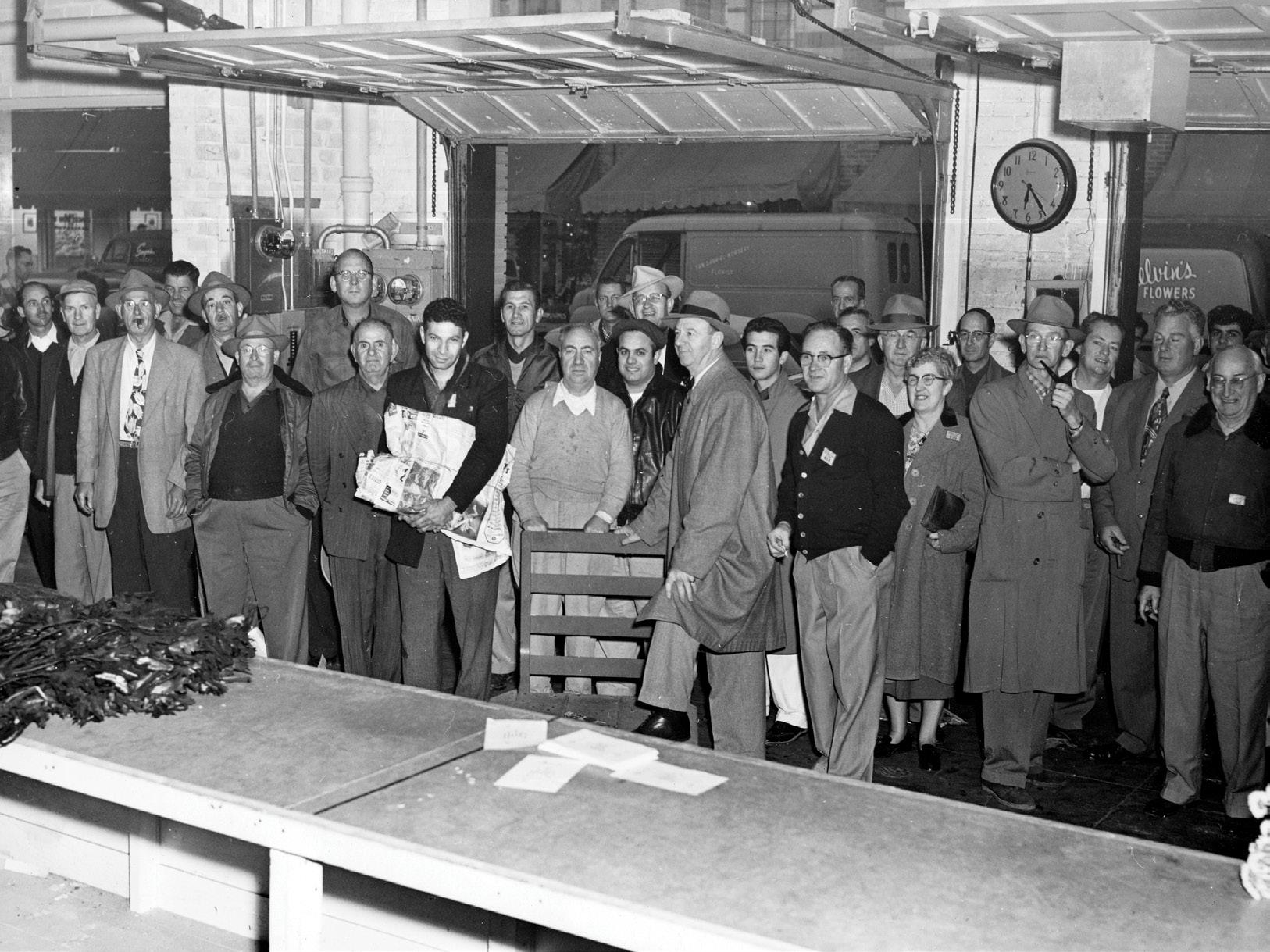
While business was robust, one of the most fondly remembered aspects of the 60s was the sense of friendship and camaraderie felt throughout the industry. Jon Prechtl, whose grandfather was one of the original members of the American Florists’ Exchange, remembers the time well. “Growers, wholesalers and retailers all knew each other back then. We not only did business together, we socialized together,” said Prechtl in a recent interview. “And most importantly, we helped each other out. Whether you needed extra labor or a loan for new equipment, people were there for one another.”
1. Casually posed in front of the American Florists’ Exchange are, from left, C.P. Von Herzen, attorney, George Catlin attorny, Paul Ecke Sr., Frank Blankenship and Kenny Foltz, son-in-law of rose grower C.J. Groen.
2. Customers at The Original Los Angeles Flower Market circa 1960.
3. Retail florists await the 6:30 a.m. opening bell at the Los Angeles Flower Market. Los Angeles Flower Market collection.
21 The Bloomin’ News
3.
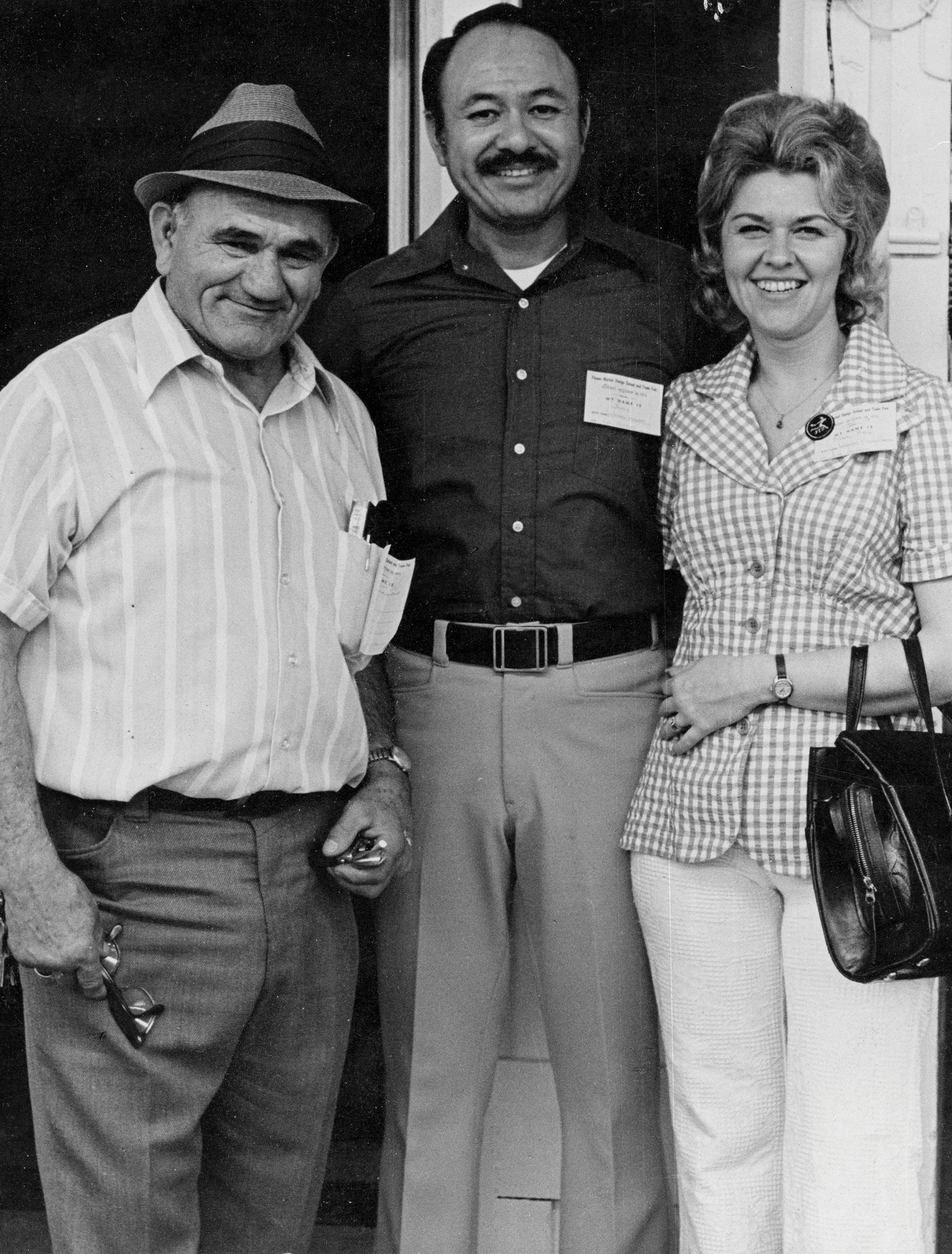
1970s
THE TRANSITION YEARS
Growing opposition to the Vietnam War led to the Flower Power movement.
The counterculture originated on college campuses and spread throughout the U.S. Its members, self-described as “hippies,” embraced natural elements and materials. Flowers symbolized the anti-war movement and drove steady interest and demand for the industry.
In 1973, the U.S. was faced with another unexpected turn…an energy crisis. The Organization of Arab Petroleum Exporting Countries (OAPEC) announced it would no longer ship petroleum to country’s supporting Israel in its conflict with Syria and Egypt. The shortage led to long lines at gas stations and a large spike in fuel costs. Flower growers with green houses to heat were hit particularly hard, especially throughout the winter months.
Another challenge was the influx of imported flowers. With improvements in transportation and technology, more imported flowers began entering the market. Local growers and wholesalers began taking trips abroad to better understand import operations and capabilities. In a trip to Amsterdam, the group saw thousands of fresh-cut flowers passing through a state-ofthe-art, air conditioned and humiditycontrolled facility. Other groups visited flower markets in Holland, Ecuador and Costa Rica to understand their growing conditions and business operations.
Seeing the many advancements in growing, packaging and distribution methods, Southern California growers were convinced of the need for their own expansion and modernization plans.
Talk began of a potential move from downtown to an open suburban location. The American Florists’ Exchange commissioned an indepth study by the United States Department of Agriculture for an objective analysis that would help lead to the best solution. USDA researchers surveyed and spoke with hundreds of floral industry representatives at all levels. The final report pointed out several inefficiencies of the current location from insufficient space and aging infrastructure to inadequate refrigeration and lack of truck docking facilities. In the final assessment, USDA recommended the construction of a new 217,500 square foot building replete with the latest amenities on a 20-acre site in suburban Los Angeles.
The Vietnam War. An Energy Crisis. The “Flower Power” Movement. As the floral industry rolled into the 1970s, growth continued but new challenges arose.
Soon the Los Angeles Times began reporting of a potential move. Cities under consideration were Carson, Pacoima, Santa Fe Springs and the City of Industry, among others. In
The Bloomin' News 22
1.
ITS MEMBERS, SELF-DESCRIBED AS “HIPPIES,” EMBRACED NATURAL ELEMENTS AND MATERIALS. FLOWERS SYMBOLIZED THE ANTI-WAR MOVEMENT AND DROVE STEADY INTEREST AND DEMAND FOR THE INDUSTRY.
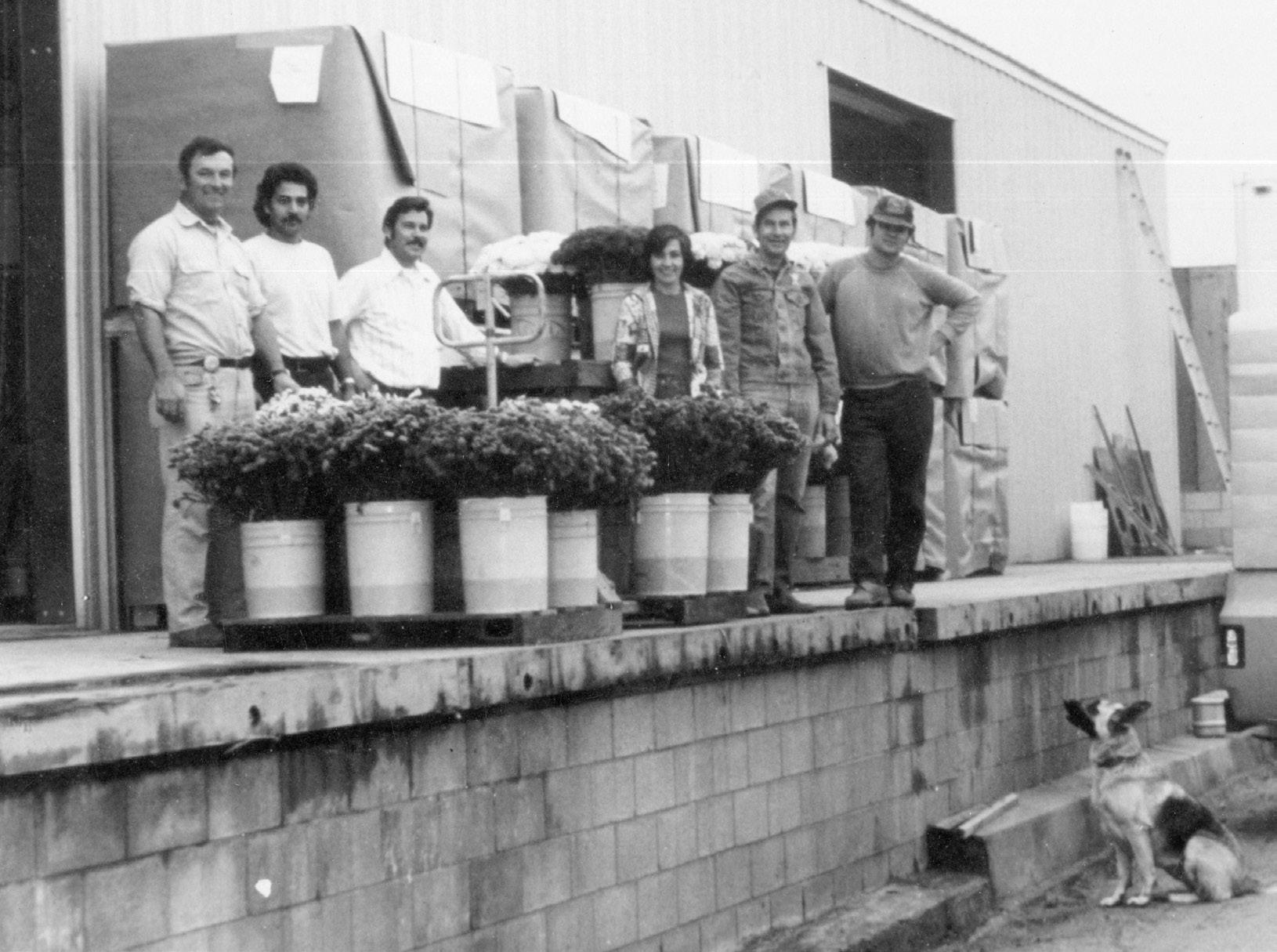
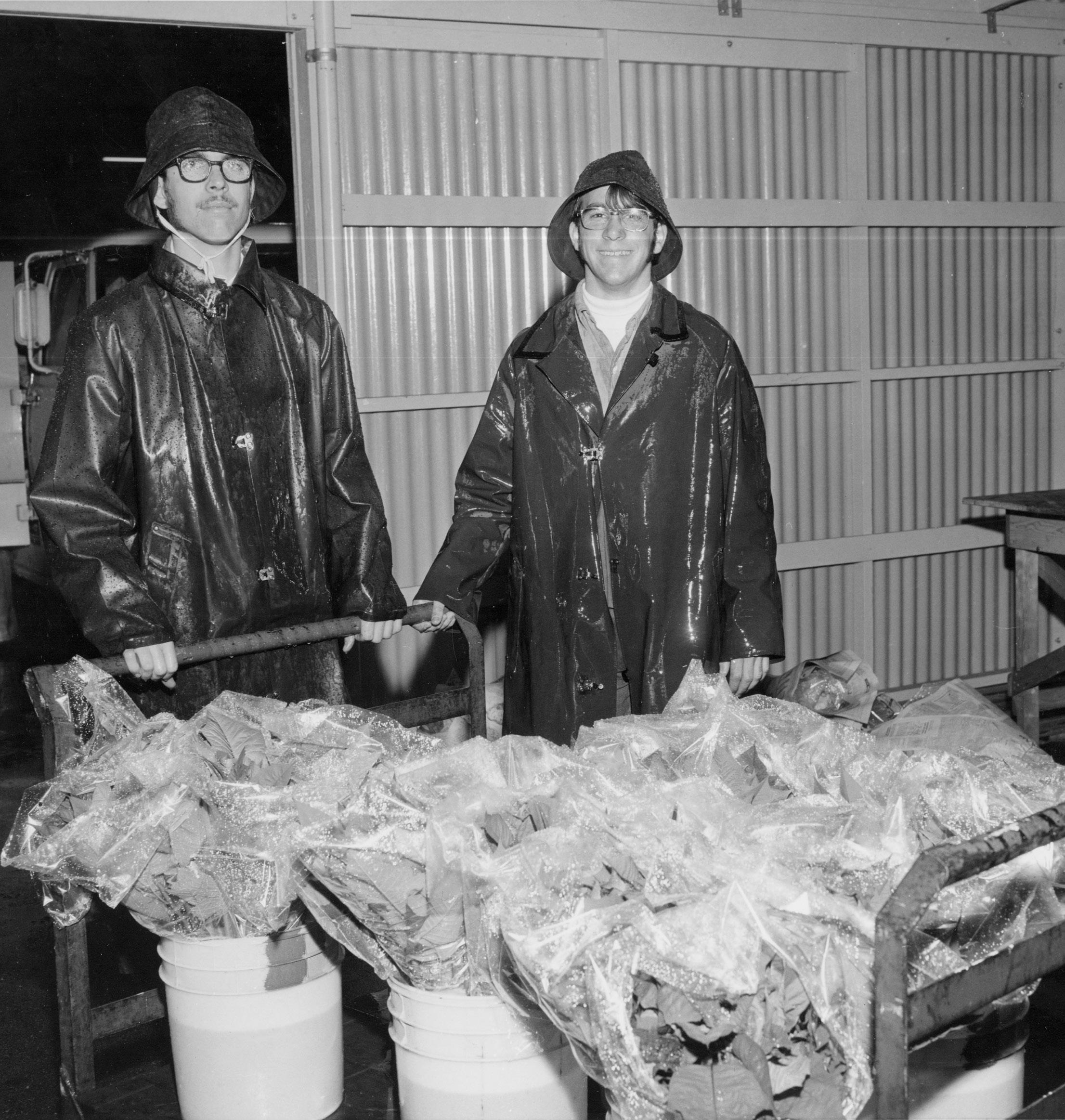
1976, Mayor Tom Bradley visited the wholesale flower district to show his support for keeping the two markets in their current location. He signed two consulting contracts aimed at developing plans for renovation.
Many members felt torn by the decision. The Japanese Americans of The Southern California Flower Market favored staying downtown where their fathers and grandfathers had created the market. The American Florists’ Exchange felt the strong pull of the suburbs and its longterm benefits. AFE seriously considered a move to the City of Commerce where they could purchase a former Goodyear Plant for $3 million. It was a large sum in the 70s, but many felt it would be a smart investment in the industry’s future.
In the end, both markets decided to remain in their current downtown locations. Instead of relocation, revitalization was seen as the way forward.
1. Frank Vescio, Market manager, left, with flower Market visitors, 1970s. Vescio collection.
2. Frank Winter , left, and his brother Duane, grandsons of Paul Ecke Sr. assisting in the Ecke Ranch’s holiday sale area at the Market, 1971.
3. Some of the employees in the early days of the Mellano farm at San Luis Rey, 1970, from left: Battista Castellano, Lupe, Fred Elmendorf, local grower Mrs. Johnson, another local grower and Mike Mellano Sr. 2.
23 The Bloomin’ News
3.
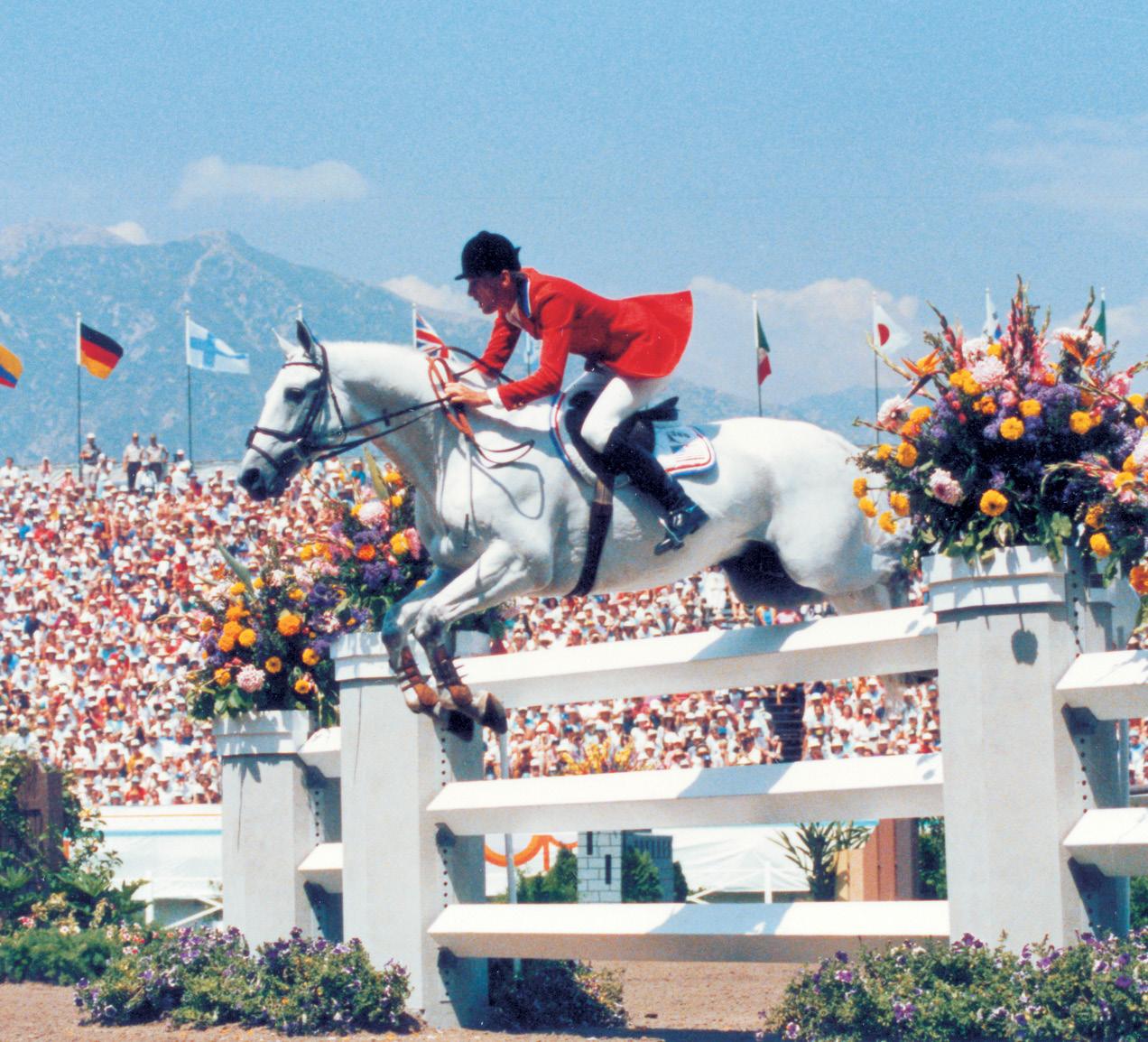
19 80s NAVIGATING CHANGE
The 1980s was about embracing change. It was the only way for the industry to stay viable. The American Florists’ Exchange continued to enlarge and renovate its facilities. In some cases, 35-year-old workspaces were renovated with new walls, coolers and counters. Refrigeration was added along with better lighting, drain feeders and fire sprinklers. Key areas were reconfigured, while adjacent buildings were purchased and completely reconstructed. These improvements and expansions, along with the new building constructed in the 70s, greatly improved AFE’s ability to serve its tenants.
While facility improvements were making business easier, another dynamic was taking place. The flower farms that once blanketed Los Angeles were vanishing. The urbanization of the city had forced many farmers to relocate to more open land in San Diego and Santa Barbara counties. Some growers simply sold their land, while others reduced the size of their operations. As imported flowers increased and became part of the norm, many growers and wholesalers changed their business strategies. They began purchasing imported flowers to offer more variety to their customers. The impact of imported flowers was felt on multiple levels. East coast buyers that used to purchase from California now had an abundant supply of imported flowers readily available for purchase. Secondly, large quantities of inexpensive flowers grown abroad opened up opportunities for mass markets to offer floral bouquets and potted plants in store. The trend to sell flowers in supermarkets and discount stores grew quickly and hit retail florists hard. Many florists were forced to close their doors, while others pivoted to new strategies.
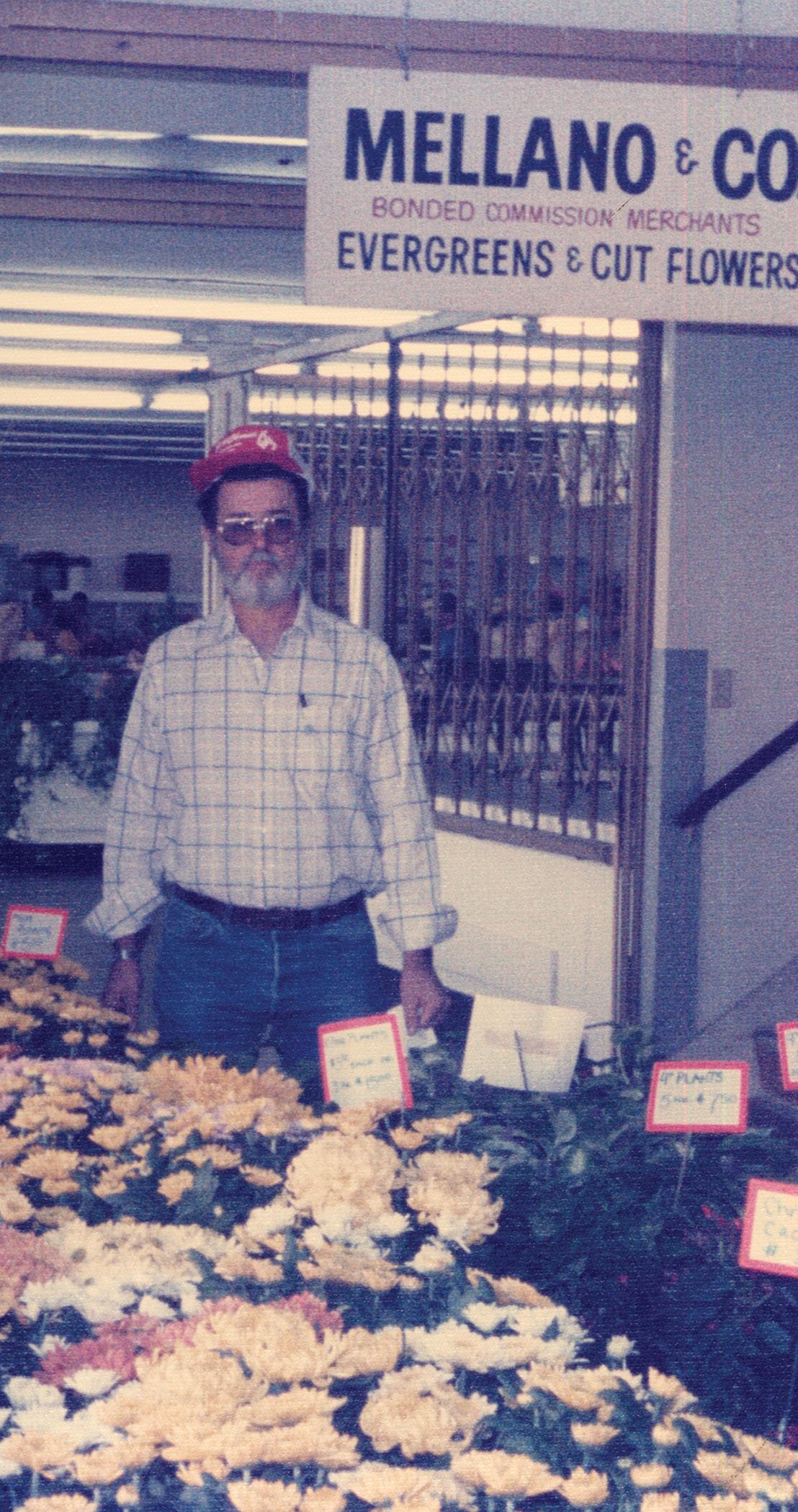
The Bloomin' News 24
1. 2.
THE IMPACT OF IMPORTED FLOWERS WAS FELT ON MULTIPLE LEVELS. EAST COAST BUYERS THAT USED TO PURCHASE FROM CALIFORNIA NOW HAD AN ABUNDANT SUPPLY OF IMPORTED FLOWERS READILY AVAILABLE FOR PURCHASE.
Though it was a challenging time, the industry learned to adapt. In a 1988 issue of Bloomin’ News, Southern California Floral Association Executive Vice President Michael Bradley offered these comments: “Imports have been rather controversial…but these products have found a place in our markets and will continue to thrive. As long as imports meet our legal requirements and clear customs, they will keep increasing the consumption of our products as well as the outlets which sell them.”
Growers continued to evolve their practices to keep up with the changing dynamics. Those with larger facilities could assemble bouquets destined for grocery stores and include both imported and Californiagrown blooms in the bouquets.
As competition increased along with farming costs and government regulations, many chose to exit the business. For some, their children were reluctant to take over the family farms. For others, they preferred different career paths for their children knowing how difficult it was becoming to make a profit.
Throughout the 80s, more and more flower distribution warehouses popped up outside of Los Angeles. Florists now had
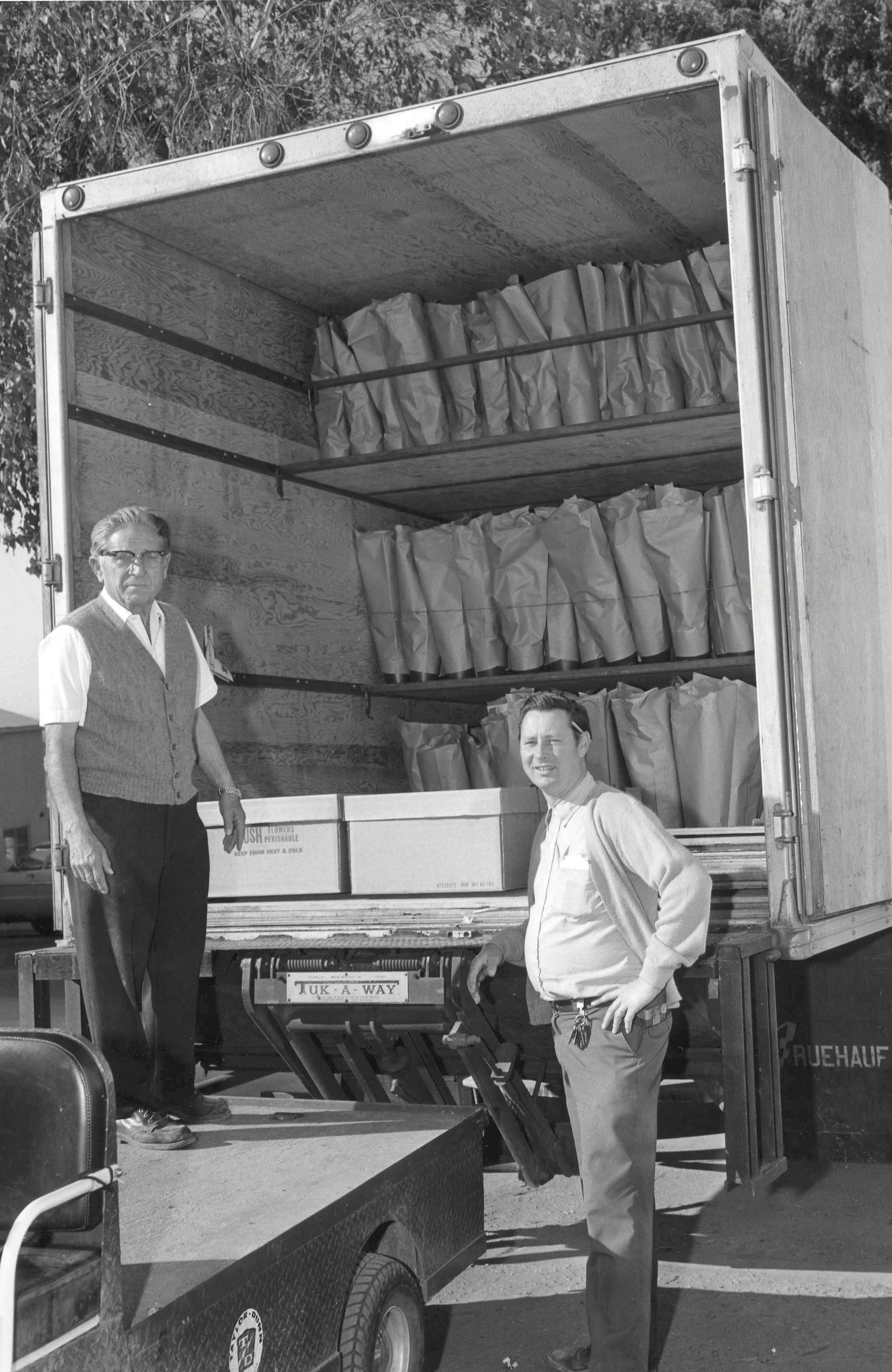
several suppliers nearby and were able to deliver. Florists still visited the downtown market but less often. When they did visit, they were primarily focused on specialty blooms or products with better pricing. With the increased competition from supermarkets, retail florists were forced to focus on what they truly do best…special events and weddings. No one else could provide the floral design talent required for such special occasions. Event planners would continue to look to retail florists to create stunning bouquets and artful arrangements that not only make a statement but truly leave a lasting impression.
1. Bob Berry designed the flowers for the equestrian events at Santa Anita Park during the Olympic games heald in Loas Angeles in summer 1984.
2. Johnny Mellano at Mellano & Co.
3. Paul Ecke Sr., left, and Edgar Engert, Ecke Ranch operations manager, load poinsettias to be trucked to Los Angeles Flower Market, 1980s.
25 The Bloomin’ News
3.
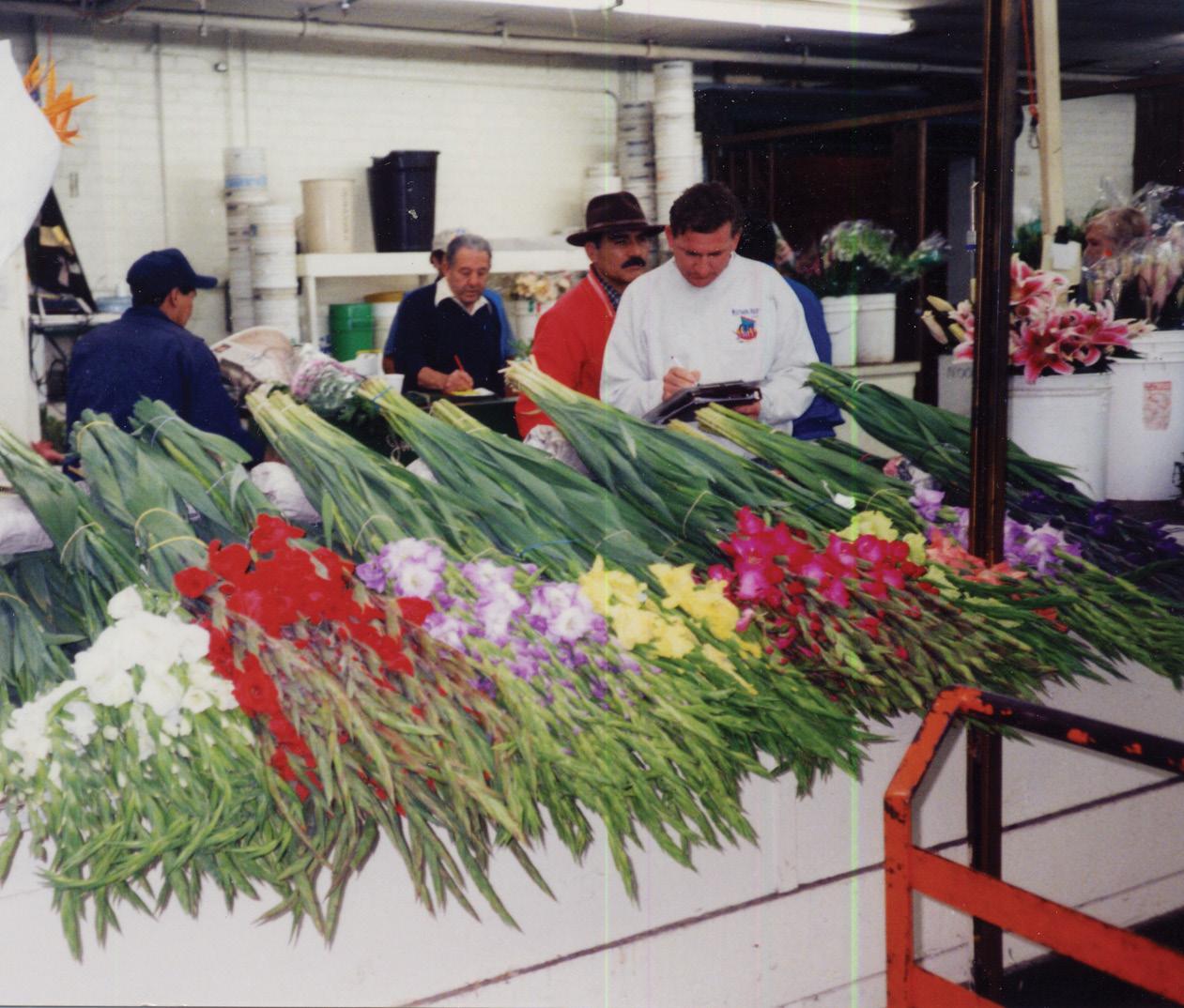
19 90s
INCREASED CONSUMER CONNECTION
The World Wide Web went live to the world in 1991 and its popularity soared. Thousands of retail and wholesale florists launched their own websites. Technology expanded from basic websites to more sophisticated programs that streamlined everything from ordering to processing to delivery. Day-to-day business operations could be increasingly handled online. Major wire services like Teleflora and FTD began to expand their services and made floral purchases easier than ever for consumers.
As the business dynamics continued to change, the Los Angeles Flower Market made a controversial decision. For the first time, it opened its doors to the public. Immediately following early morning wholesale hours, public guests could enter the market under the “badge program” and purchase flowers and foliage directly from the sales floor. Initially, many tenants had concerns about the new direction, but it proved to be a sound business-building strategy. A few months after launching the program, the Tenants Advisory Board conducted several surveys with tenants and retail customers. The wide majority submitted positive comments. Within the first year, the badge program had more than 3,500 members and over 80 percent of Flower District tenants supported it. As highlighted in the book Sending Flowers to America, “Today, one can shop the Market and encounter mothers and daughters, dads and sons and other do-it-yourself flower arrangers shopping for prom, weddings, Quinceaneras and Christening flowers. Downtown residents of the trendy loft apartments and condos casually walk the aisles to find the latest, most intriguing color or exotic and unusual blooms. Opening to the public was the key that unlocked and opened the door to a flood of new customers.”
Another positive impact on the Flower District was the nearby Fashion District. In an effort to turn a rundown neighborhood into a vibrant commercial and residential area, the Los Angeles Fashion District Business Improvement District (BID) was created in 1996. The BID led to the fashion district’s expansion to 90 city blocks,
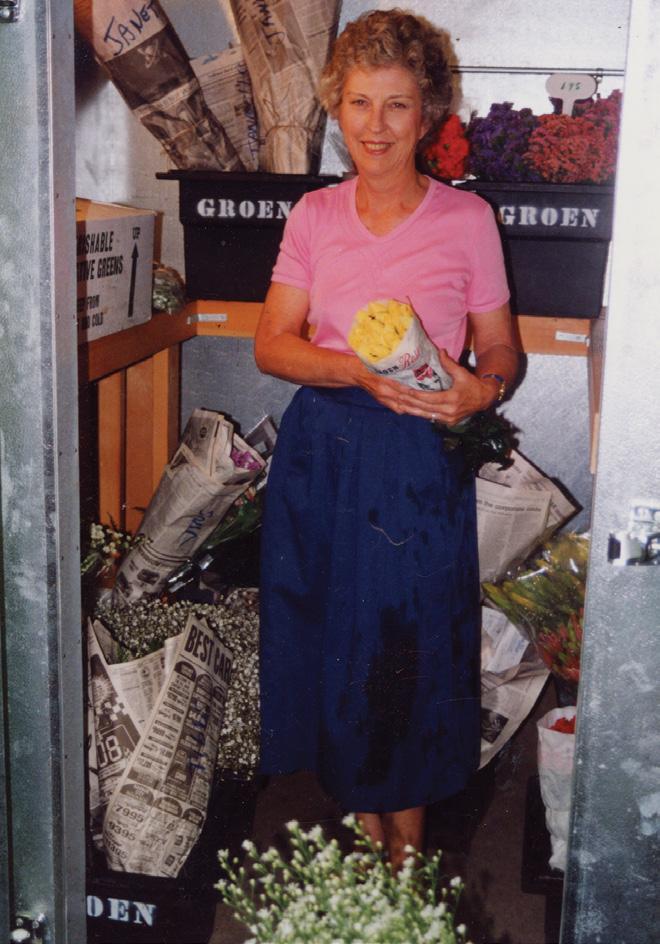
The Bloomin' News 26
1. 2.
THE WIDE MAJORITY SUBMITTED POSITIVE COMMENTS. WITHIN THE FIRST YEAR, THE BADGE PROGRAM HAD MORE THAN 3,500 MEMBERS AND OVER 80 PERCENT OF FLOWER DISTRICT TENANTS SUPPORTED IT.
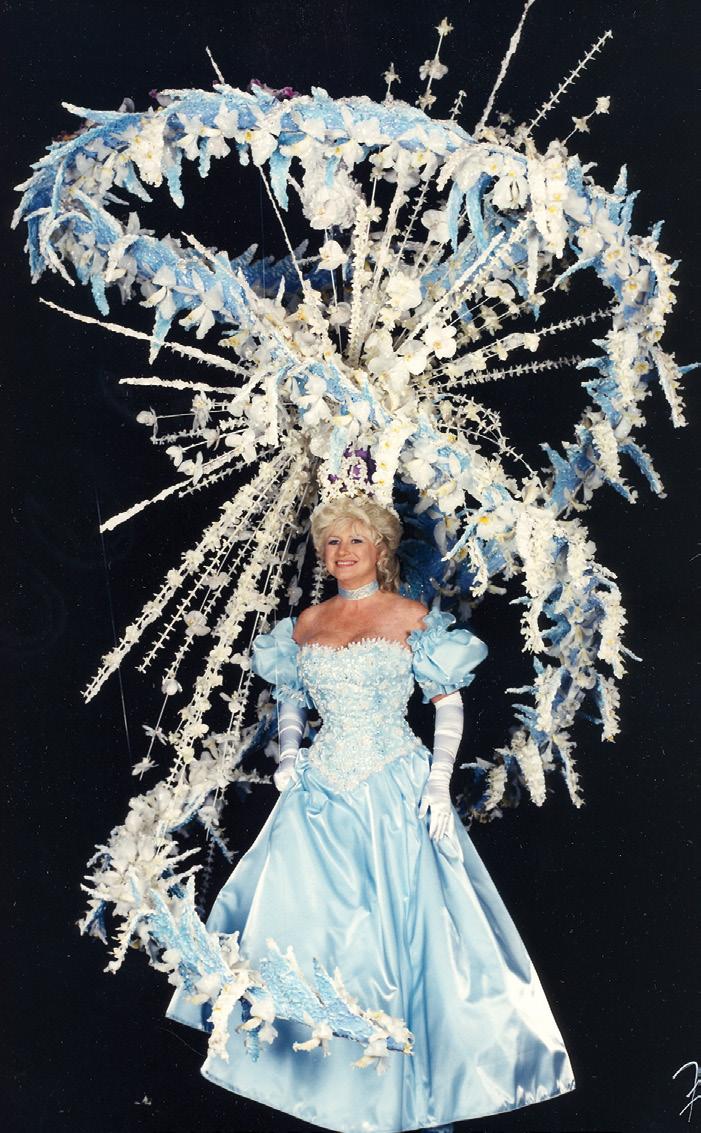
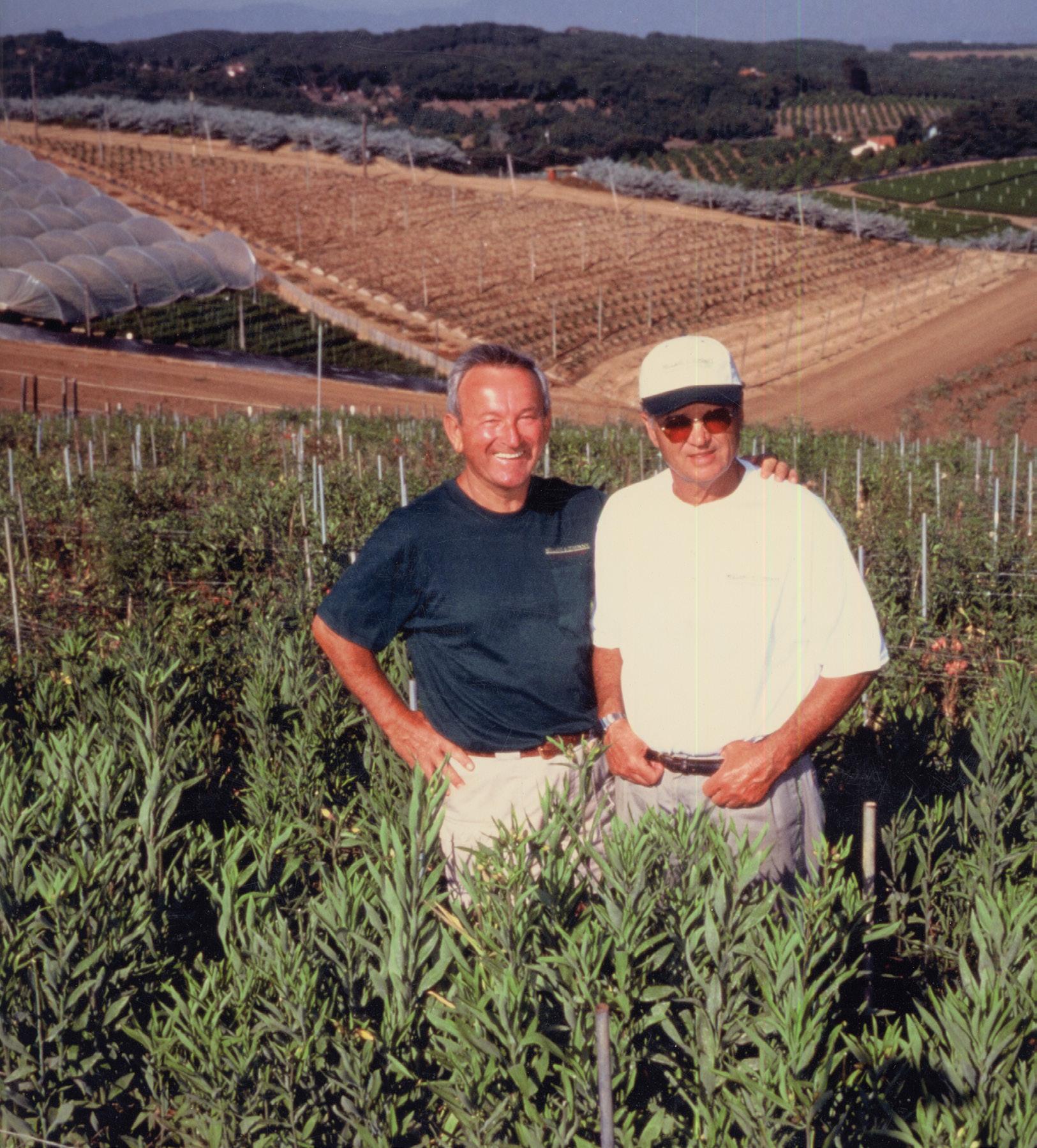
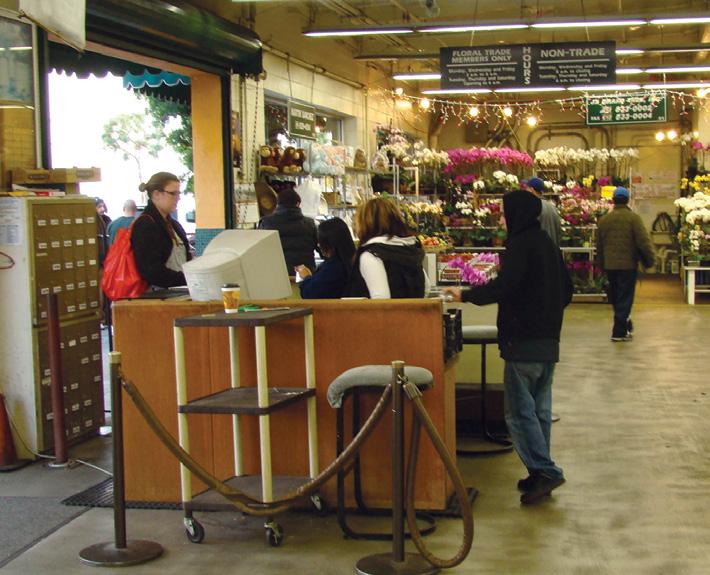
encompassing the LA Flower District that consisted of the two markets, their tenants and merchants, badge members and a myriad of florists and wholesale store fronts located in the surrounding city blocks. In the first five years of the BID program, more than $500 million was spent on renovation and new construction in the area. It brought thousands of new residents and a host of new customers to the Flower District.
Despite the positive momentum, talks continued about potentially moving the flower market to a less-congested location where a state-of-the-art facility could be built. The American Florists’ Exchange commissioned a second study by the U.S. Department of Agriculture to evaluate its options The study noted the disadvantage of one centralized market and instead recommended the development of three to four regional locations. In 1998, the American Florists’ Exchange made an offer to purchase the majority of the growers’ shares of the Southern California Flower Market across the street. After much thought and consideration, SCFM declined the offer.
Once again, the floral industry decided to continue operating from its current downtown location. It had already been through decades of change and would continue to adapt, embracing new technologies and strategic approaches to navigate the changing market needs.
1. Battista Castellano with his business partnerand brother-in-law Michael Mellano Sr, at the Mellano farm in 1998.
2. Sylvia Foltz in the cooling room of the Groen Rose Company nursery in Santa Fe Springs.
3. John Noonan, background center, assists customers with gladiola purchases at the Noonan Wholesale Florist stall in the Los Angeles Flower Market, 1993.
4. Linda Nies as Cinderella with design by Richard Seekins AIFD and Scott Acevedo AIFD, winner of the Las Floristas Headdress Ball Sweepstakes and People’s Choice awards in 1996.
5. Customers checking out at The Original Los Angeles Flower Market.
27 The Bloomin’ News
3.
4.
5.
2000s
THE NEW MILLENNIUM
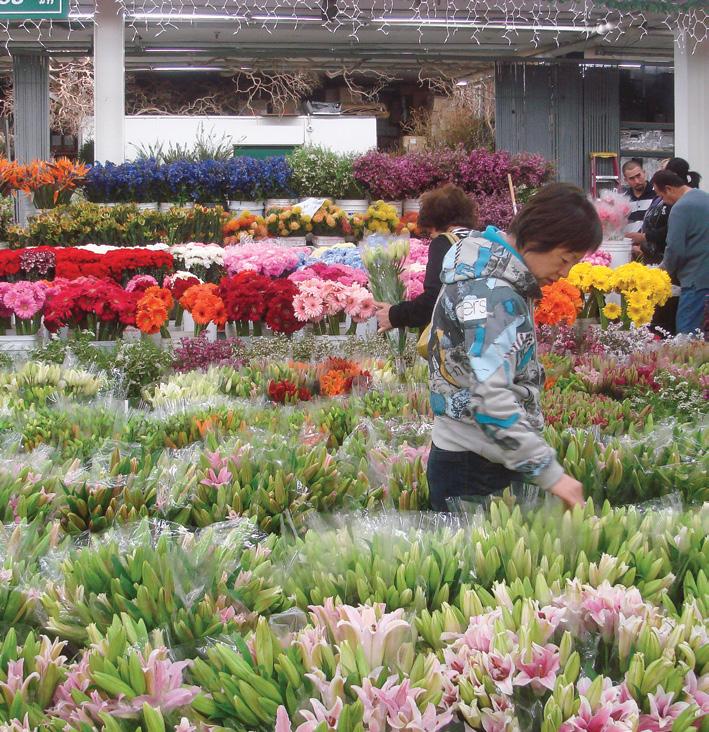
With excitement, and a bit of uncertainty, the world celebrated the arrival of the new millennium. The oncein-a-lifetime occasion added even more fanfare to the renowned Tournament of Roses Parade. Months of farming, elaborate float design, and hundreds of volunteer hours culminated in a spectacle enjoyed around the world on New Year’s Day, 2000.
The following year, the U.S. experienced one of the most tragic days in its history -- the terrorist attacks on September 11, 2001. Like many organizations, the floral industry moved swiftly to offer support. Flowers were sent to family crisis centers and the site where both towers had collapsed. Florists volunteered to make arrangements for memorial and funeral services around the country. Over the next few years, the U.S. would be engaged in a war in Afghanistan and Iraq with the goal of protecting the country from future threats.
At the onset of the twenty-first century, California grown cut flowers and foliage had a wholesale value of more than $330 million annually. The industry supported
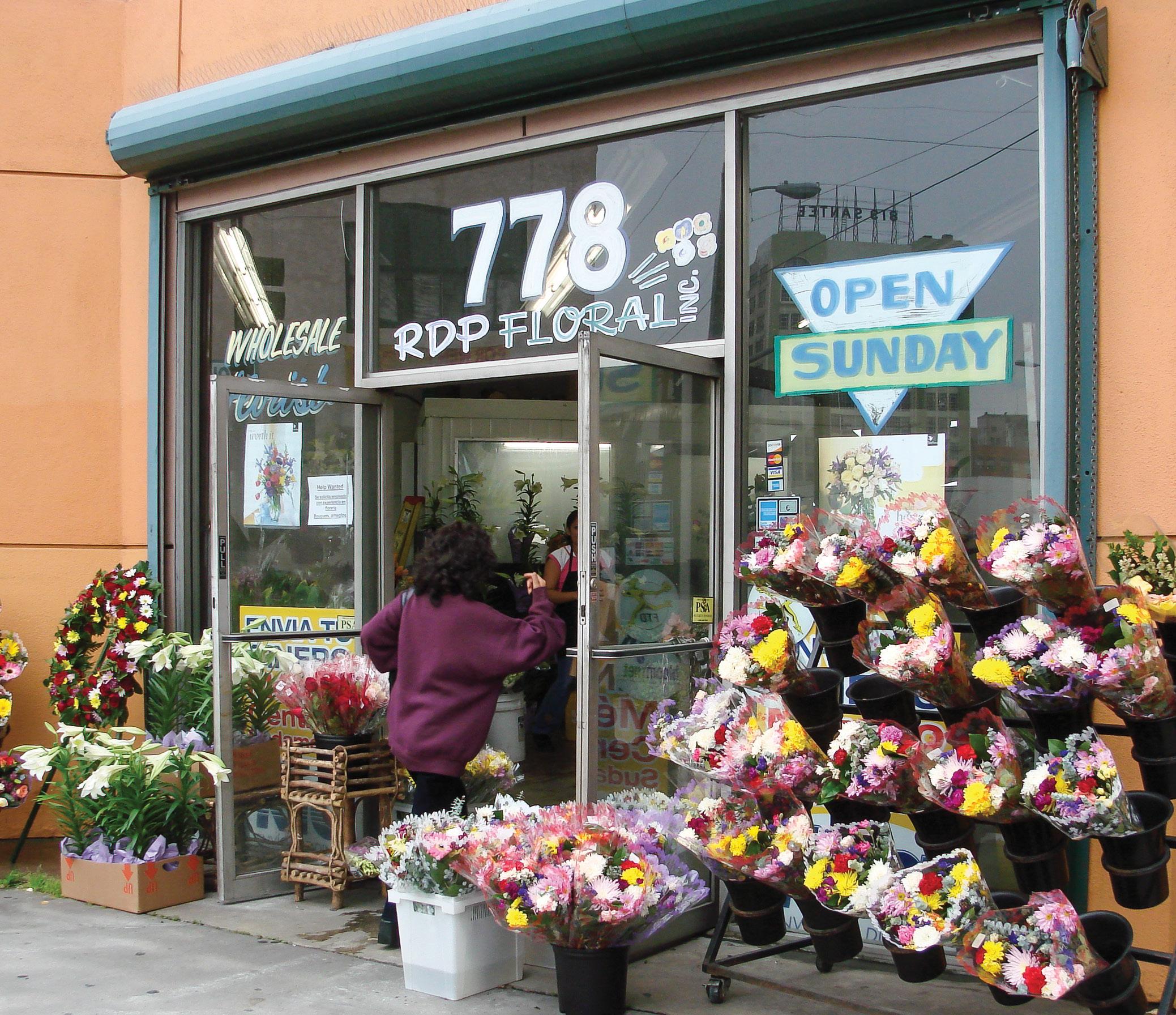
40,000 florists and 24,000 supermarkets.
A new level of competition arrived in the form of large corporations. Dole Foods launched a large-scale operation called Dole Fresh Flowers. Tesco, the most successful retailer in the U.K. and Europe, built its first boutique grocery stores in Southern California including fresh cut flowers as part of its merchandise selection.
Throughout this time, consumers became increasingly interested in products produced in an environmentally responsible fashion. Some flower growers achieved organic certification through the USDA’s National Organic Program. However, given the program was initially developed for food production, many flower growers found it overly restrictive. Instead, many began to adopt a European-inspired program developed by Scientific Certification Systems
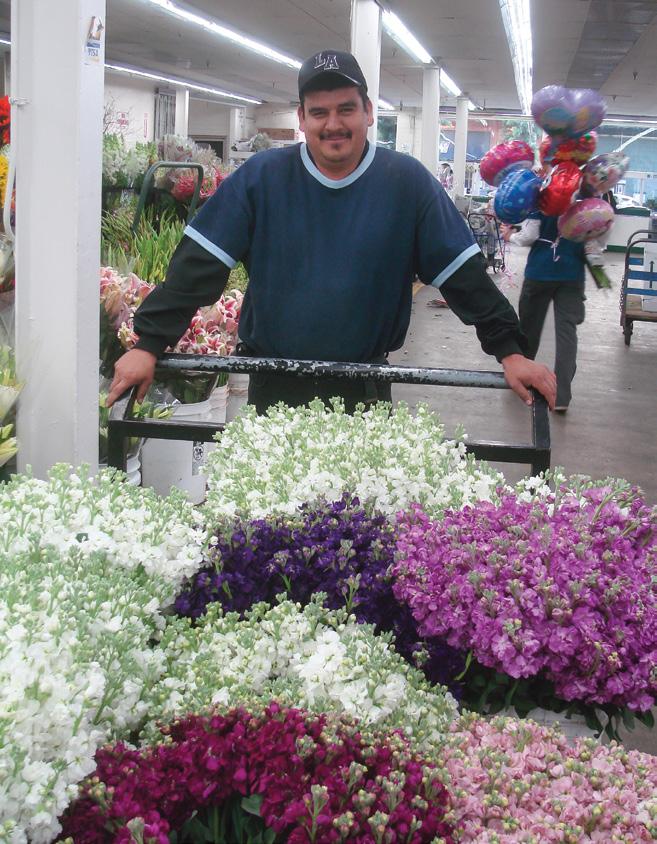
The Bloomin' News 28
1.
2.
3.
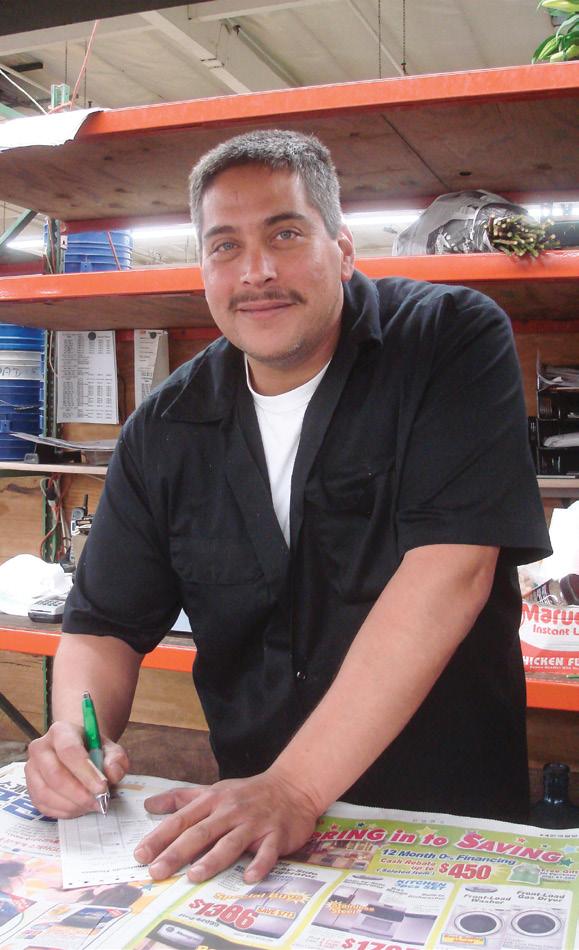
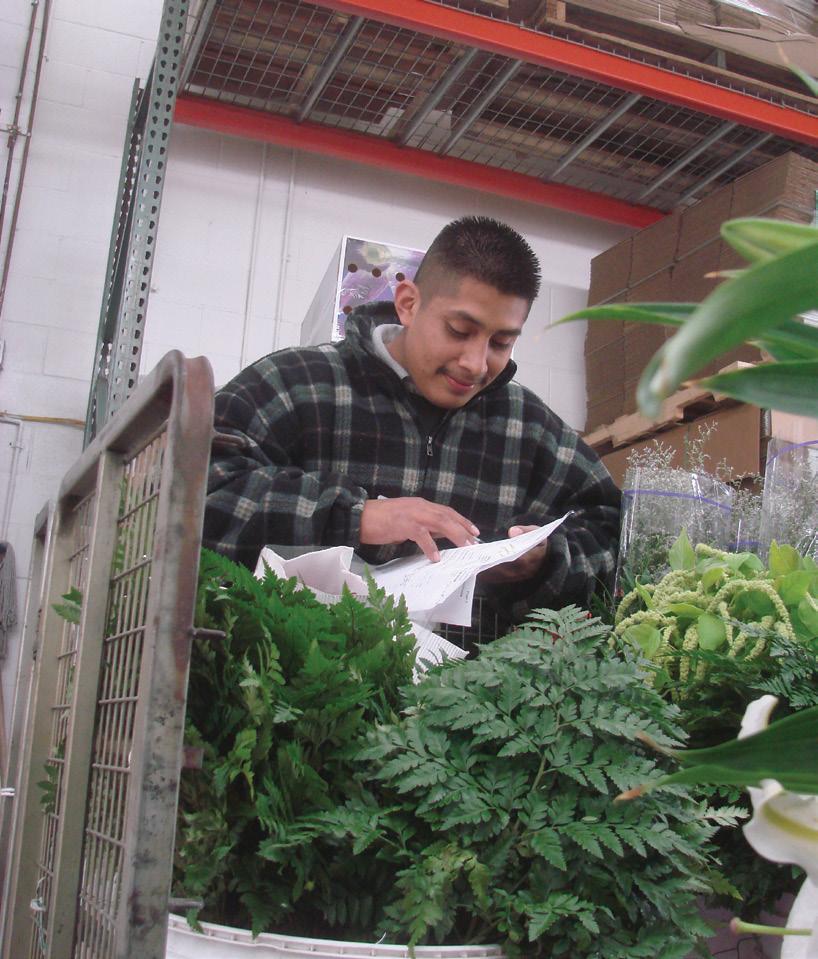
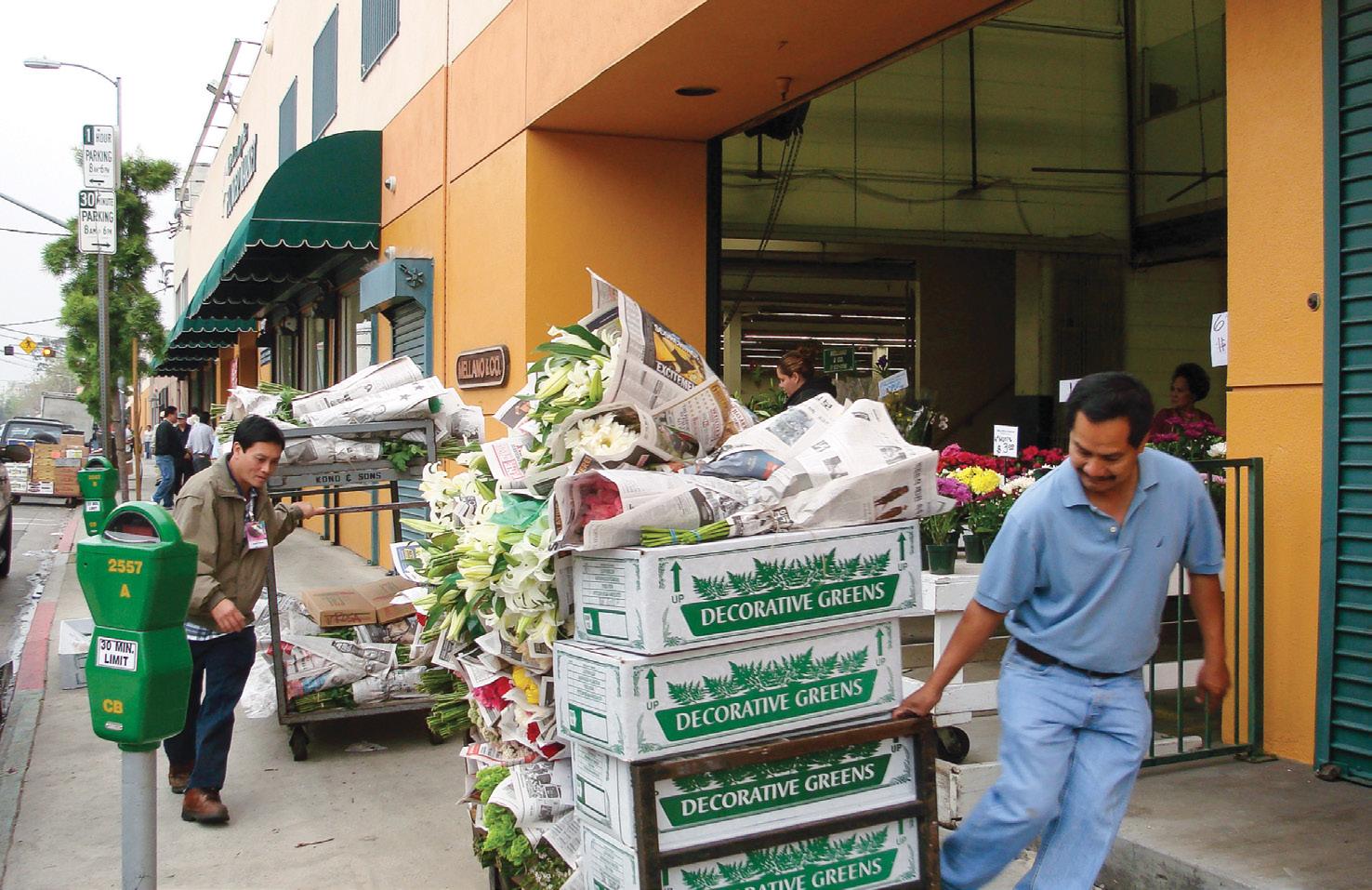
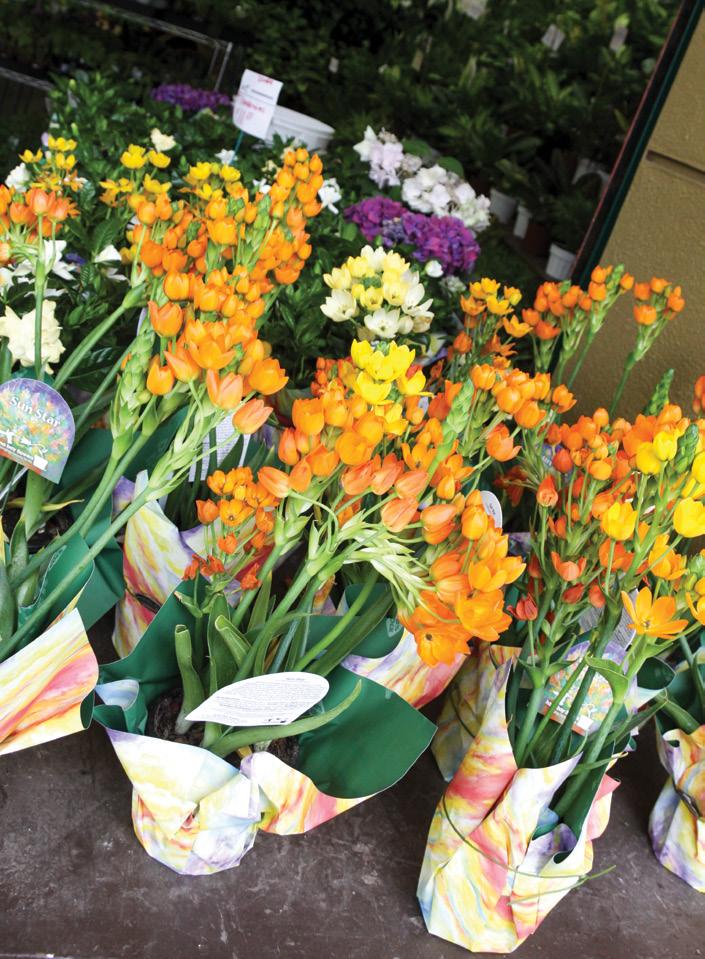
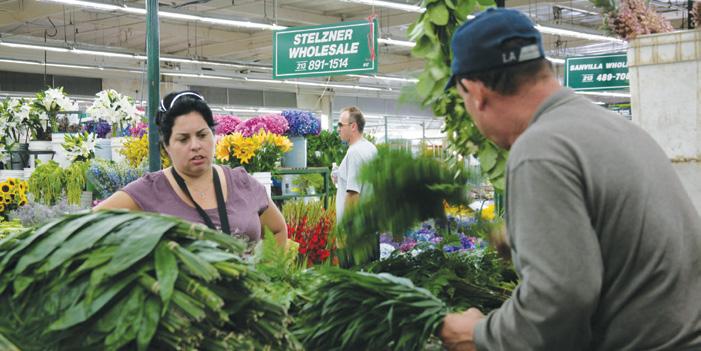
for the North American market. The new VeriFlora program became the template for a new national standard involving soil fertility practices, agrochemical usage, water quality protection measures, workplace social responsibility requirements and more. By 2007, VeriFlora had more than 750 million certified stems in the North American market.
“ON NEW YEAR’S DAY, THE TOURNAMENT OF ROSES PARADE BECOMES THE SHOW OF FLOWERS, WITH ITS MANY FRESH BLOOMS DISPLAYED IN LIVING COLOR EVERYWHERE. MILLIONS OF TELEVISION VIEWERS AROUND THE WORLD AND THOUSANDS WHO LINE THE PARADE ROUTE IN PASADENA SEE A FLOWER SHOW LIKE NO OTHER.”
— RIDGEWAY/WORKS, SENDING FLOWERS TO AMERICA
Given the urban sprawl taking place throughout Southern California, farmland values continued to rise. The high demand for open land, coupled with the lack of “next generation” farmers, prompted many growers to transition out of the business. Those remaining continued to manage farming operations along with the growing responsibility of wholesale distribution. Their commitment and resilience have enabled the LA Flower Market to continue serving as the industry’s largest and most successful distribution center.
1. Customer picks lilies at The Original Los Angeles Flower Market.
2. Customer stands outside of a Los Angeles storefront adorned with a beautiful flower display. 3., 4., 6. Retail florists and vendors of The Original Los Angeles Flower Market circa 2000.
5. Employee checking orders.
7. Flowers ready to be sold outside the market.
8. Stamis employee with customer of the market.
29 The Bloomin’ News
6.
4.
5.
8.
7.
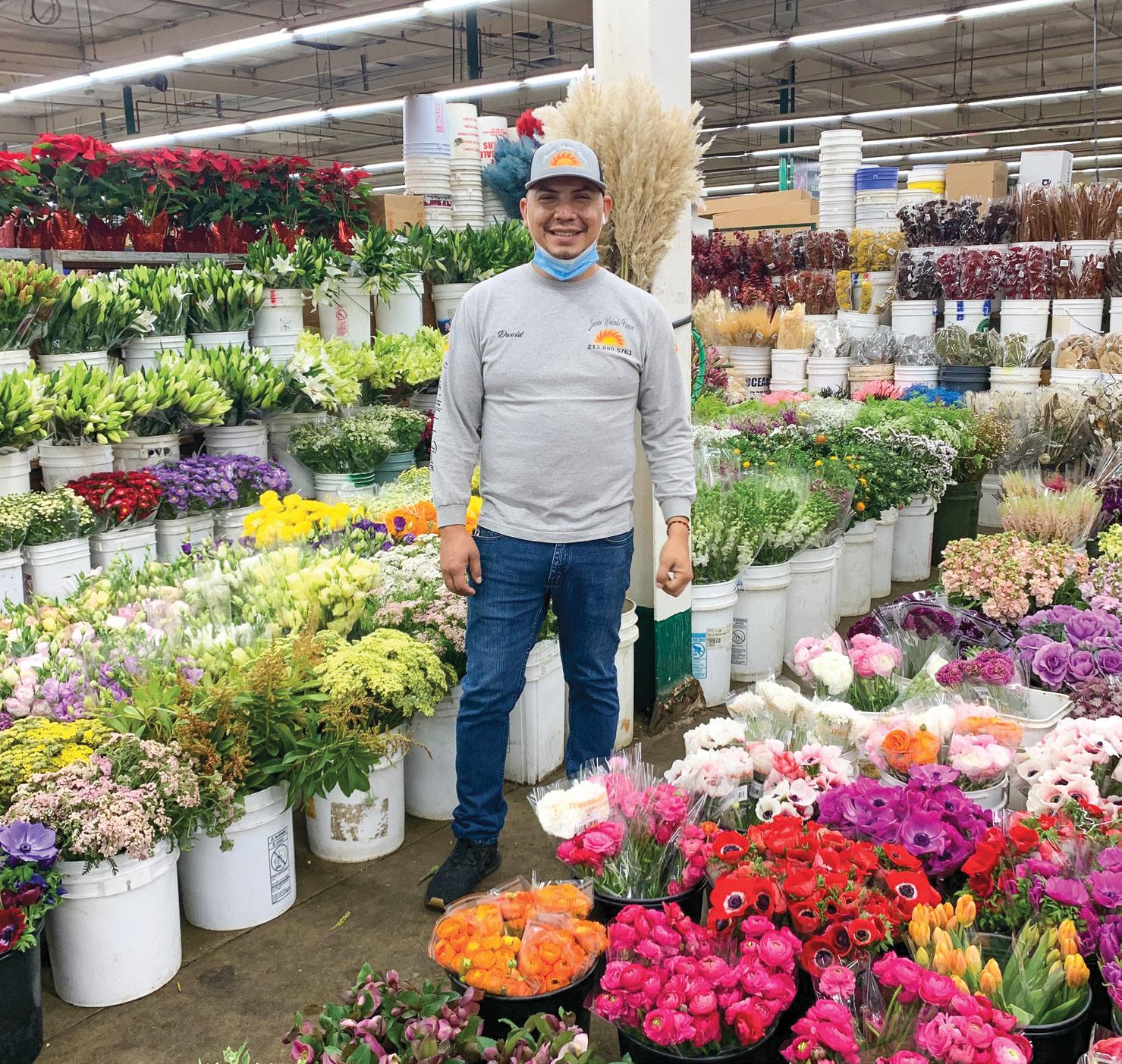
20102020 TODAY
& TOMORROW
What started out with flower growers tending small plots of gladiolas and chrysanthemums in a farm town called Los Angeles led to the formation of the single largest and most successful wholesale floral district in the United States.
Enormous change. Continued education.
Constant perseverance. These are the hallmarks that have shaped the floral industry’s onehundred-year history. Growers relocated their farms to more open land. They became wholesalers of flowers from other countries. They navigated rising costs as well as increased competition at every turn. As the business environment continued to change, growers, wholesalers and retailers adapted along with it.
The Los Angeles Flower Market has anchored the downtown floral district for decades, finding a way to serve the trade as well as the public. It continues to embrace new methods and technologies to support more than 50 members/vendors who together offer more than 125 different floral varieties plus an impressive portfolio of related foliage and floral accessories. Of great note was the move to go solar. In 2011, the Original Los Angeles Flower Market transformed its main facility into a modern, state-of-the-art solar-power showcase interconnecting eight different rooftops. This made it one of the largest solar installations in the City of Los Angeles. This green rooftop movement stretches across nearly an entire city block.
It seems fitting that such delicate, perishable products could only be represented by an industry strong enough to bend and flex with the numerous changes experienced over the past century. The growers, vendors and members of the Los Angeles Flower Market continue to shine brightly as the heart of the industry. One that is uniquely capable of bringing color, joy and beauty to the world.
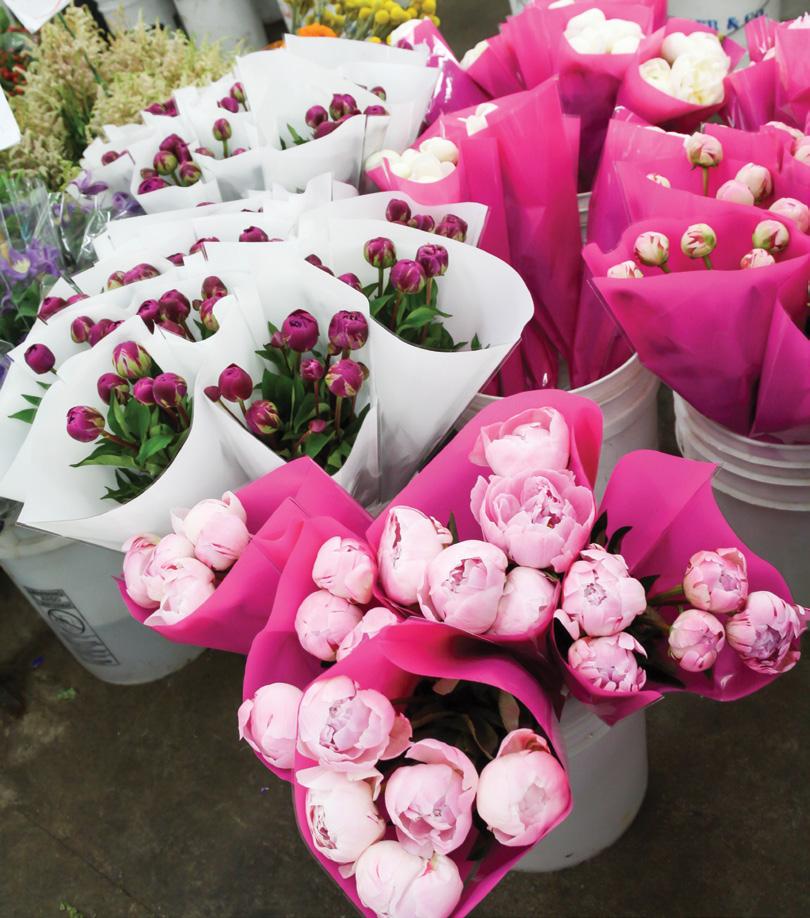
The Bloomin' News 30
1. 2.
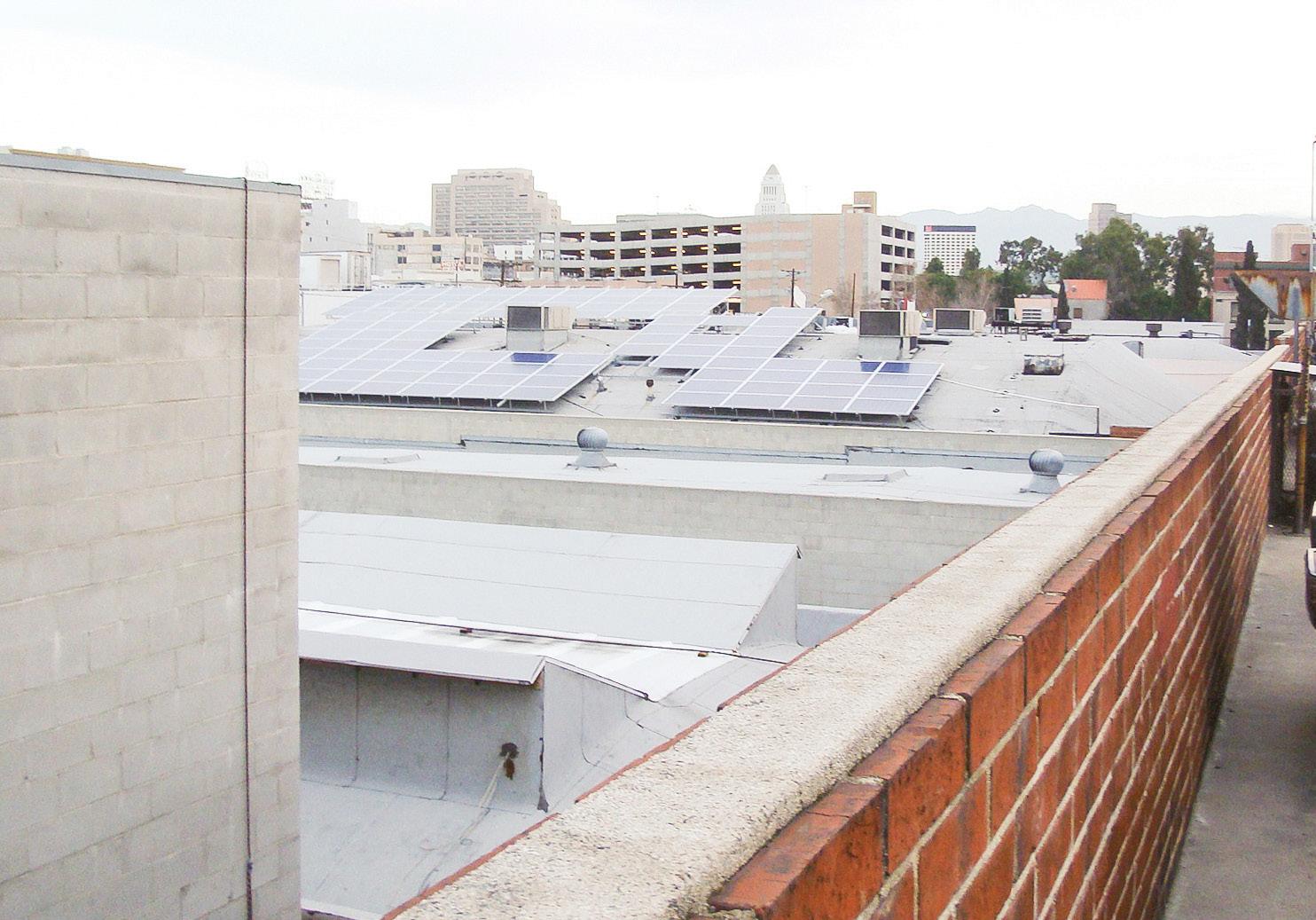
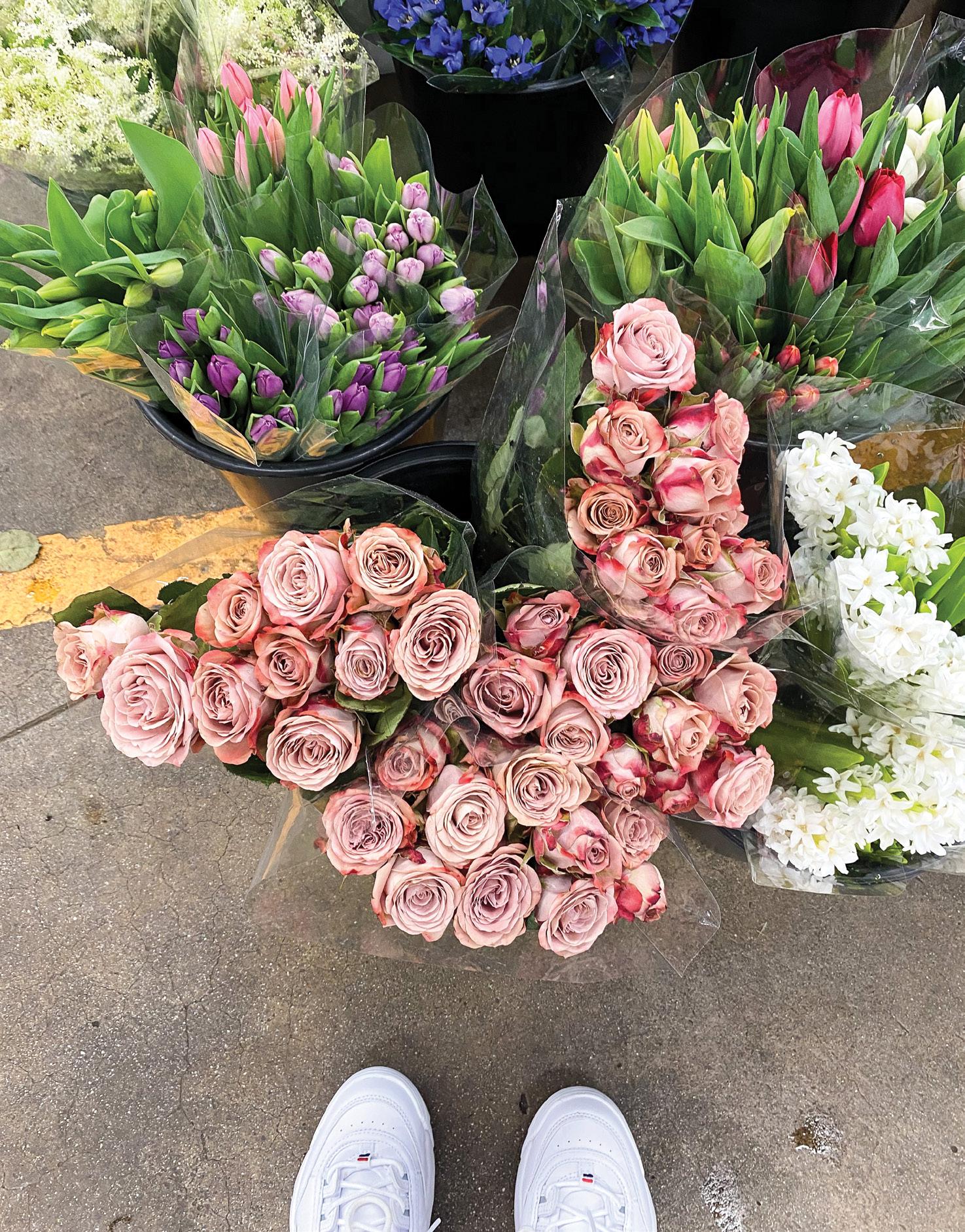
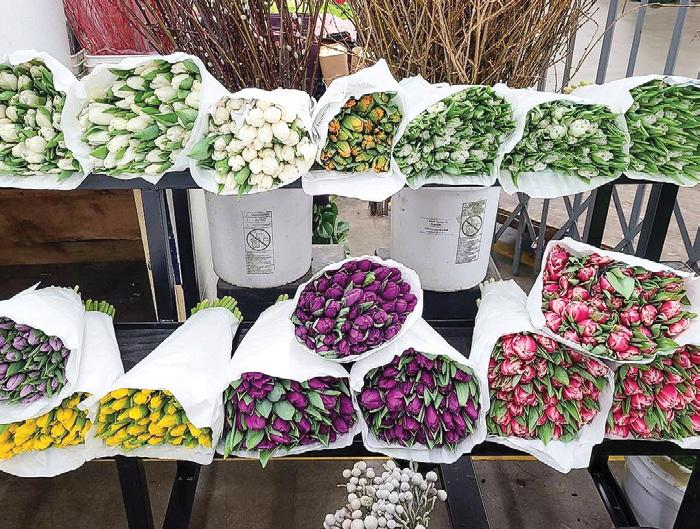
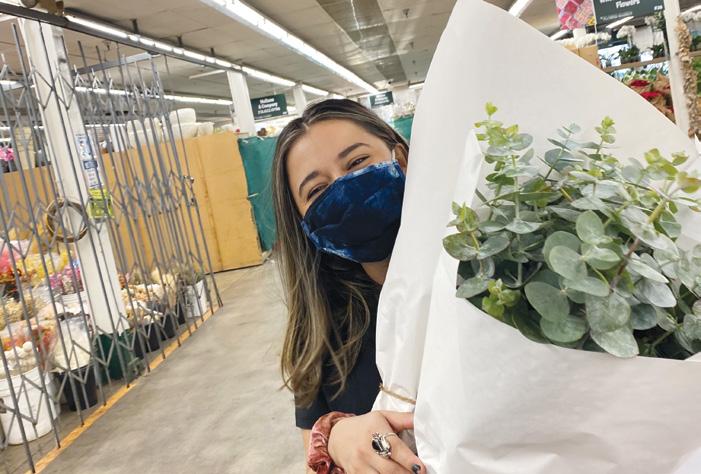
1. David Ramirez, owner of Sunrise Wholesale Flowers Inc. (2020).
2. Peonies at the market.
3. The Original Los Angeles Flower Market goes solar in 2011.
4. NL Flower Wholesale display at the market.
5. Customer with Eucalyptus while being Covid friendly.
31 The Bloomin’ News
IN 2011, THE ORIGINAL LOS ANGELES FLOWER MARKET TRANSFORMED ITS MAIN FACILITY INTO A MODERN, STATE-OF-THE-ART SOLAR-POWER SHOWCASE INTERCONNECTING EIGHT DIFFERENT ROOFTOPS.
3.
5.
4.
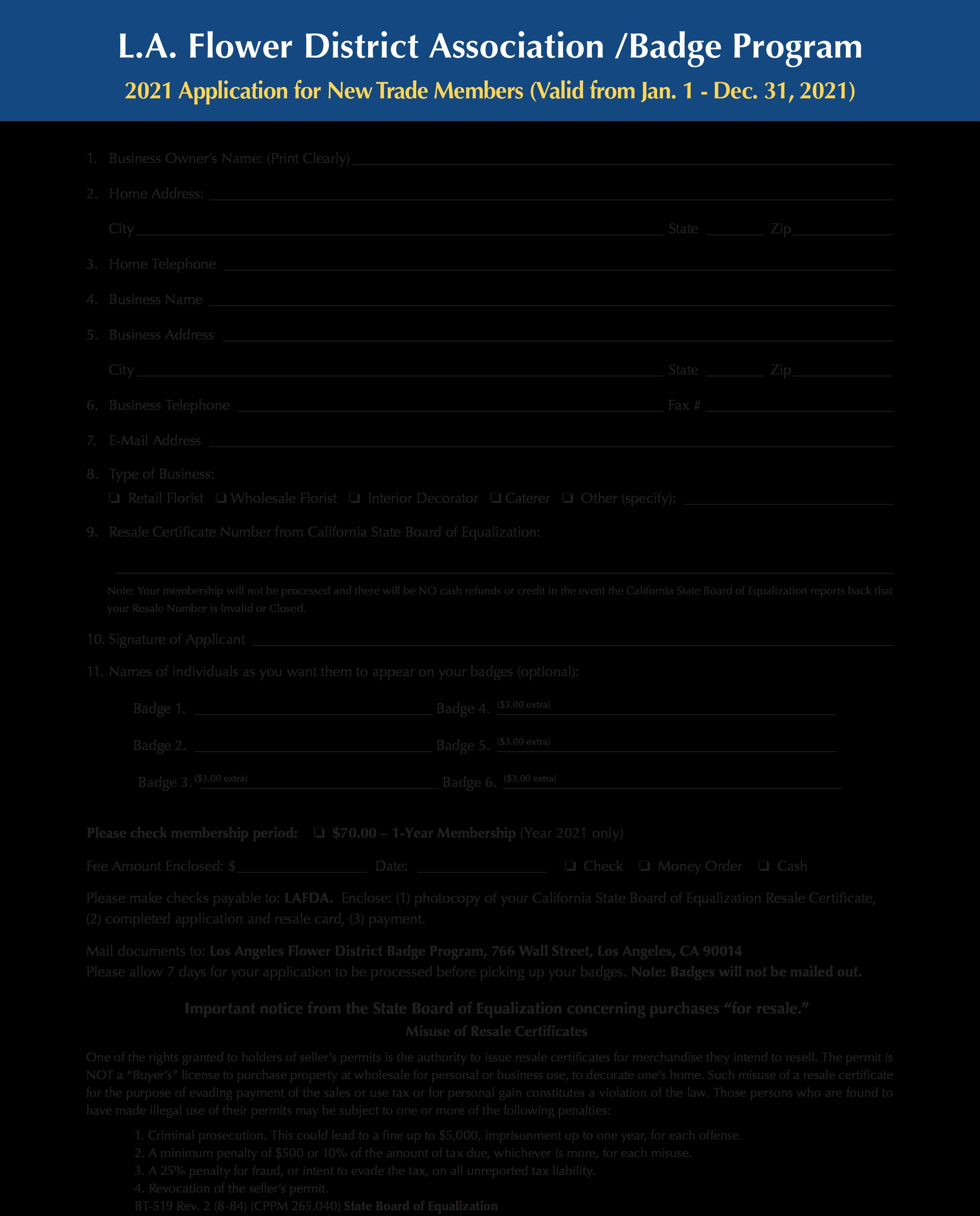
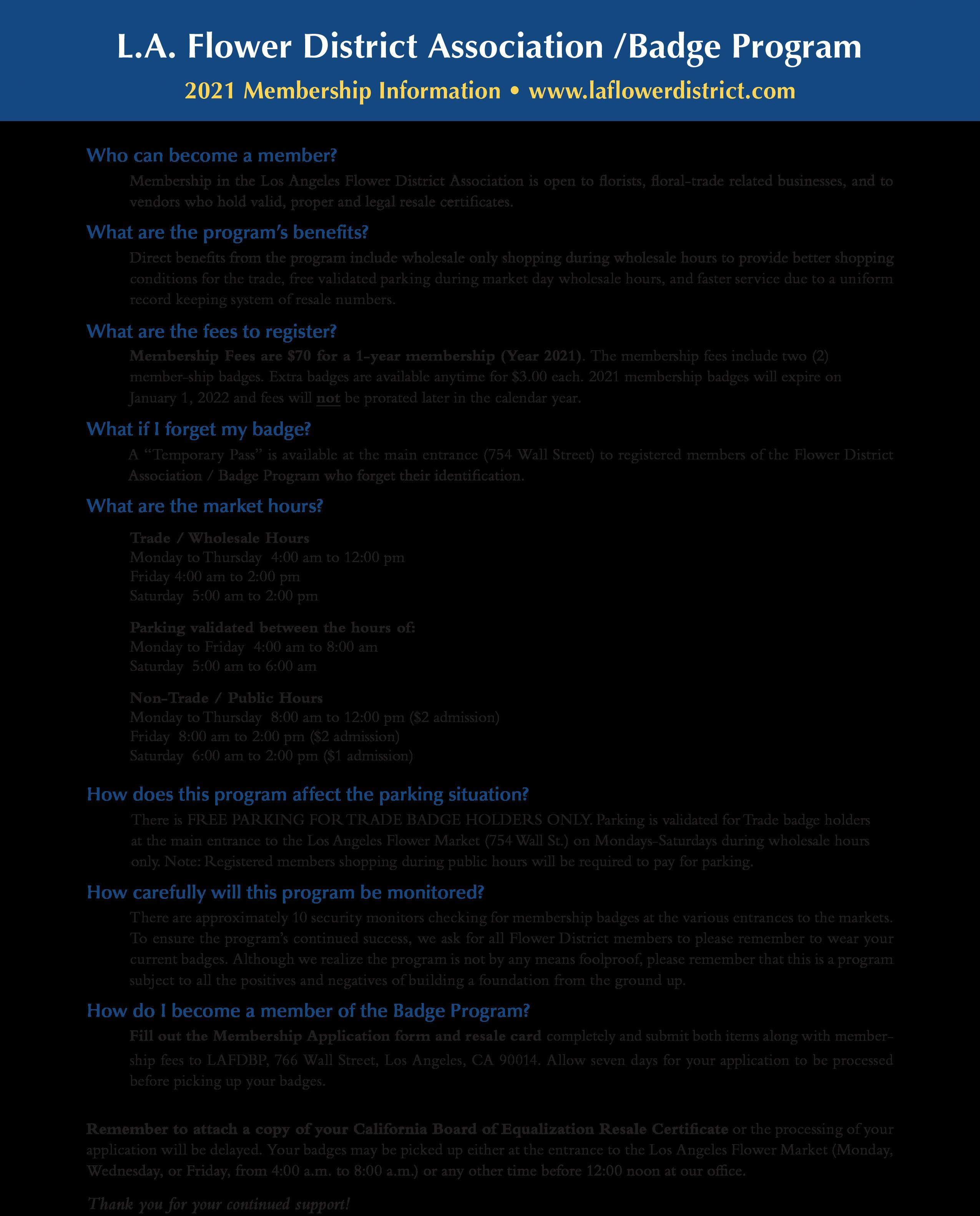
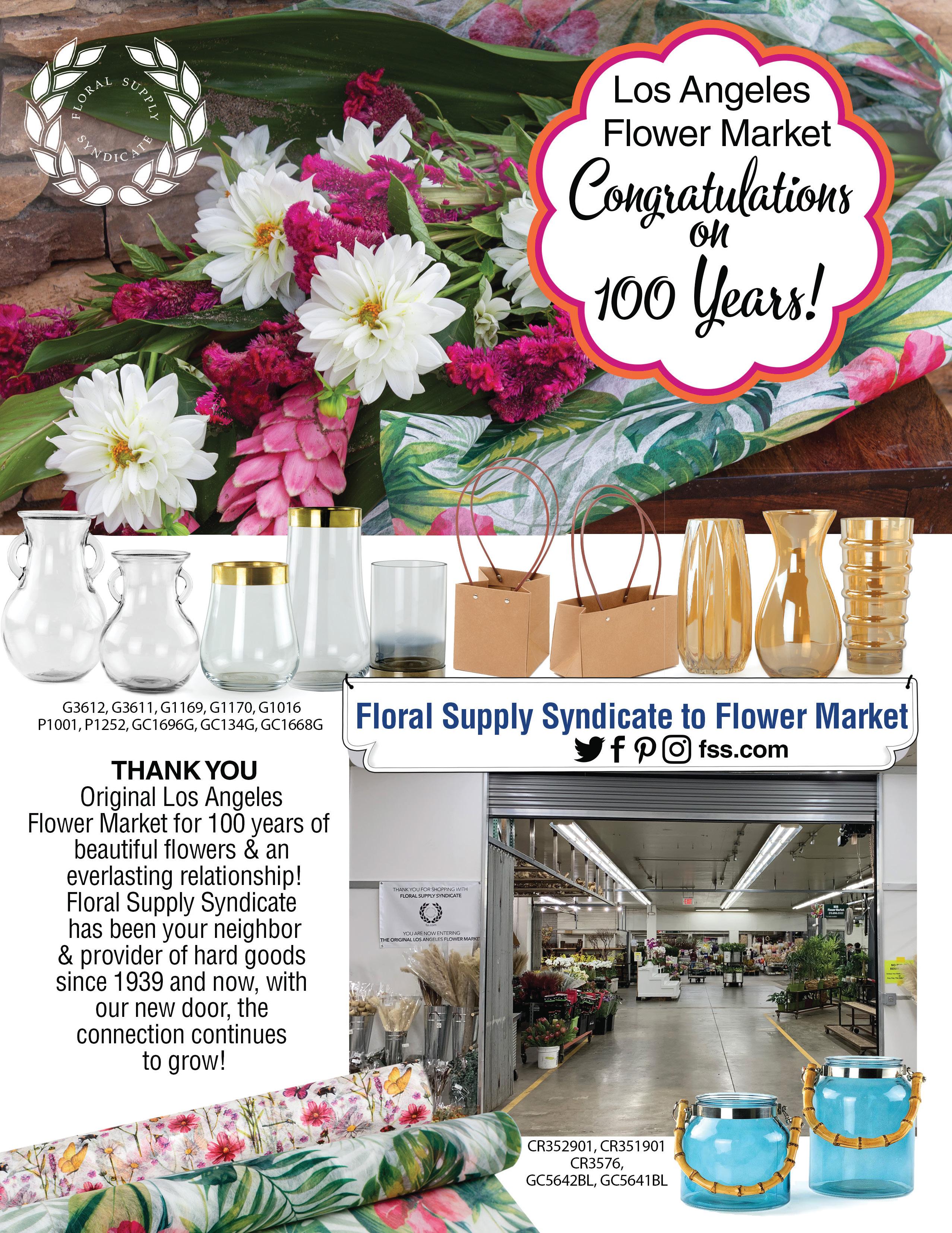
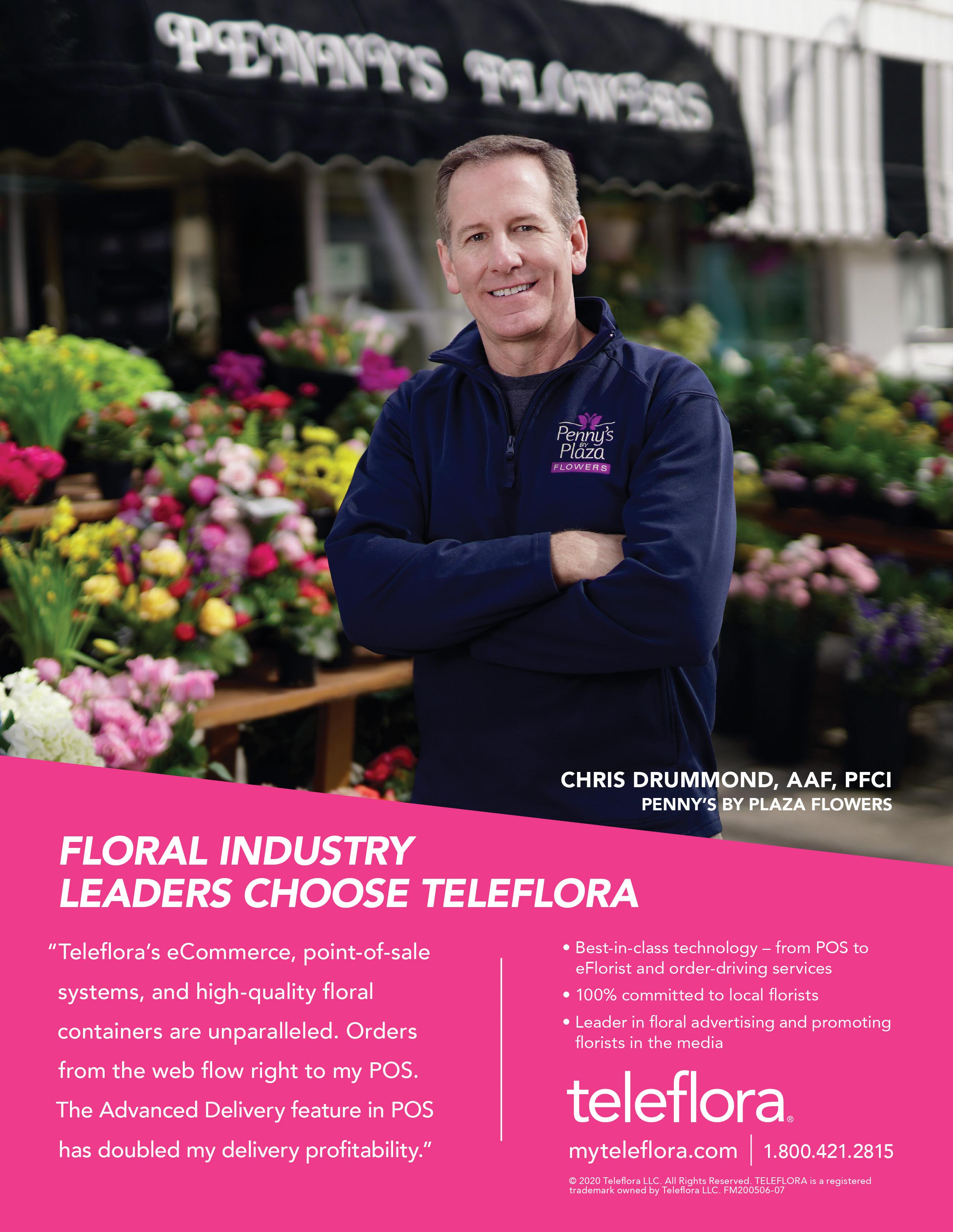
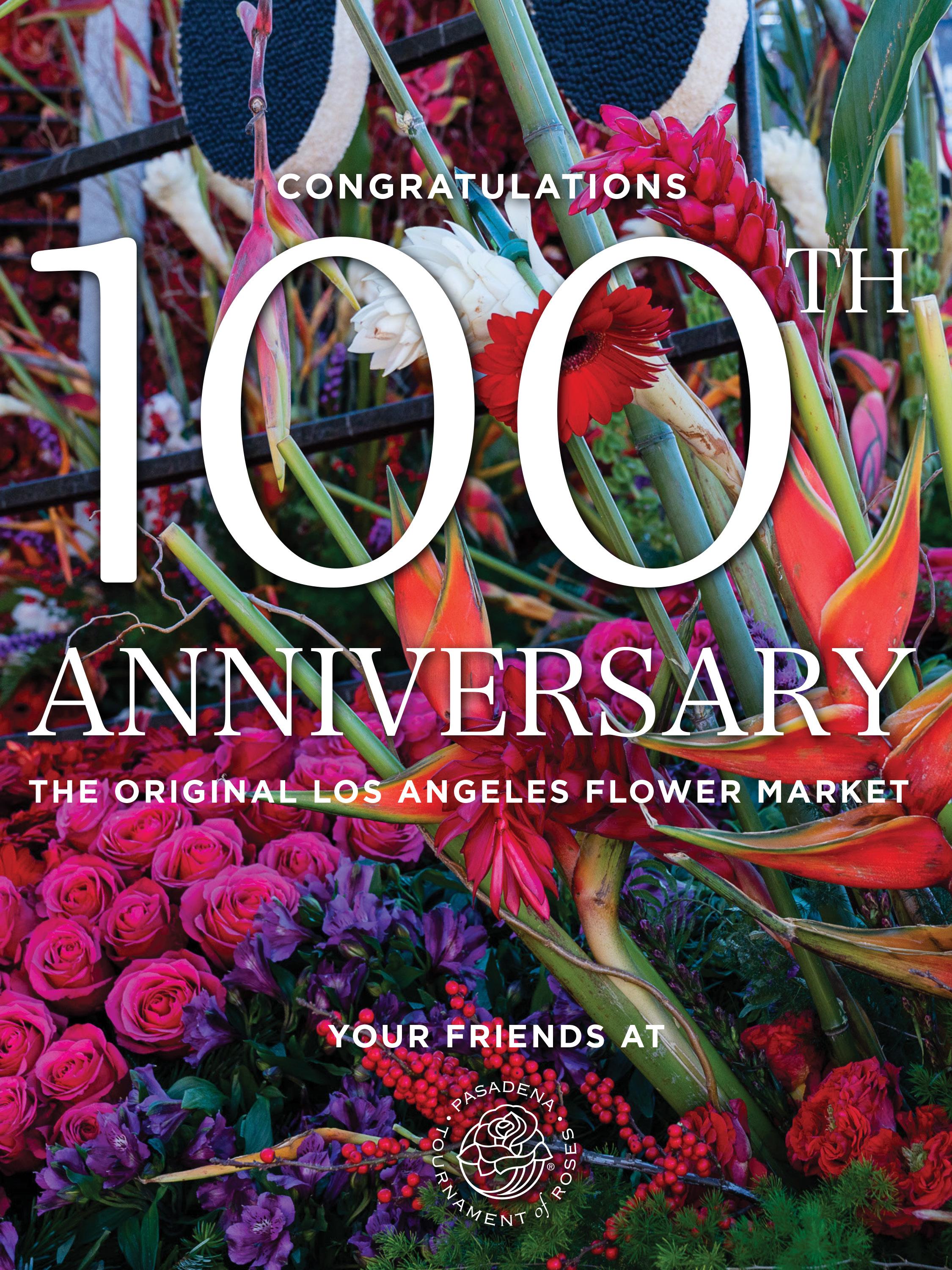














 LIZBETH ECKE President, American Florists’ Exchange
LIZBETH ECKE President, American Florists’ Exchange























































